It’s been about 50 days since I started testing the TomTom Spark watch (also branded as the Runner 2). These were TomTom’s new entrant into the market by combining an optical HR sensor with music and GPS tracking capabilities. In many ways the core of the unit isn’t super different than past GPS watches from the company, yet at the same time it makes those slight but important additions that make it incredibly competitive – especially in the mid-range running watch category.
For this review TomTom provided me a final production unit back in late October. Additionally, I also purchased my own TomTom Spark unit as well to test. My testing has been on a mix of both of those units, and following this review I’ll return the media loaner to TomTom like normal. That’s just the way I roll.
Unboxing:
The Spark comes in a bunch of different variants, though the internal packaging is actually the same on all of them (unless you get the headphones). That’s because it’s only the innards that differ between the different models. Externally of course on the box it’ll say which model you’ve got. For example, on this music one, you can see it lists music as a feature – but for this model I bought, it didn’t include the headphones (that’s a different bundle).
Next, note there are different sizes, which is just the wrist band. The pod that goes in the wrist bands are all the same. And remember, it also could be named differently too (Runner vs Spark). In any case, the box:
Inside the box there aren’t really too many pieces. You’ve got the watch, the charger, and a chubby little manual:
The charger is actually different from previous generations. It’s less plump, and is a bit more aero. Thus, it won’t work with previous TomTom watches. The cable both charges and allows download to Mac/PC. But of course you can also download via your phone (iOS/Android).
Next, with the watch it comes as a little pod that fits into the wrist strap. Because the pod is a bit different, it’s not compatible with older TomTom straps. You can get different colored straps, as well as different sized straps.
You navigate through the menus using the little joystick thingy at the bottom. The screen is NOT a touch screen.
Meanwhile, if you flip it over you’ll see the optical sensor on the back. Obviously, if you didn’t buy the version with an optical sensor then you’ll just see a black backing.
Finally, the manual. It’s super-chubby, but actually doesn’t have a lot of content in it. Rather, you can use it to learn how to plug in a USB cable in 48 different languages.
With that, let’s talk size.
Size & Weight Comparisons:
First, you’ll notice that the TomTom Spark (blue) is a bit slimmed down from the TomTom Cardio (red) units. Not so much the pod itself, but rather the strap. The strap lost the thicker edging and also just some of the bulk.
They also have a pile of different colors/combos:
This thinner strap translates into lost weight as well. If you look at the TomTom Spark, it comes in at 51g (for the version with the optical sensor & music):
However, if you have the black strap, you’ll save a bit of weight – it’s only 47g (45g for the small strap):
The pod itself is 35g, though you can’t very well run with just that.
Meanwhile, the older TomTom Cardio comes in at 63g:
For reference, a few other watches’ weights:
Garmin FR225 (optical): 53g
Garmin FR235 (optical): 40g
Garmin FR620 (non-optical): 42g
Next up is size. Here’s a round-up of most of the more popular current generation GPS watches on the market, and how things look size-wise. The TomTom Spark is 2nd from the right, in the blue configuration. Like in real life, it appears slightly slimmer when you go with the black strap.
Left to right: Garmin Epix, FR920XT, Suunto Traverse, Suunto Ambit3 Peak, Polar V800, Garmin FR225, Garmin FR630, Garmin FR235, TomTom Spark, Garmin FR25
And here’s the depths of them. The rolling pin is held level (by two 9V batteries), thus allowing you to see the height between the table and each watch face).
Ok, comparison time is over. Let’s start using the darn thing.
Basic Overview:
For those that have experience with past TomTom GPS watches, it’s probably easiest to know that outside of the new feature areas – almost everything else remains the same. Meaning, only these four things have changed:
A) Activity Tracker Added
B) Music Storage/Playback via Bluetooth Added
C) Optical HR sensor changed
D) Smaller/thinner strap than Cardio version
Virtually every other function of the watch remains the same as its predecessors. About the only minor menu shift you’ll notice is that they’ve moved the two secondary data fields from the top of the screen to the bottom of the screen.
Now, that’s not to say that there aren’t backend changes – because there are. The company has completely revamped their web platform in a shift off of MapMyFitness to a self-hosted site. Those changes will start to become more evident in the coming months as they shift from ‘duplicating existing format’ mode to ‘new features’ mode.
Of course, in the meantime there are certainly new features like the ability to see step tracking and distance walked each day.
For those unfamiliar with the watch, it’s probably good to start by knowing there are a bunch of different versions of the device:
TomTom Spark GPS Watch: €149/$149USD
TomTom Spark Cardio GPS Watch: €199/$199USD
TomTom Spark Music GPS Watch: €199/$199USD
TomTom Spark Cardio & Music GPS Watch: €249/$249USD
TomTom Spark Music GPS Watch with Bluetooth Headphones: €249/$249USD
TomTom Spark Cardio & Music GPS Watch with Bluetooth Headphones €299/$299USD
What’s notable here is that all versions of the TomTom Spark are multisport, unlike the past where they had a dedicated runner and a separate multisport version. Basically, to summarize, you’ve got these core features that you’d pick from/add:
GPS Multisport (all watches)
Music via Bluetooth in Music versions (option)
Optical HR in Cardio versions (option)
All versions have activity tracking, and all versions have multisport capabilities (running, cycling, pool swimming). And all versions support connecting to Bluetooth Smart Heart Rate Straps and Speed/Cadence sensors. Whereas the Cardio versions also add an optical HR sensor, and the Music versions allow you to playback music stored on the watch via Bluetooth audio headphones.
Got all that? Good.
The Optical Sensor:
Probably the most important thing to know about the internals of the watch compared to past TomTom units is that they’ve swapped out the optical sensor for a different brand. Readers will remember I’ve been a bit nervous about this, since the brand of optical sensor in fitness watches is the most important thing between a crappy accuracy and rock-solid accuracy. The differences in optical sensor quality is vast, and in general, most suck.
In TomTom’s case they went from licensing Mio’s optical sensor technology, to utilizing a previously unheard of company called LifeQ. This would be LifeQ’s first product on the market. Note that technically LifeQ is more about the software than the hardware. They essentially guide companies (like TomTom) through a package of hardware (optical sensor components), and then layer in their software algorithms.
Since I wrote up a bit about them in my preview post after I visited TomTom’s headquarters and had a conference call with the LifeQ team, I figure much of those few paragraphs are relevant here too.
The key theme when talking to TomTom about the Spark was really about them building a platform for the (or their) future. This was both on the device side, but also on the web platform. They noted that while cost of the LifeQ optical solution was certainly less than the Mio/Philips offering, it was actually the deeper integration and future potential that was the major driving factor. With Mio/Philips, the sensor was essentially plug & play – providing just heart rate as an output to the watch. That was great for the Cardio, and worked well. But they were concerned that long term it wouldn’t be as competitive as other companies added more and deeper features.
Whereas with the LifeQ solution they felt that they’d be able to get more ‘out of’ the solution. In discussing their roadmap during the conference call with LifeQ, I can’t argue with that approach.
To begin, LifeQ is a mostly South African based company that has offices in Atlanta and soon Boston & San Diego. At 70 employees strong, it’s certainly not four guys in a garage somewhere. Their focus is really on the bio-mathematical algorithms that are behind the sensor packages they put together. They don’t actually sell sensors, or hardware. Rather, they are mostly about algorithms and down the road, big data-esque type solutions.
That said, this is LifeQ’s first product. That’s both good and bad. On the obvious-bad front, it means that they lack the real-world user usage that can only come with deploying thousands of units. No amount of studies or test runs (no matter how many years they’ve done them) will replace that.
On the flip side (the good side), with what is effectively one customer (TomTom) deciding their future as a company, they’re incredibly motivated to ensure they get it right. They noted they really wanted to partner with TomTom, versus various knock-off brands seen across the CES floor, due to TomTom’s specific baseline requirement that it be just as good (or better) than the existing Mio sensor (in their current Cardio lineup). The agreement between LifeQ & TomTom is not exclusive, and LifeQ certainly sees a world of potential partners down the road outside of TomTom.
As I alluded to earlier, LifeQ doesn’t make the sensors. Instead, they take off the shelf components and put forth reference designs to companies like TomTom. TomTom could, if they wanted to, come to LifeQ with a preferred set of chipset and sensor partners, but in this case they let LifeQ run with what they specialized in (a wise move). As such, the TomTom Spark uses an multi-wavelength PPG (photoplethysmography) optical sensor from Osram (the SFH-7060). That sensor includes 1xRed LED, 3xGreen LED, plus a single IR sensor. That set of multicolor LED’s helps them to ensure greater accuracy across more skin tones. For example, some companies (i.e. Valencell) use a yellow LED in addition to the green. LifeQ specifically selected the red over yellow, because it would give them more flexibility down the road for blood oxygenation levels.
You can clearly see the different colored LED’s here. The 1xRed LED to the left, the 3xGreen LED’s in the middle, and then the IR to the right.
Next, they layer in a Texas Instruments AFE 4404 to manage the optical sensor, before calling it done on the hardware layer. Now it’s really important to note that the firmware that LifeQ has is probably more important than the sensor set selected. Meaning, just because you have a good sensor does not mean you have good data. The hard work is taking that raw data stream and making something pretty out of it. An area that the vast majority of optical sensors within cheaper fitness products today hose up.
As I noted numerous paragraphs ago before we got distracted on company background, a significant reason they selected LifeQ was for the future expandability. For example, LifeQ is able to measure RR, and then calculate HRV (while resting). Further, they’re able to calculate VO2Max and VO2 (continuous). And down the road they’re able to measure lactate threshold, sorta similar to BSX. All features that could make their way into the TomTom Spark through firmware updates.
Right now TomTom has committed to getting VO2Max and the recording of HRV/RR data into the .FIT files by early next year. Whereas features like oxygenation levels and lactate threshold probably aren’t on the near-term update list for TomTom, even if LifeQ is able to deliver them. I’d suspect that any inclusion of those features would probably target a different (more advanced) user audience than the current TomTom watches aim for. Fwiw, you can actually dive into many of LifeQ’s white papers on their site. Obviously it’s biased in that they’ve published it, but still interesting nonetheless.
Now how did all this optical sensor talk play-out in real-life after about 50 or so days of usage? Let’s dive into it.
Running:
To start with the watch, we’ll start with running. But there are a number of sport modes you can select (on all versions), they are:
Running (GPS on, for outdoors)
Treadmill (GPS off, for treadmill)
Cycling (GPS on, for outdoors)
Indoor Cycling (GPS off)
Swimming (GPS off, for pools only)
Gym (GPS off, for indoors)
Freestyle (GPS on, for whatever the heck you want)
Stopwatch (when you’ve simply given up)
All of these modes then show the type of workout later on while online. But again, in our case, we’re going running:
At this point it’ll find satellites and also acquire your heart rate via the optical sensor. If you have a HR strap, it’ll talk to that instead (if configured as such). Note that the unit does NOT support any footpods.
I found that as long as I connected the watch to the TomTom platform, it downloaded the GPS quick-assist database, which enabled it to find GPS satellites in under 10-15 seconds virtually every time. You can validate your quick assist information is up to date by pressing down from the main screen:
In running mode, you can change different training options. These are:
None (basically free mode)
Goals (Run towards a set distance, time, or calorie goal)
Intervals (Run a structured interval workout)
Laps (automatically triggered laps for time, distance, or manual)
Zones (Set a range to stay within for pace, speed, or heart rate)
Race (Race against a historical activity, a standard distance, or a custom distance)
The vast majority of my time with the watch I was in either ‘None’ mode (free mode) or running intervals.
Before we start running, you can slightly configure data screens. Specifically, you can configure the two metrics along the bottom to stay put with fields of your choice.
The main (bigger) screen simply will iterate through all of the metrics as you press the buttons.
The metrics that are shown are: Clock, Duration, Distance, Pace, Avg. Pace, Speed, Avg. Speed, Calories, Heart, HR Zone.
Again, for the metrics above, you press up/down to change the main field. The two smaller fields do not change. You’ve also got three different graphs related to HR that’ll show up when you press to the right. These are not customizable.
Once you’ve selected a mode, you’ll go ahead and begin the timer from the main running screen. At that point it starts recording and you should start running.
As you run, the metrics will display showing your current status:
One of the most common questions on GPS watches is pace stability. In my case, I’d give pace stability a good but not great rating. It mostly kept my pace stable, but did seem to wobble a tiny bit more than other GPS watches I was using at the same time (Suunto Ambit3, Garmin FR920XT). Not enough that it was a deal killer, but just a tiny bit more.
Within the interval mode, you’ll configure the interval portions such as work, rest, and warm-up/cool-down. These can be set for time or distance:
Then, while running the interval it’ll keep you on track with which set you’re on (i.e. Set 1/4).
However, the interval mode does not specify *what* to do for each section. Meaning, it doesn’t tell you to run X pace, but instead just that you need to run Y time/distance. So it’s not as advanced as some units.
Also, to my disappointment the interval mode doesn’t take advantage of the Bluetooth headphones to announce that an interval is about to start (or your finishing splits). I asked TomTom and they said that’s coming down the pipe though.
So what about GPS accuracy? Well in general, things did quite well. Here’s a run-down of my activities and the different watches I was using and distances:
TomTom Spark GPS Data
| Date | Type | TomTom Spark | Other Unit #1 | Other Unit #2 |
|---|---|---|---|---|
| Nov 15th | Bike | 25.56 | 25.66 (Edge 520) | 25.61 (Edge 520) |
| Nov 14th | Run | 11.41 | 11.21 (FR920XT) | 11.21 (FR630) |
| Nov 14th | Run | 6.19 | 6.20 (FR620) | - |
| Nov 12th | Run | 7.62 | 7.32 (FR235) | 7.21 (920XT) |
| Nov 8th | Bike | 27.12 | 27.29 (Edge 520) | - |
| Nov 7th | Run | 10.93 | 10.91 (FR920XT) | - |
| Nov 5th | Run | 5.55 | 5.54 (FR920XT) | 5.56 (Ambit3) |
| Nov 3rd | Run | 6.04 | 5.99 (Epix) | 6.06 (Ambit3) |
| Oct 28th | Run | 5.00 | 4.90 (Epix) | - |
| Oct 20th | Run | 8.34 | 8.35 (FR25) | - |
| Oct 10th | Run | 7.08 | 7.04 (Epix) | - |
| Oct 6th | Run | 6.52 | 6.46 (Epix) | 6.46 (Ambit3) |
| Oct 1st | Run | 3.69 | 3.58 (Epix) | Note: Trail Run |
| Sept 30th | Run | 5.78 | 5.75 (Epix) | - |
| Sept 26th | Bike | 29.28 | To be found | - |
| Sept 24th | Run | 6.07 | 5.93 (FR920XT) | - |
(Note: I’ll put all of these files up in a ZIP file in the coming days for you to download, just compiling them all and wanted to get the review up for you in the meantime.)
In general, I’m interested in cases where a given unit is substantially different than others. And if so – why. Of course, I’m always looking at GPS tracks, because it’s quite possible for both units to have the same end-GPS distance, but with equally horrible tracks.
In the majority of cases, the TomTom tracked very well. Still, there were a few odd ducks that I checked into. For example, on Nov 12th it showed a pretty big difference for a hill repeat run I did in the city. In poking at it, I actually don’t see an obvious explanation there for being so much shorter (1/3rd of a mile). Only the Suunto Ambit track looks problematic (a rarity for it):
Looking at some of the other big difference activities:
Nov 14th: Spark somehow misaligned one of my loops by a few city blocks (see below)
Oct 28th: 5.00mi (Spark) vs 4.90mi (Epix): The Epix cut corners in the city, Spark was correct.
Sept 24th: 6.07mi (Spark) vs 5.93mi (FR920XT): No obvious differences between track, rather odd (see below)
For example, below is the Sept 24th one, while the purple track shows it going into the water, it’s still parallel where I ran (just offset perhaps 10-20m for a brief chunk). Obviously, not ideal, but also doesn’t account for the gap of .14 miles.
On the Nov 14th run, it did some super-wonky satellite shift on one of my loops around that area. You can see I was doing loops between two bridges, and for some odd reason, it shifted one of those loops west a ways, causing a spike in mileage. Oh, and the FR920XT going waterborne? That section is actually underground, so something weird happens there. The TomTom, Suunto, and FR235 did handle it well (I’d say about 80% of the time units get it right).
My running turf for this test period included mostly open-sky running along the beach in Mexico, extensive city running in Paris, mountain/forest running in Alberta (Canada), and some trail running in Delaware (US).
Overall, outside of calling out these specific oddities, the unit actually did perform pretty well. I know it’s easy to look at just the odd duck cases, but do pay attention to the entire table – since it shows that in general, despite challenging conditions (mostly city running), it held its own.
Lastly, but most importantly – the optical sensor accuracy. In my testing I found that it did good, but not great. Specifically, as the weather cooled in the last few weeks, I saw issues where the first few minutes (usually 3-4, but in one case as long as 9 minutes) the unit struggled to accurately display my HR. It would always undercut my actual HR in these initial minutes. Once it locked onto my HR though, it almost always nailed it for the rest of the session – no matter what wonkiness I did running pace-wise. Once past that point, it tracks along with the three other HR sensors I was wearing, no problems.
Here’s another example of cooler weather runs. Note, that none of these were terribly cold – about 50-55°F (10-13°C). The TomTom Spark briefly had problems in the first two minutes where it dropped low (blue). The green line you see all wobbly is where the Scosche managed to catch the Velcro on my t-shirt and pulled off and I hadn’t realized it for a moment, so it’s wobbly until I fixed it. That’s more of a ‘me issue’ than a ‘them’ issue.
Here’s another run, where the unit has trouble during first few minutes finding lock. But once it finds it – boom, good to go! Though, you see one brief blip at the end of the 5th interval.
In warmer weather I saw no issues at all with the optical sensor in the first few minutes. For example, this run here I only saw one tiny segment of a few seconds where it diverged. It’s entirely possible that I had adjusted the band at that moment for something.
Another example here, where the two units tracked near perfectly. You see the Scosche ramp up a few seconds slower this morning than the TomTom, but nothing appreciable. Towards the end you see the TomTom briefly dip for a few seconds, but again, only by a few BPM.
Next, a lukewarm run in the Canadian mountains. Again, near identical. You see two random drops of 0BPM data on the Garmin Epix. Not sure what that’s all about.
Finally a nice fall run in Delaware, where the temperatures dropped as sunset approached, but not overly cold. You can see it near perfectly matched the other HR sensor (and actually tracked slightly better in the first minute or so).
So ultimately, the HR sensor is pretty good for running, with some minor caveats that it seems a little more susceptible to the first few minutes getting warmed up, than some other sensors out there. Not a deal-breaker, but something to be aware of.
Note that optical sensors in general struggle on your wrist in cooler weather. The TomTom Spark probably would have gotten a better review had I posted two weeks ago, since the weather was largely warmer then and didn’t manifest itself until cooler weather. I’d note though that many units struggle here. For example, I saw similar issues a year ago with the Mio Fuse during the winter (albeit much colder weather).
Cycling:
The TomTom Spark has a basic cycling mode that enables you to support cycling sensors (the speed/cadence sensor), as well as displays your metrics in speed (MPH/KPH) rather than pace. Further, it helps to automatically identify those activities later when looking at them via the app or website (or to 3rd party sites).
To select the cycling mode, simply choose it from the list when you press to the right once:
Additionally, you can also use the indoor cycling mode, which disables the GPS and relies on a Bluetooth speed sensor for distance/pace. This sensor is not required however, so if you were to just join a spinning class you could still just have it categorized as indoor cycling.
To pair the speed/cadence sensor, you’ll go into the sensors menu within the watch. It’s super basic, and you can’t save multiple sensors if you have multiple bikes:
In my case, I tested it with the Wahoo BlueSCv2 (which is dual ANT+/BLE), it worked just fine.
Whether indoor or outdoor cycling, you may end up mounting your watch to your bike (such as with this simple $10 adapter). In doing so, you’d obviously lose optical HR since it would no longer be on your wrist. So in lieu of that you can pair to a separate Bluetooth Smart heart rate strap.
This allows you to still display/record HR, even when it’s not on your wrist.
Using a strap may be a good idea anyway while cycling, because in my testing the optical HR hasn’t been very accurate while wearing it on my wrist riding. This wasn’t a huge surprise to me, as most (but not all) optical HR sensors worn on one’s wrist struggle here. For example I’ve seen lackluster cycling optical HR performance with the Apple Watch, Fitbit Surge, Microsoft Band (1 & 2) and Samsung Gear Fit. Meanwhile, I’ve generally had good luck with the Mio Link on my wrist from a sensor standpoint (while I usually wear the Scosche Rhythm+ optical HR sensor, it’s not for one’s wrist).
I’ve also tried it on the inside of my wrist, which is usually a much easier way to get accurate results as it’s a bit more ‘fleshy’ and not as bony. In this case, no such luck:
For example, in the below you’ll notice the first 25% of the ride it has me just wandering along at 110-120BPM. In reality, I’m where the Scosche has me at 140’s. Then, it locks on for a while, before eventually having quite a bit of trouble the rest of the ride.
Yet on a different ride this weekend, it actually tracked quite well for perhaps 80% of it, but then had a really tough time in a few key chunks:
Indoors, I saw no problems at all with optical HR tracking – it tracked beautifully there:
Ultimately, I’m not really sure where to place HR accuracy here in terms of cycling. I think it’s basically just a crapshoot while outdoors.
(Note: All of the charts in these accuracy sections were created using the DCR Analyzer tool. It allows you to compare power meters/trainers, heart rate, cadence, speed/pace, GPS tracks and plenty more. You can use it as well, more details here.)
Swimming (Pool):
The TomTom Spark (all versions) includes the ability to track your pool swims. It DOES NOT track openwater swims. It has no openwater swim mode, though some people have used existing TomTom watches in the ‘Freestyle’ mode with mixed success.
Further, in Swim mode, the optical HR sensor is not enabled. TomTom says that perhaps down the road if testing pans out, they’ll enable it. But today, when in swimming mode it’s disabled (but I’ll show you what happened when I tried it anyway).
First up, to get into the swim mode you’ll go ahead and select the ‘Swim’ mode.
Before you press start though, you’ll want to configure your pool size by clicking down to ‘Settings’, and then selecting ‘Pool Size’. I had pictures of all of this in the pool, but they came out looking downright horrid. See:
It’s here you can specify the exact number of meters or yards your pool is. You’ll first select the numerical length, (both whole and partial numbers), and then meters or yards. Super easy.
The configuration options in terms of training are super-limited, and honestly kinda wonky. For example, if you want to configure sets, you have to do so using ‘Laps’. Except within the distance option for laps you’d do so in miles or kilometers. For metric folks, miles isn’t too bad (though, for my 33 1/3m length pool – it can still be tricky). But miles is just a mess for folks swimming in pools measured in yards.
In any case, with all that set, it’s off to start your set by pressing go. Once you start swimming you can view the following metrics:
Available Swim Metrics for Main Screen: Lengths, SWOLF, Strokes, Calories, Avg Speed, Miles, Duration (Time Elapsed), and Clock Time
Further, you can configure two metrics along the bottom, such as distance and time.
Now frustratingly (more mind-boggling actually), you (still) can’t display yards or meters. Who on earth shows their swim workouts in miles? Nobody. That’s who. Yes, I know, for metric folks you could see meters. But I’d bet that TomTom sells more of these watches in the US than Metric countries, so it would seem halfway logical to offer both (like every other swimming watch).
In any case, as you swim these metrics will update in real time – typically at the end of each pool length. As is the case with all swimming watches, it works both with flip and open (non-flip) turns. However, like most swimming watches you’ll want to ensure you press off the wall crisply. These watches work by measuring acceleration, and unexpected (or lack of) changes to that can cause problems for all companies.
Afterwards, online you can see your splits from the swim session, divided up by lengths:
Now in my testing, I found things mostly good. It made one lap error on a recent swim, missing a turn/length, where the FR920XT didn’t miss that length. To be fair, that was the same length that I totally whiffed the wall and basically just did a flip turn sans-push. I’m not going to hold that over the TomTom’s head. Note in the above case, I split the workout into two pieces – one without HR, and then one below with HR.
Which brings us to the HR piece. In this case, I just put the watch into a generic mode, called Freestyle. In this mode it records your HR, but doesn’t record swim metrics. So it won’t capture aspects like lengths, distance, or the fact that you were swimming. It just captures your HR.
I then set out for a short set to see how well it’d track. I had actually also worn the HRM-SWIM from Garmin to compare HR’s, but somehow that accidentally got into drill mode and oddly I learned it doesn’t record HR data in drill mode. So, I have just the TomTom data, but honestly, I can pretty much walk you through the accuracy there.
I basically did 6 lengths with it, with the first two lengths at an easy pace, and then the next two lengths springing, and then final two lengths back to an easy pace:
Obviously, the Spark sensor didn’t get the memo. It appears that it was entirely lost for the first two thirds, but seemed to actually find the plot for the last two lengths, as that HR would be more akin to what I was doing the rest of my swim per the HRM-SWIM.
Now again, TomTom doesn’t advertise they can do this. In fact, they purposefully turn off the optical sensor in swim mode. So this is more of a curiosity test than anything else. Further, optical sensors in the water can be finicky in that it might work for someone else, even if it doesn’t work for me.
Activity Tracker Usage:
Yes, the TomTom Spark has an activity tracker in it – like every other connected watch made in the last 12-18 months. But how they implemented it is both different and sorta intriguing. Parts of which I love, and parts of which I hate.
First up – obviously, it counts steps. It does this anytime you’re wearing it – so that you can see how many steps you walked as well as how far you’ve walked (or ridden) in total each day.
This steps page is accessible by tapping the left button, which changes the display to the activity tracker pages.
While this sounds like it’s pretty innocuous, it isn’t. See, it’s slow. Every time I tap I have to wait a few seconds for the screen. There’s lag, and that’s annoying. But more than that – is the fact that I just can’t see my darn steps on my home screen. I don’t care to see the clock in gigantic letters. I’d rather see my steps or progress towards my goal somewhere on the screen, with the clock a bit smaller. You know, like every other activity tracker on earth.
So what does TomTom do different that I DO like? Well, they’ve somewhat shifted away from the idea that you’re going to have a perfectly even daily step count. And instead overlaid a bit of a 7-day step goal. The idea being that for various reasons you might have a lower Monday but then make up for it on Tuesday. For the non-active person that might sound like a bad idea. But for the athlete trying to recover – that’s actually exactly what you want. It helps to even out those rest and peak days.
On the steps, the numbers seemed to be in the same ballpark as those of the Withings Activite. As usual with activity trackers, each company tends to do a bit different when it comes to algorithms, so I wouldn’t overthink minor differences like 5% or so.
One minor thing to note is that the distance travelled pages of the activity counter do include cycling. So if you do that, it’ll probably skew your step/walking mentality a bit.
Next, is sleep. The unit tracks sleep in basically the same manner as steps – on both a daily and running total:
I found the numbers pretty much matched what I got from the Microsoft Band 2 and the Withings Aura. All of this is then uploaded to the TomTom MySports site, via either the desktop uploader or the mobile phone app. Note though that neither connect to Apple Health, though TomTom says that’s on the way.
Music Playback:
The TomTom Spark is one of the few GPS watches out there that has storage for music, as well as Bluetooth playback. You must have Bluetooth headphones to playback the sound, as there is no headphone port (that would impact/limit waterproofing levels).
You can buy a bundled TomTom Spark that includes headphones, or you can purchase your own. If you buy the bundled version, you’ll get these ones below:
They look a little…bulky…but in reality I’ve found they actually work really well. In fact, I’d say just as well as some of the different test headphones I’ve bought that cost $130-$180USD. But more on that in a second.
The headphones have two buttons on them, and charge via micro-USB. The buttons allow you to control audio volume, and change the power/pairing state. To do so you’d hold down the middle button till it goes crazy blue/red flashing. When it comes to pairing, you’ll do that before you start your run, by pressing up to launch the pairing screen:
Then, once you go to start a run it’ll search for your powered on headphones. I’ve found this to occasionally be kinda finicky, most notably with 3rd party headphones. I’ve always gotten it to work, but sometimes it takes a few tries before it finds its headphone friends.
You can play music without going into a running mode, so you can basically just use it as a wireless music player whenever you want, as seen below:
Once connected, you’ll see a headphone icon along the top of the screen:
You can increase/decrease the volume using the two +/- buttons. Further, you can pause/resume the music using the middle button. You can also long-hold the volume buttons to skip ahead/back on songs.
The music starts playing pretty much immediately, and then once GPS signal is found, it’ll audibly tell you that too.
While running (or riding I suppose – though that’s a bad idea safety-wise), I’ve found it best to wear the watch on the same side as the headphone transmitter. In the case of the TomTom headphones, this is the left side. This ensures consistent signal and reduces drops. This behavior is similar for other GPS watches I’ve tested that have Bluetooth headphones. Essentially, range is a bit limited.
In a left & left configuration, I’d rarely get music drop-outs while running. About the only time would be if reached my left hand over to my right hand to do something (i.e. press buttons on another watch), I’d see a slight drop in audio for a moment before resuming.
Using the TomTom headphones, I found audio quality just fine (you’re running and breathing hard; this isn’t a concert hall with finely tuned audio characteristics). I quite honestly can’t tell much of a difference while running between those headphones and the far more expensive options.
For 3rd party headphones, the TomTom Spark supports any Bluetooth audio device. So it technically doesn’t have to be headphones, it could be a Bluetooth water bottle or Bluetooth speaker if you want. But, they (and other readers) have found that certain brands implement the BT specification better (or worse) on various models. TomTom has outlined all of those models here.
In my case, I picked up three different headphones. I polled DCR followers on Twitter back two months ago on their favorite Bluetooth running headphones, and then picked up the two (very pricey) options. I also then picked up a much cheaper ($20) option that was highly ranked on Amazon (like 2,000+ reviews) and suggested a few times by some readers:
– Jaybird X2’s
– PowerBeats2 Wireless
– Mpow Swift BT4.0 Headphones
I’ve tried running with all three of these over the past 45 days, and all worked well. All had good quality audio while running, and none dropped out any more than the TomTom units did (which was rare).
So why is a $20 pair just as good as a $170 pair? Well, I think it’s partly just marketing and partly environmental. If I were to sit in a quiet room listening to music, yes, the Beats and Jaybird sound better. No question. But, when I’m out running I’ve got my breathing, wind, traffic, and all assortment of other noise. And just the fact that I’m not concentrating as much on the music quality anymore. So it’s simply not as important.
Note my goal here isn’t a headphone review; I’m not really in that realm right now – so it was more validating they worked with the TomTom unit. If I were to return them all, I’d probably just keep the TomTom ones. They fit well (just as well as the expensive options), and the quality was good enough for me.
What is important though is that you find headphones that fit. If they don’t fit then the experience and the quality will suck. Most headphones come with various buds or wings that you can swap out to find your ear size. It’s super important to do that.
But, all that said – unless you already have a pair of wireless headphones, I’d honestly just get the bundled TomTom version. Mostly because you won’t have to worry about compatibility issues, and if there’s a problem – you have one chicken to choke: TomTom. There won’t be any blame passing.
On capacity, the unit holds 3GB of music files. It comes preloaded with a play list of 11 songs that actually aren’t too bad. A bit of a running focused playlist. If you have Spotify, I’ve created a Spotify playlist of the songs here to check out.
Finally – note that the audio capability does NOT work underwater. Simply put, Bluetooth audio cannot transmit underwater, and since it’s transmitting via Bluetooth, that functionality just doesn’t work.
Mobile App & Website:
Obviously a big part of having a GPS watch is downloading that information for review afterwards. For that, TomTom offers two methods. First is via their desktop app that connects to your device via USB. This will then upload the data to the TomTom MySports site, as well as to third party sites like Strava and RunKeeper.
You can configure a vast number of 3rd party sites, as well as saving to standard file formats like .GPX, .FIT, .CSV, and .TCX. If your app doesn’t use one of these formats, you need a new app – as these are universally utilized.
These files will simply plop out into a desktop folder that you can upload to other services as you see fit.
Next up is the mobile app. This allows you to pair your phone via Bluetooth Smart and then upload workouts to the MySports site. Down the road, they’ll also setup backend connections to more 3rd party platforms so you don’t have to use the desktop uploader for all of those.
While I wouldn’t categorize the mobile app as the most category leading, it does seem to get the job done. You can view your activities pretty easily:
And you can also view your steps, sleep, and related metrics.
And for the most part, that’s it on the mobile app. Like I said, kinda bare bones, but ultimately it gets the core of things done.
Finally, we’ve got the website. Over the last 6 or so months TomTom has completely rebuilt the website from the ground up. It used to be that it was on MapMyFitness (platform), but now they’ve built what is basically a parallel version of that. From there they’ll be able to build out new features (something they felt they were limited on within the MapMyFitness realm).
Right now though, things are still pretty basic. To begin you’ve got your dashboard. This shows you steps for the current week, as well as for the day. It also below shows you all your activities and totals on the right side:
You can click on ‘Progress’ up top to get an overview of how much activity you’re doing, based on any of the different categories within the watch (i.e. cycling, running, general activity, etc…).
For most though, they’ll be cracking open an individual activity. So back on the main dashboard you can click on any given activity to dive deeper into it. Here’s one of my recent runs.
You’ll see it has summary metrics on the upper portion, and then splits along the left.
Down below there’s a graph that you can change/select the metrics for, by default it’s just pace and HR.
You can also select to show your HR zones for the run, which is a pretty nifty little graph:
In the event you’re doing a cycling activity, you’ll also get sensor information such as that from the cadence sensor. You can see that listed below. Also, you’ll see it for each split.
Finally, at the top of the page is the ‘Race this’ option, which allows you to race any given past activity, or some pre-created activities. This isn’t an area I poked at too much, since my workouts tend to be different in length/function each day.
Still, if you were to click the ‘Race This’ activity, it would add it to the list on the second tab under ‘Training’:
It would then also show up on the watch as one of the items you could race. Sorta like a Virtual Partner/Racer feature.
Finally, note that while I displayed everything in statute miles above, you can easily switch to metric (kilometers).
Product Comparison:
I’ve added the TomTom Spark into the product comparison database, so you can compare it against other models that I’ve reviewed or had hands-on time with. For the purposes of below, I’ve compared the TomTom Cardio (previous edition) with the TomTom Spark, and then threw in the Garmin FR235. That seems to be the unit most people are interested in comparing against. But you can customize the tables as you see fit here.
Speaking of which, I’ll have my Garmin FR235 In-Depth Review out next week, so stay tuned for that.
| Function/Feature | TomTom Spark | TomTom Multisport Cardio | Garmin Forerunner 235 |
|---|---|---|---|
| Copyright DC Rainmaker - Updated May 14th, 2021 @ 3:16 pm New Window | |||
| Price | $149-$199 (Features Vary) | $299 | $249 |
| Product Announcement Date | Sept 3rd, 2015 | APR 2, 2014 | Oct 21st, 2015 |
| Actual Availability/Shipping Date | October 1st, 2015 | Mid-April 2014 | November 2015 |
| GPS Recording Functionality | Yes | Yes | Yes |
| Data Transfer | USB/Bluetooth Smart | USB/Bluetooth Smart | USB, Bluetooth Smart |
| Waterproofing | 50m | ATM5 (50m roughly) | 50 Meters |
| Battery Life (GPS) | Up to 11 hours (varies) | 10hrs | Up to 16 hours |
| Recording Interval | 1s | 1-second | 1-second & Smart |
| Alerts | VIBRATE/SOUND/VISUAL | Vibrate/Sound/Visual | VIBRATE/SOUND/VISUAL |
| Ability to download custom apps to unit/device | No | No | Yes | Music | TomTom Spark | TomTom Multisport Cardio | Garmin Forerunner 235 |
| Can control phone music | No | No | Yes |
| Has offline music storage and playback | Yes | No | No | Connectivity | TomTom Spark | TomTom Multisport Cardio | Garmin Forerunner 235 |
| Bluetooth Smart to Phone Uploading | Yes | Yes | Yes |
| Phone Notifications to unit (i.e. texts/calls/etc...) | Yes | No | Yes |
| Live Tracking (streaming location to website) | No | No | Yes |
| Group tracking | No | ||
| Emergency/SOS Message Notification (from watch to contacts) | No | No | No |
| Built-in cellular chip (no phone required) | No | No | No | Cycling | TomTom Spark | TomTom Multisport Cardio | Garmin Forerunner 235 |
| Designed for cycling | Yes | Yes | Yes |
| Power Meter Capable | No | No | WITH SOME CONNECT IQ APPS (BUT CANNOT RECORD DATA) |
| Speed/Cadence Sensor Capable | Yes | Yes | Yes |
| Strava segments live on device | No | No | No |
| Crash detection | No | Running | TomTom Spark | TomTom Multisport Cardio | Garmin Forerunner 235 |
| Designed for running | Yes | Yes | Yes |
| Footpod Capable (For treadmills) | No (Can use internal accelerometer) | No (Can use internal accelerometer) | YES (Also has INTERNAL ACCELEROMETER) |
| Running Dynamics (vertical oscillation, ground contact time, etc...) | No | No | No |
| VO2Max Estimation | No | No | Yes |
| Race Predictor | No | No | Yes |
| Recovery Advisor | No | No | Yes |
| Run/Walk Mode | No | No | Yes | Swimming | TomTom Spark | TomTom Multisport Cardio | Garmin Forerunner 235 |
| Designed for swimming | Yes | Yes | No (protected though just fine) |
| Openwater swimming mode | No | No | N/A |
| Lap/Indoor Distance Tracking | Yes | Yes | N/A |
| Record HR underwater | NO (NOT ENABLED IN SWIM MODE) | No (not enabled in swim mode) | N/A |
| Openwater Metrics (Stroke/etc.) | No | No | N/A |
| Indoor Metrics (Stroke/etc.) | Yes | Yes | N/A |
| Indoor Drill Mode | No | No | N/A |
| Indoor auto-pause feature | No | No | N/A |
| Change pool size | Yes | Yes | N/A |
| Indoor Min/Max Pool Lengths | 15m-50m | 15m-50m | N/A |
| Ability to customize data fields | Yes | Yes | N/A |
| Captures per length data - indoors | Yes | Yes | N/A |
| Indoor Alerts | Goals only | Goals only | N/A | Triathlon | TomTom Spark | TomTom Multisport Cardio | Garmin Forerunner 235 |
| Designed for triathlon | Sorta | Sorta | No |
| Multisport mode | No | No | No | Workouts | TomTom Spark | TomTom Multisport Cardio | Garmin Forerunner 235 |
| Create/Follow custom workouts | No | No | Yes |
| On-unit interval Feature | Yes | Yes | Yes |
| Training Calendar Functionality | No | No | Yes | Functions | TomTom Spark | TomTom Multisport Cardio | Garmin Forerunner 235 |
| Auto Start/Stop | No | No | Yes |
| Virtual Partner Feature | Yes | Yes | No |
| Virtual Racer Feature | Yes | Yes | No |
| Records PR's - Personal Records (diff than history) | No | No | Yes |
| Tidal Tables (Tide Information) | No | No | No |
| Weather Display (live data) | No | No | YEs | Navigate | TomTom Spark | TomTom Multisport Cardio | Garmin Forerunner 235 |
| Follow GPS Track (Courses/Waypoints) | No | No | No |
| Markers/Waypoint Direction | No | No | No |
| Offline Maps | No | No | No |
| Back to start | No | No | Yes |
| Impromptu Round Trip Route Creation | No | No | No |
| Download courses/routes from phone to unit | No | No | No | Sensors | TomTom Spark | TomTom Multisport Cardio | Garmin Forerunner 235 |
| Altimeter Type | GPS | GPS (Barometric for Performance Bundle) | GPS |
| Compass Type | None | None | N/A |
| Optical Heart Rate Sensor internally | Yes | Yes | YEs |
| Heart Rate Strap Compatible | Yes | Yes (also contains optical HR sensor) | Yes |
| ANT+ Heart Rate Strap Capable | No | No | Yes |
| ANT+ Speed/Cadence Capable | No | No | Yes |
| ANT+ Footpod Capable | No | No | Yes |
| ANT+ Power Meter Capable | No | No | No |
| ANT+ Lighting Control | No | No | NO |
| ANT+ Bike Radar Integration | No | No | NO |
| ANT+ Trainer Control (FE-C) | No | No | NO |
| ANT+ Remote Control | No | No | YES FOR GARMIN VIRB |
| ANT+ eBike Compatibility | No | No | NO |
| ANT+ Gear Shifting (i.e. SRAM ETAP) | No | No | |
| Shimano Di2 Shifting | No | No | NO |
| Bluetooth Smart HR Strap Capable | Yes | Yes | NO |
| Bluetooth Smart Speed/Cadence Capable | Yes | Yes | NO |
| Bluetooth Smart Footpod Capable | No, has internal accelerometer | No, has internal accelerometer | NO |
| Bluetooth Smart Power Meter Capable | No | No | NO |
| Temp Recording (internal sensor) | No | No | NO |
| Temp Recording (external sensor) | No | No | YES (TEMPE) | Software | TomTom Spark | TomTom Multisport Cardio | Garmin Forerunner 235 |
| Desktop Application | MySports Connect | MySports Connect | Garmin Express |
| Web Application | TomTom MySports | TomTom MySports | Garmin Connect |
| Phone App | iOS/Android | iOS/Android | iOS/Android/Windows Phone |
| Ability to Export Settings | No | No | No | Purchase | TomTom Spark | TomTom Multisport Cardio | Garmin Forerunner 235 |
| Amazon | Link | Link | Link | DCRainmaker | TomTom Spark | TomTom Multisport Cardio | Garmin Forerunner 235 |
| Review Link | Link | Link | Link |
Again, remember you can customize the above comparison charts with any of the products I’ve had hands-on time with. You can do that here.
Summary:
In general, the TomTom Spark is mostly the same GPS watch you know and love from previous incarnations. It’s just that now it has activity tracking and wireless music playback support, with the music playback being the biggest differentiator to competitive units.
When it comes to the optical sensor, if I were a school teacher, I’d give it about a B+ for running, and about a ‘C’ for cycling. I recognize that despite its cycling mode, I don’t think it’s that much targeted at cycling as it is running. After all, its alternate name is the TomTom Runner 2 – not the TomTom Cyclist 2 or the Cardio 2. On the running front, the only issues I saw were really in the first few minutes of the run, and really only in the last few weeks as the weather got cooler.
It’s somewhat funny – companies who release optical sensors during the summer months tend to ‘luck out’ for reviews, compared to those who release them in late fall or winter. It may sound like a bit of a bad joke, but in reality it is absolutely a core challenge for wrist-based optical sensors, and would absolutely make a difference between tests, even on the same unit (for example, I saw zero issues in my hot/humid Mexico runs, or even my warmer Parisian weather runs).
Now while I’ve outlined many things that TomTom plans for the future, I’d caution that you should really only buy a watch based on what’s there today. Or, in cases where a company is extremely reliable on adding new features they’ve marketed via official PR channels (meaning, they put it on paper somewhere). Said differently: TomTom doesn’t have the greatest of track records at adding new features to GPS watches. Sure they’ve done a couple of sprints for the Spark already – but I worry that many of the features they’ve described for the future may not appear. So, instead of being disappointed down the road – simply make your purchasing decision based on what’s here today. If they overachieve – great. Simple, no?
The good news is that what’s here today is fairly compelling – especially if you want music integration. There are exceedingly few GPS options in that arena that do stream music, and for me this one worked very well in that regard.
Found this review useful? Or just want a good deal? Here’s how:
Hopefully you found this review useful. At the end of the day, I’m an athlete just like you looking for the most detail possible on a new purchase – so my review is written from the standpoint of how I used the device. The reviews generally take a lot of hours to put together, so it’s a fair bit of work (and labor of love). As you probably noticed by looking below, I also take time to answer all the questions posted in the comments – and there’s quite a bit of detail in there as well.
I’ve partnered with Clever Training to offer all DC Rainmaker readers exclusive benefits on all products purchased. You can read more about the benefits of this partnership here. You can pickup the TomTom Spark or accessories through Clever Training using the link below. By doing so, you not only support the site (and all the work I do here) – but you also get to enjoy the significant partnership benefits that are just for DC Rainmaker readers. And, since this item is more than $75, you get free US shipping as well.
TomTom Spark/Runner 2 (select dropdown for color/version)
Additionally, you can also use Amazon to purchase the TomTom unit or accessories (though, no discount). Or, anything else you pickup on Amazon helps support the site as well (socks, laundry detergent, cowbells). If you’re outside the US, I’ve got links to all of the major individual country Amazon stores on the sidebar towards the top.
Thanks for reading! And as always, feel free to post comments or questions in the comments section below, I’ll be happy to try and answer them as quickly as possible.


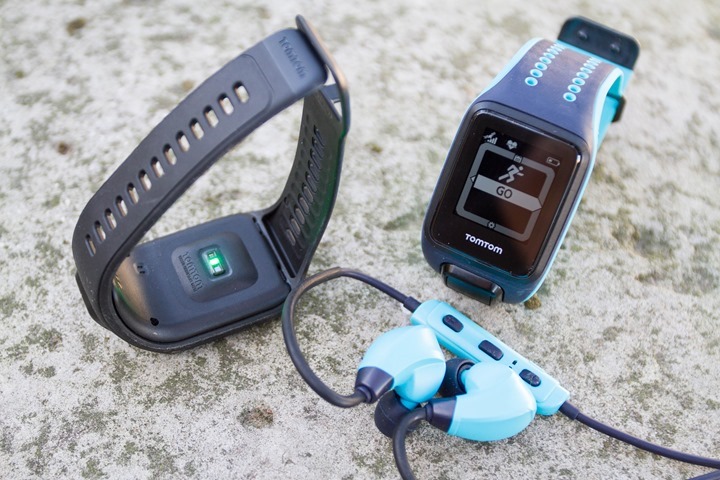
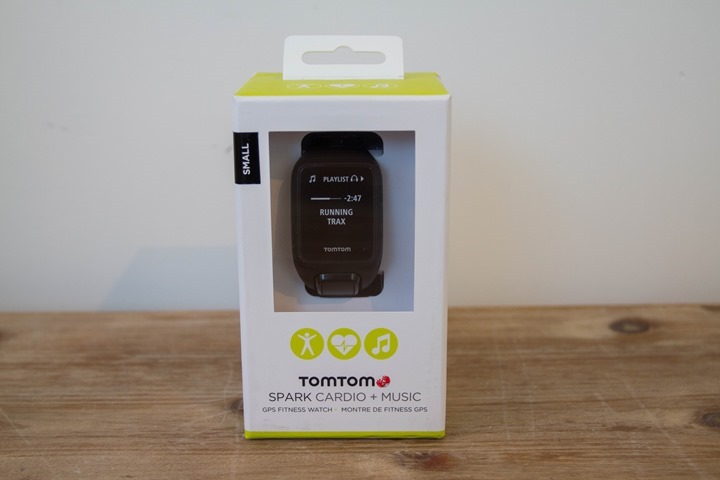
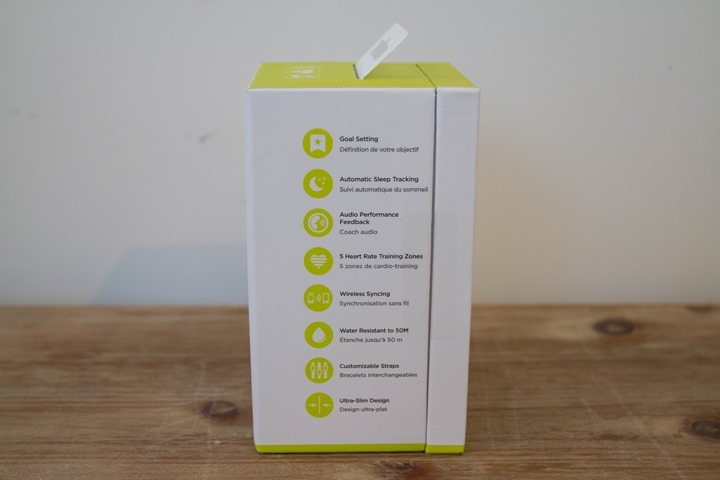

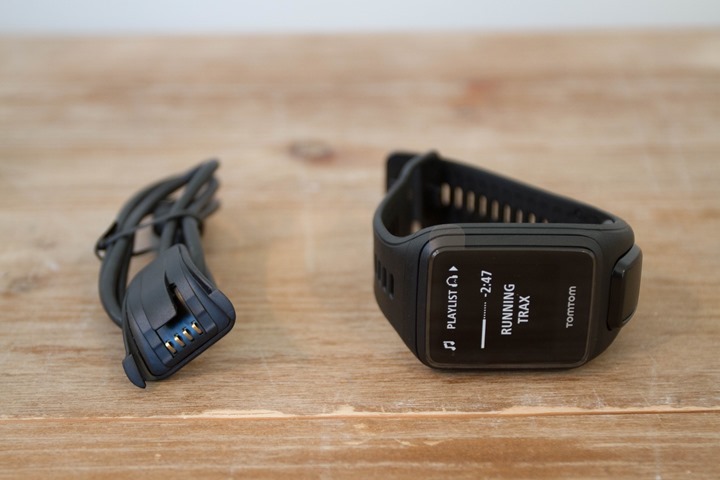
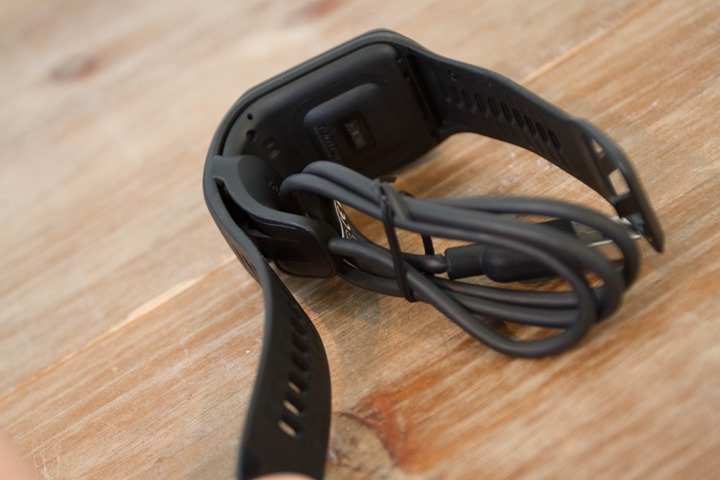
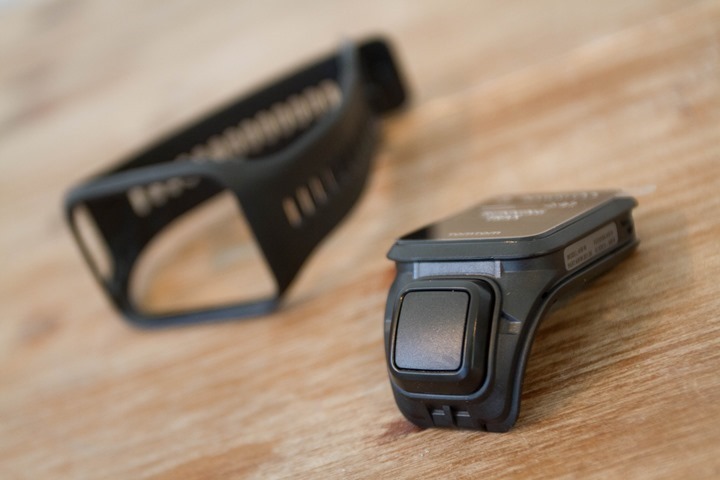

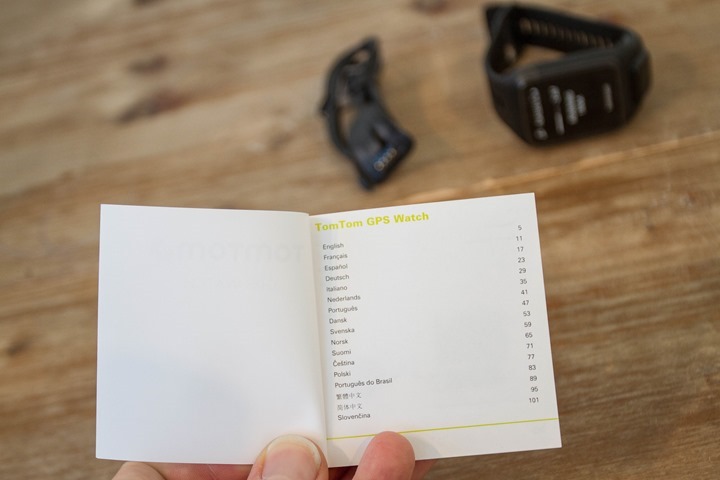
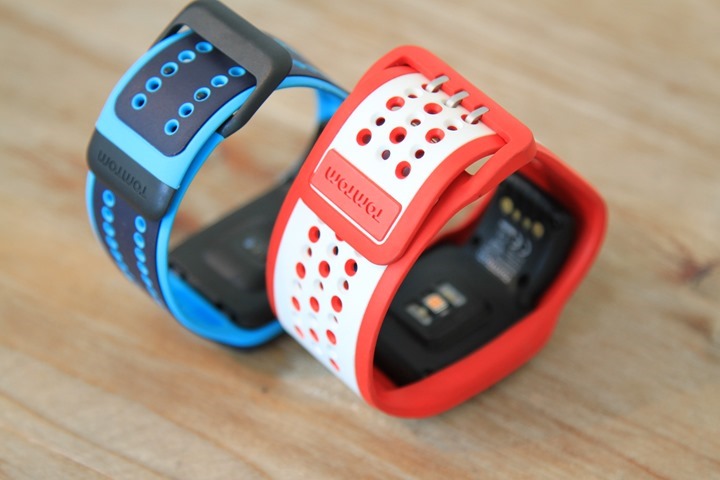
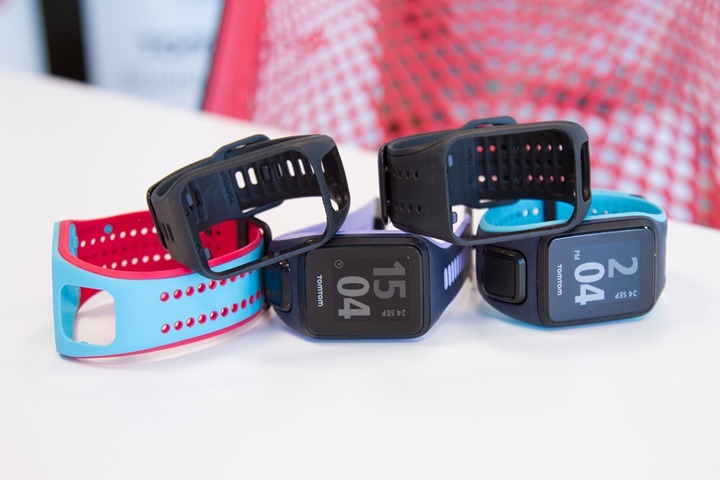
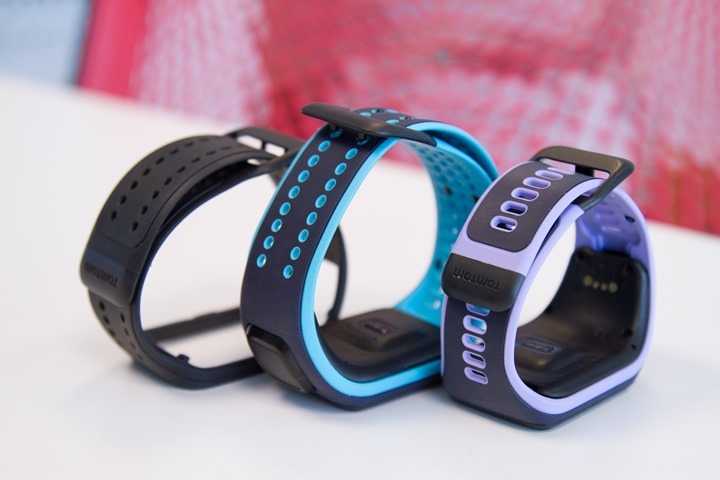
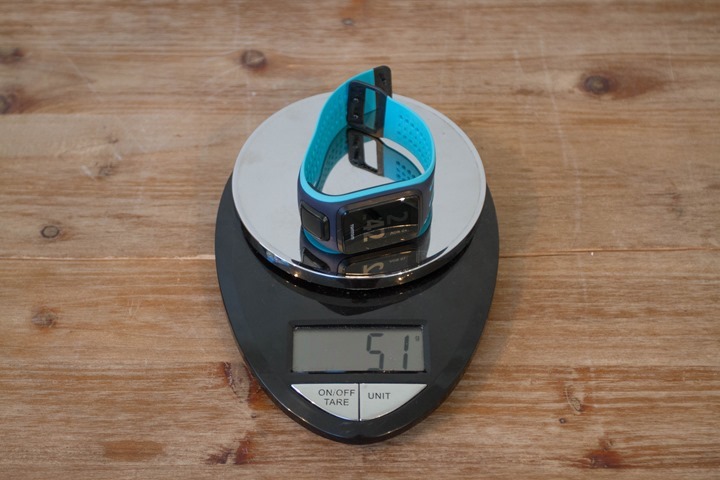
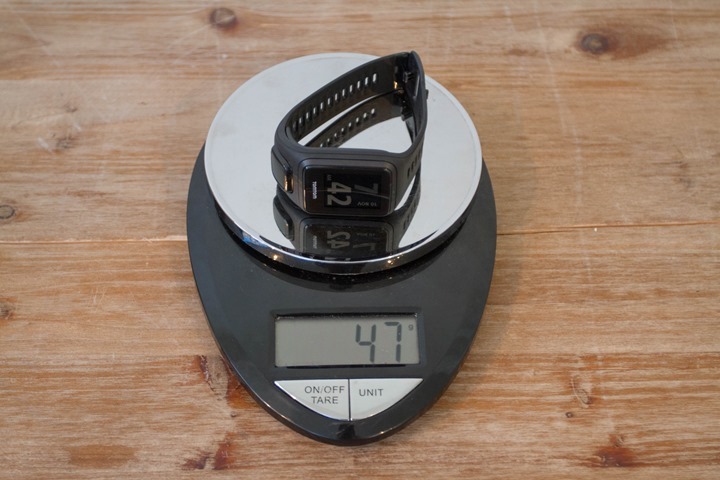
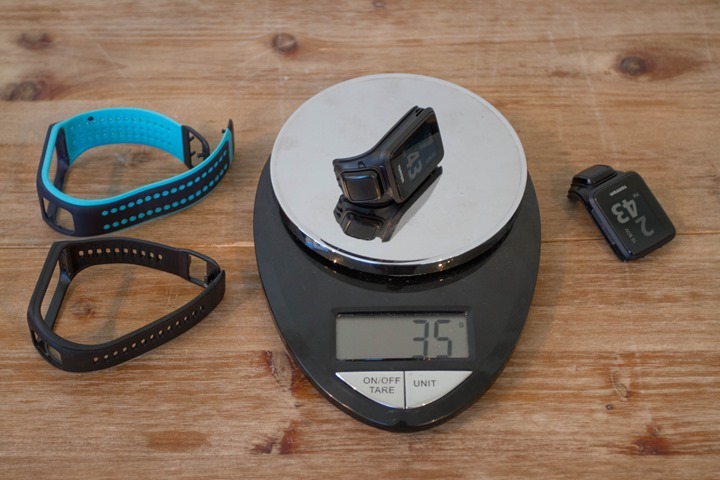
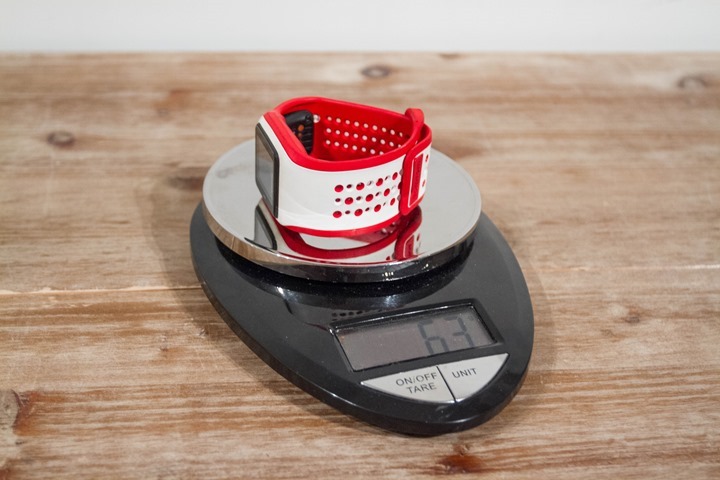

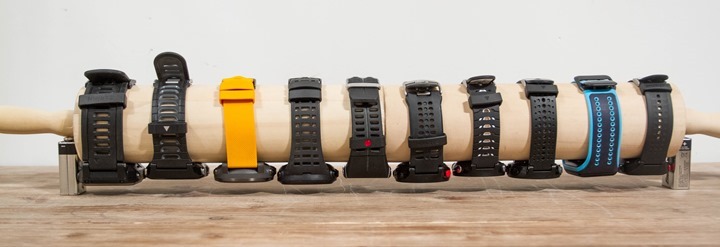
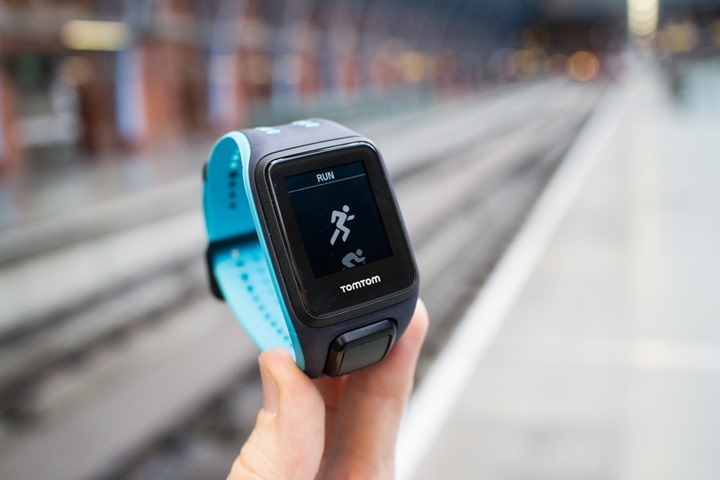
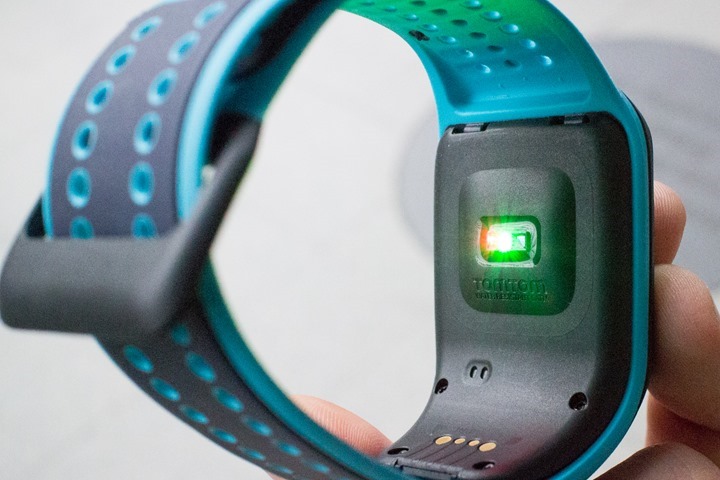
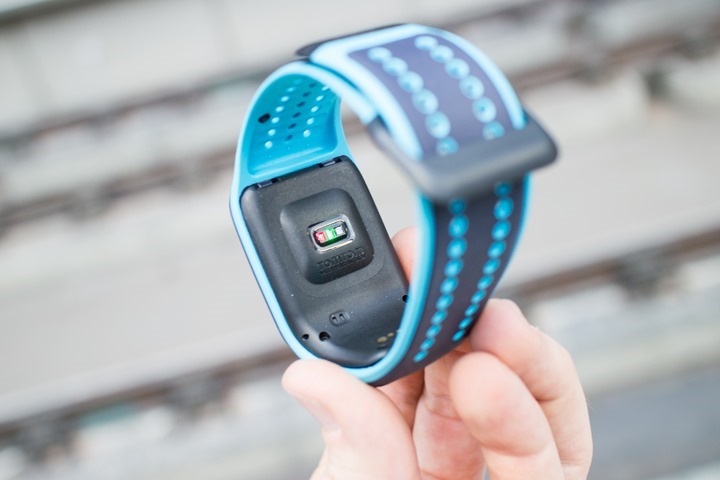
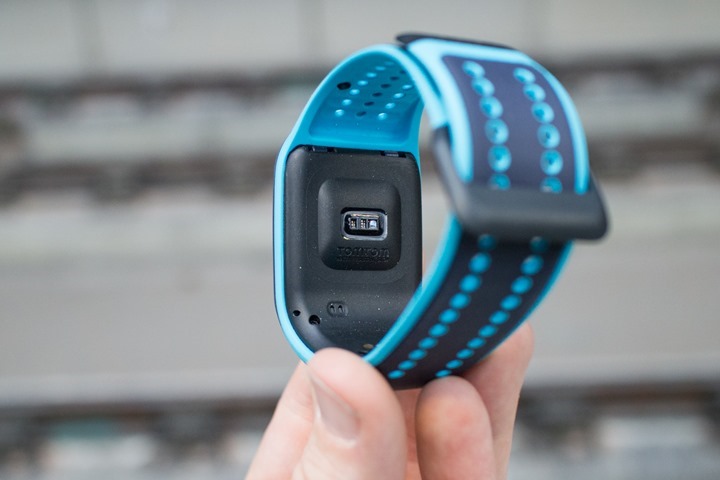
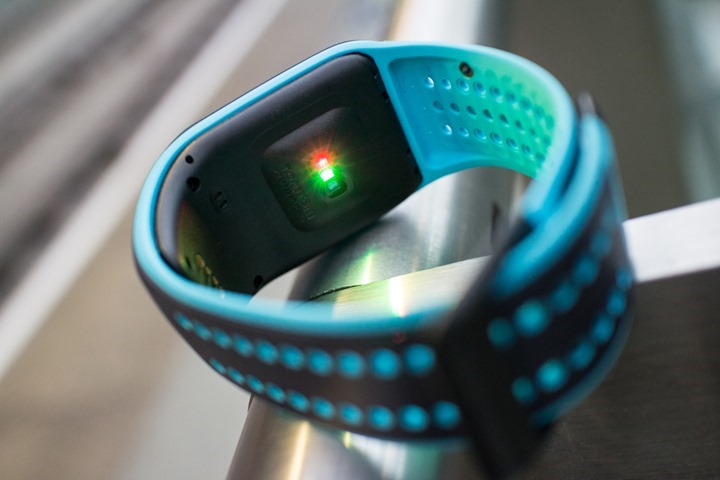
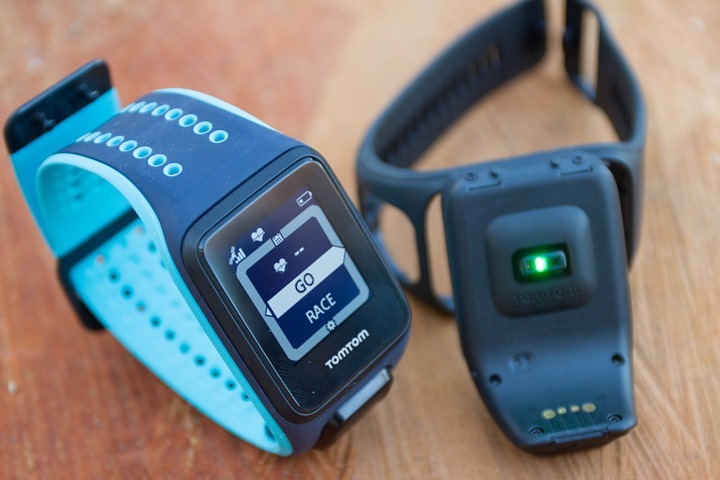
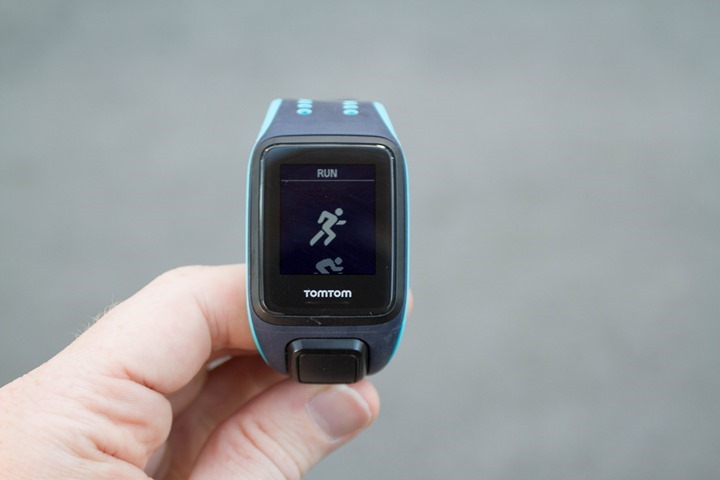
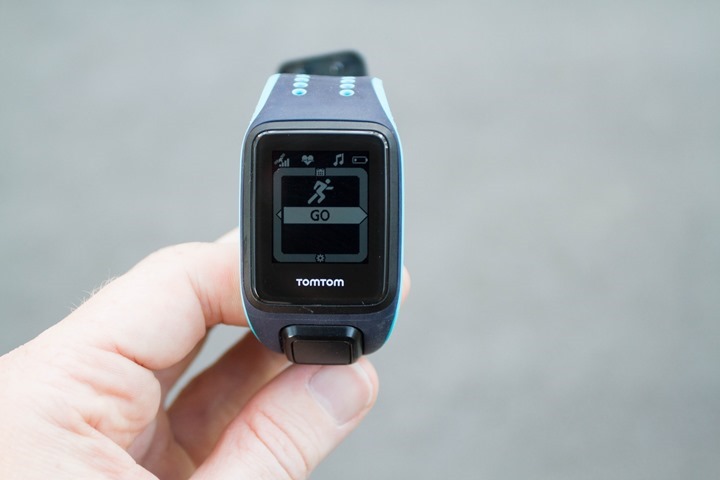
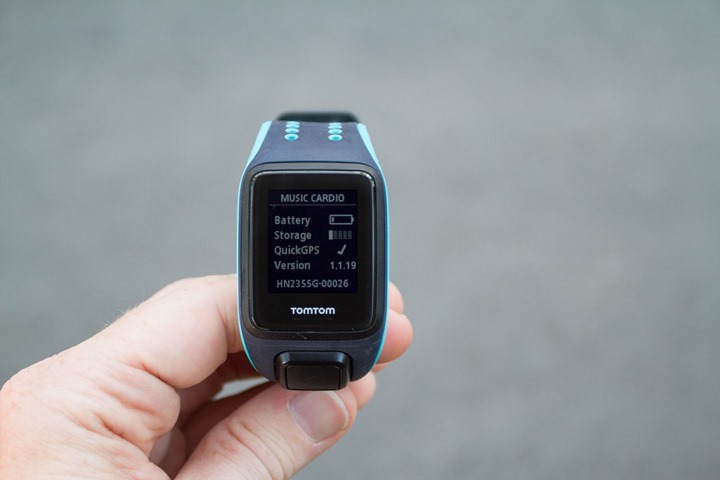
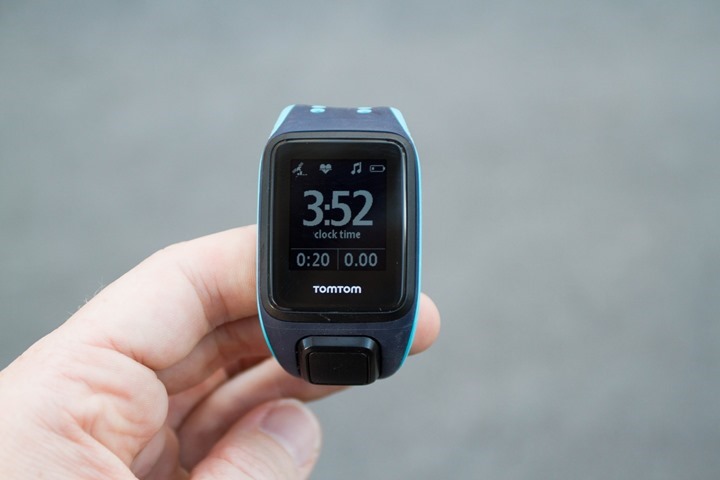
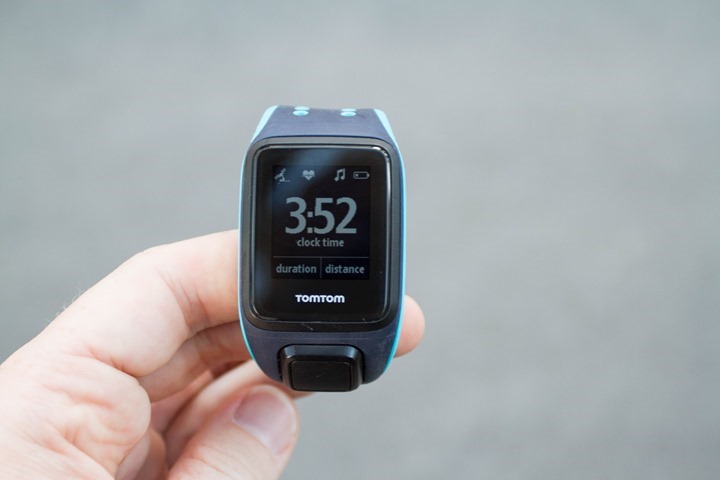
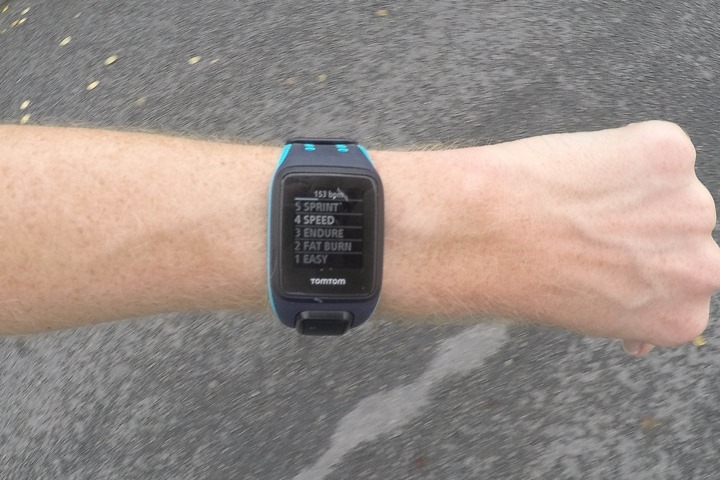
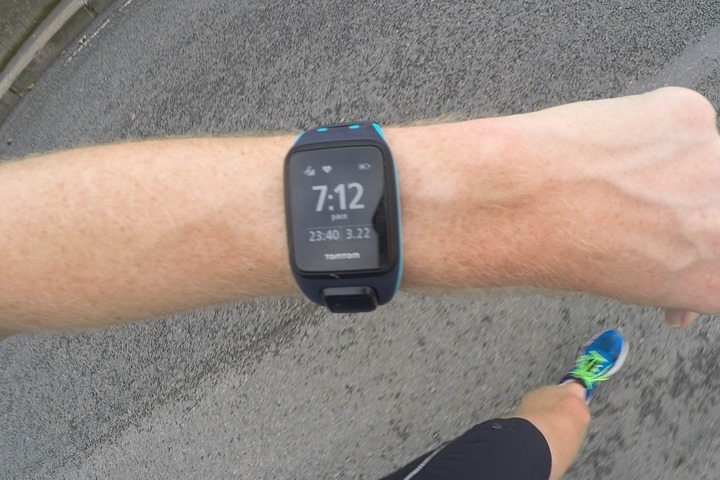
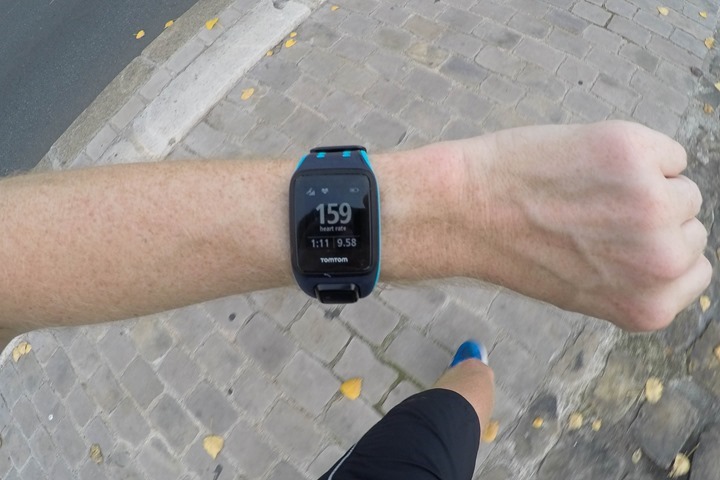
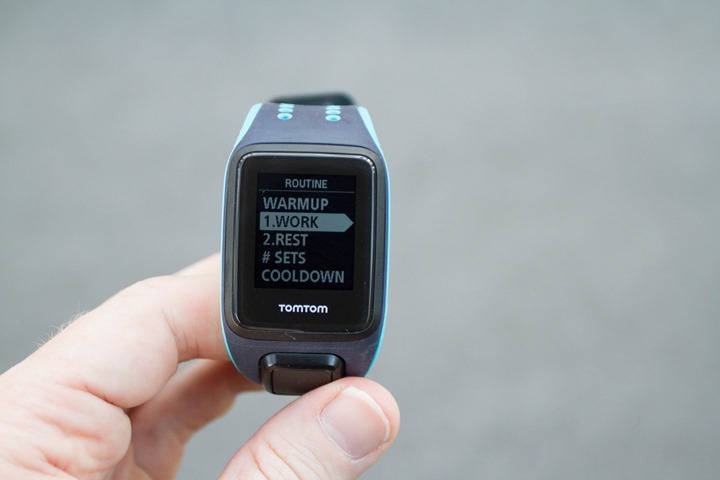
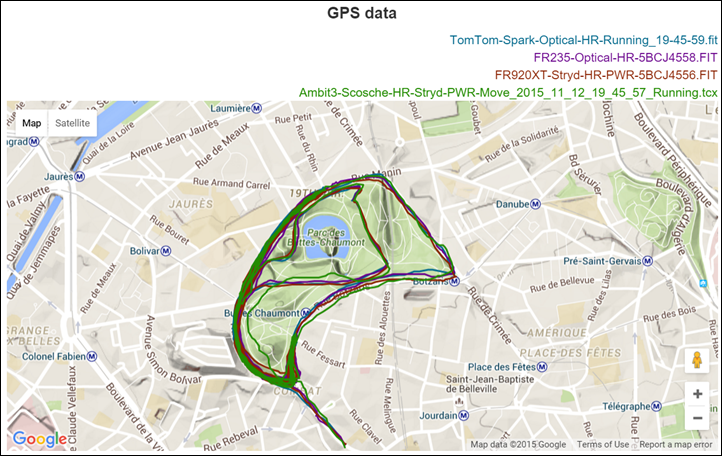
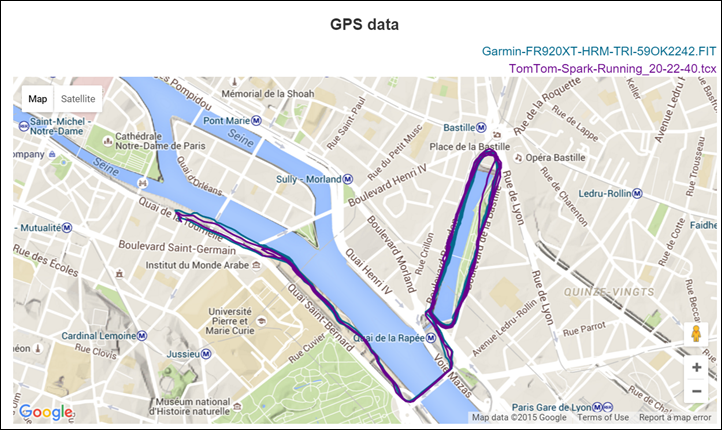
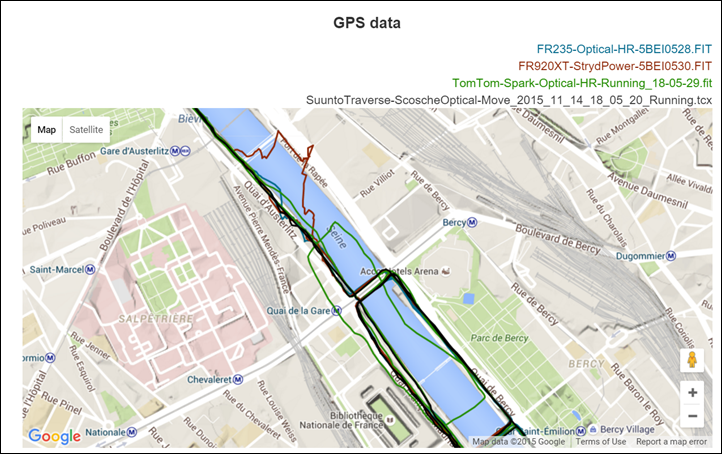
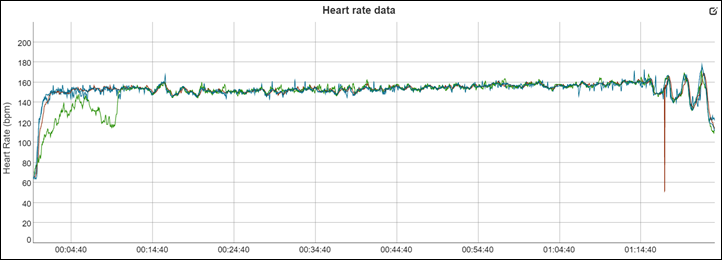
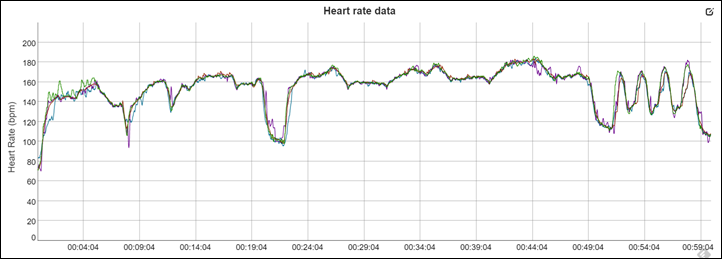
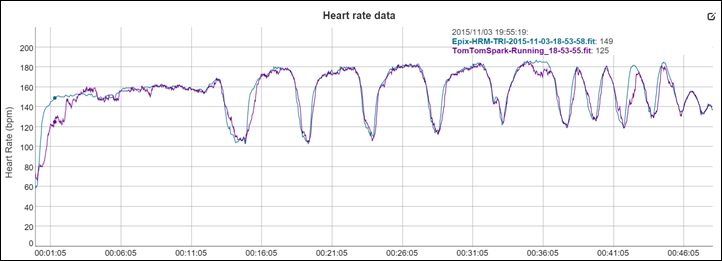
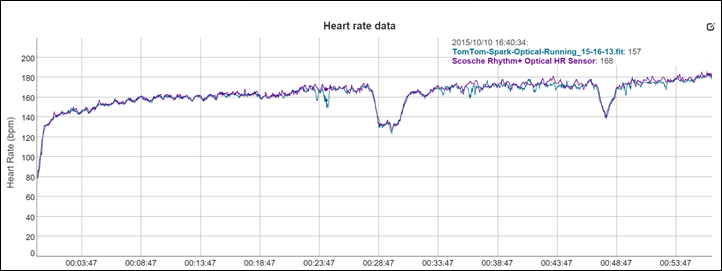
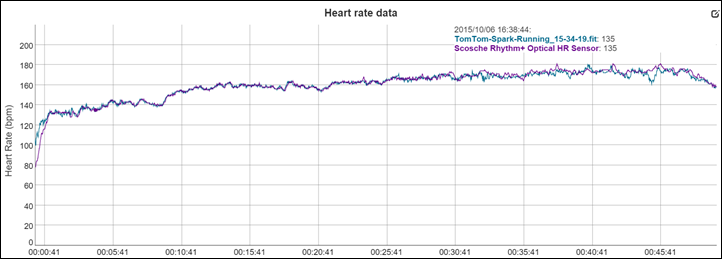
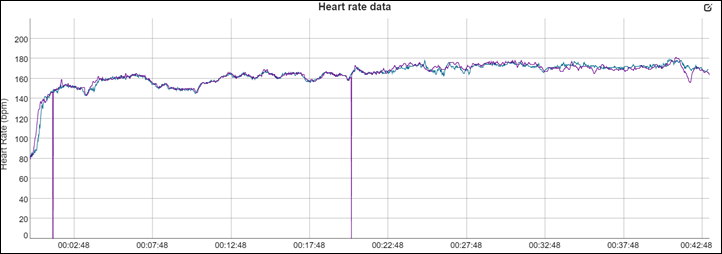
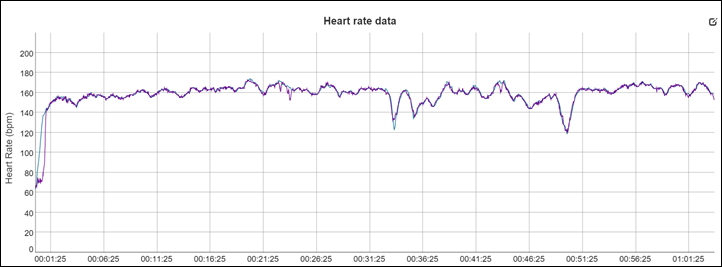
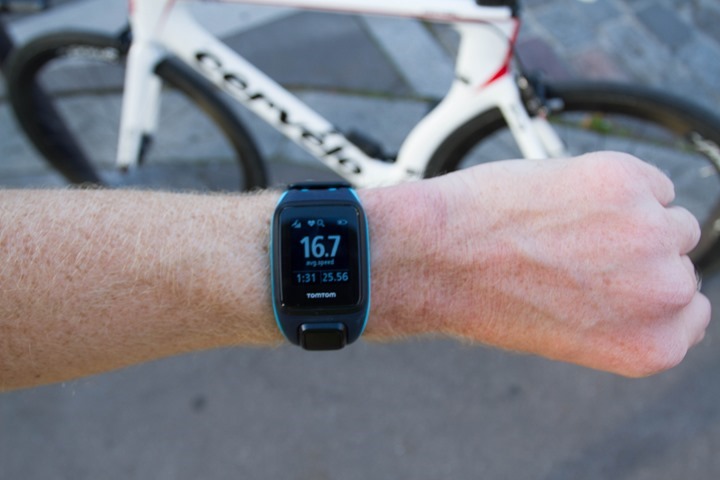
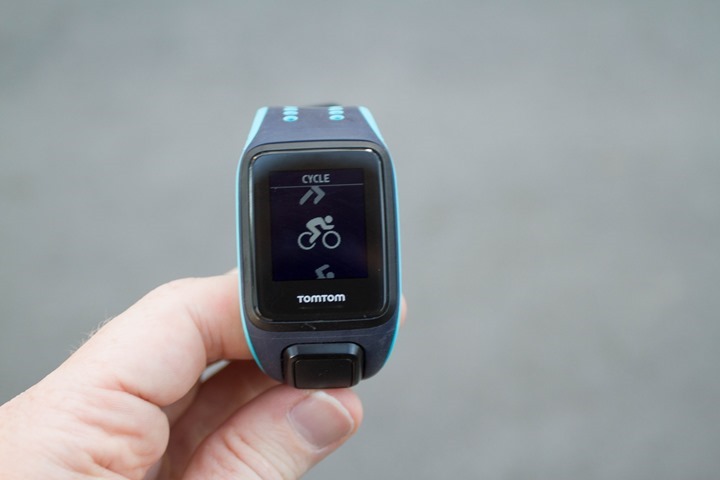
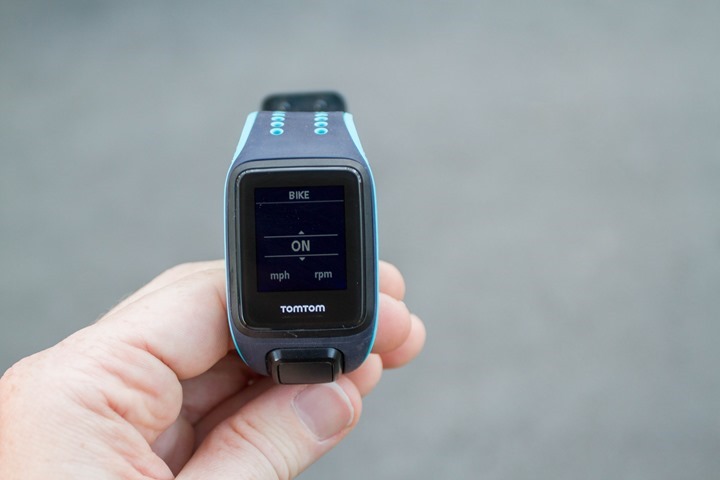
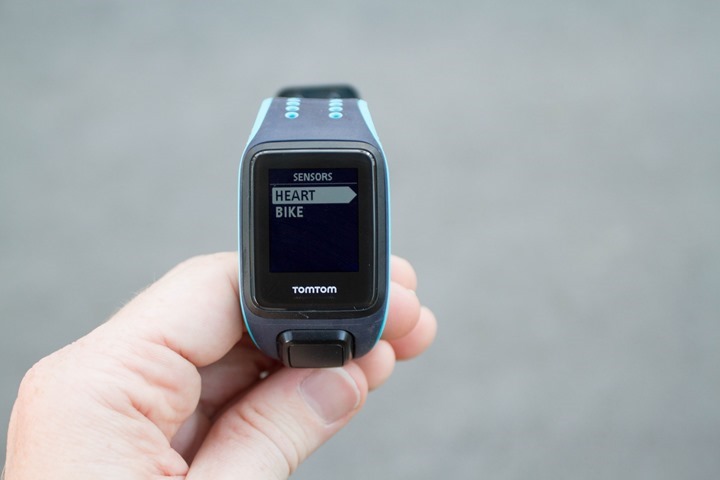
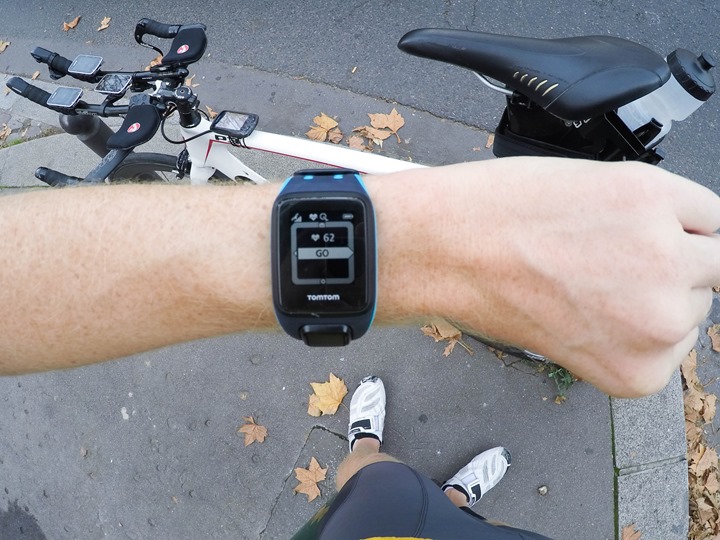

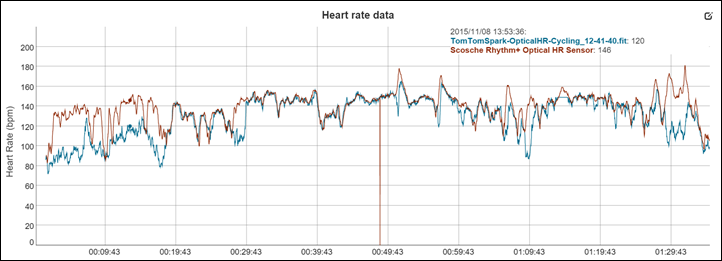
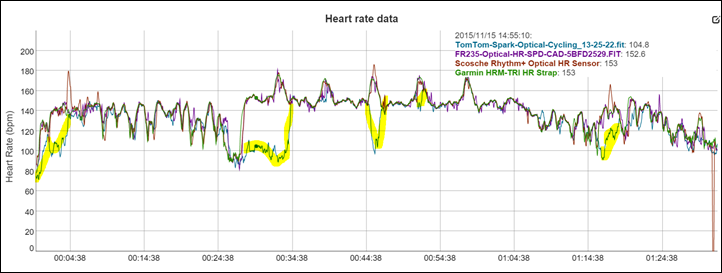

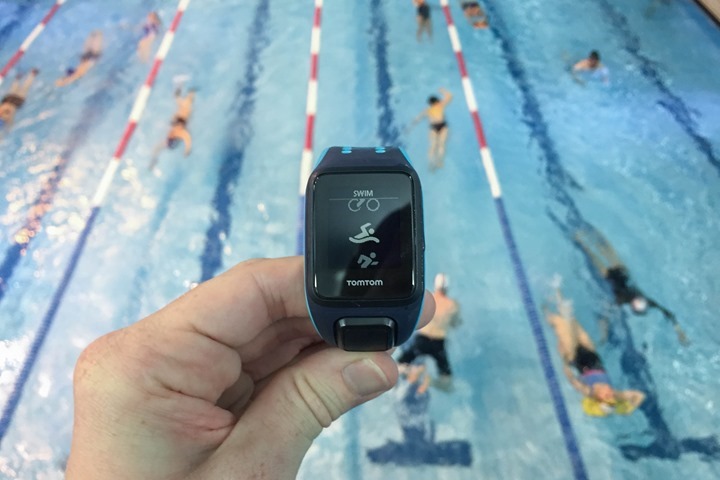
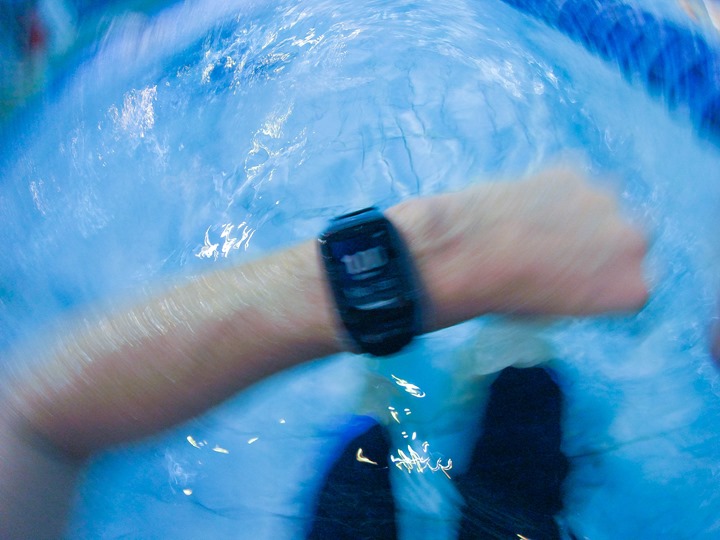
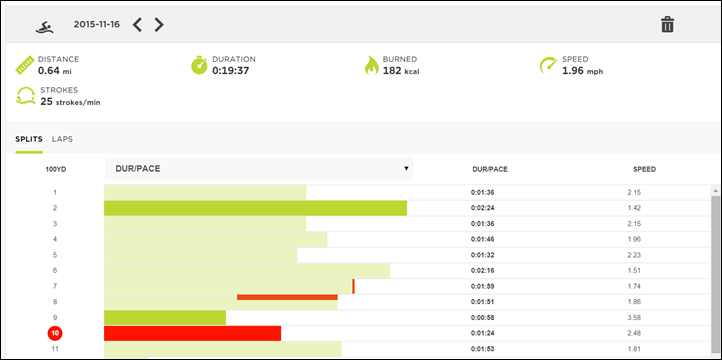

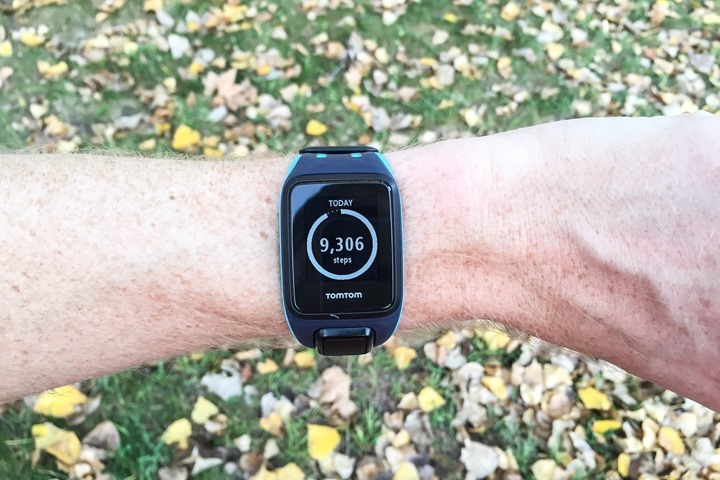
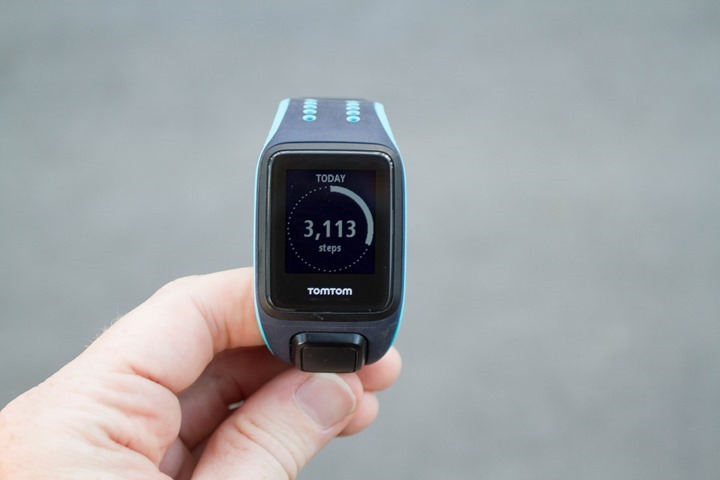
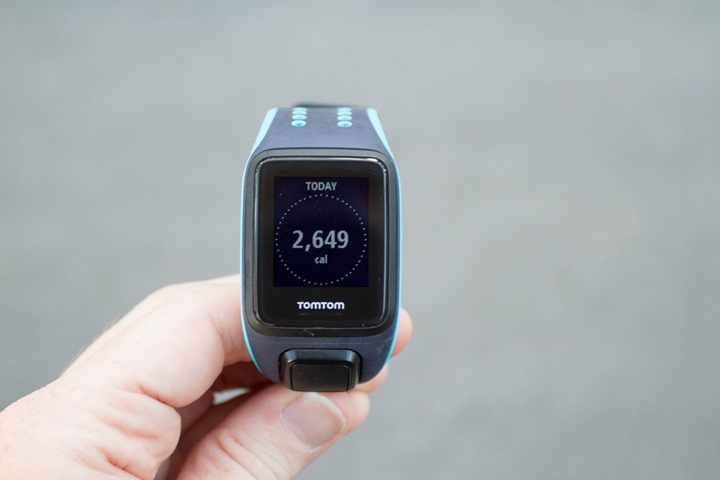
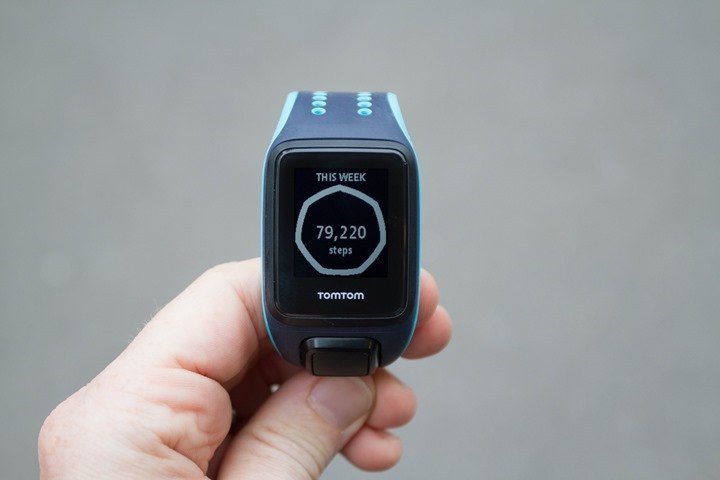
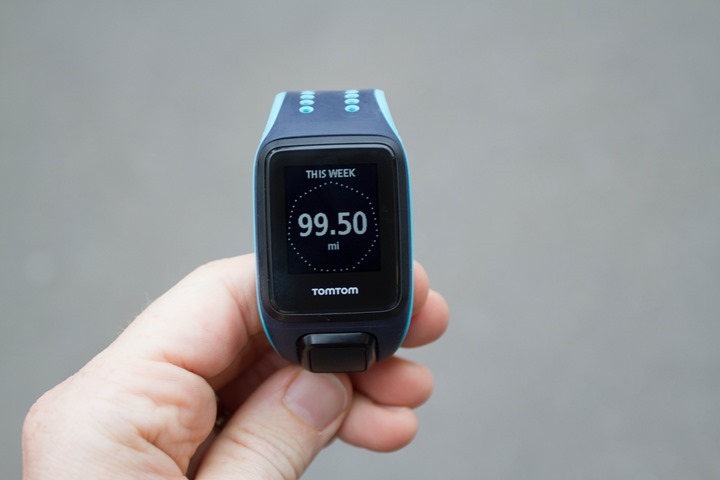
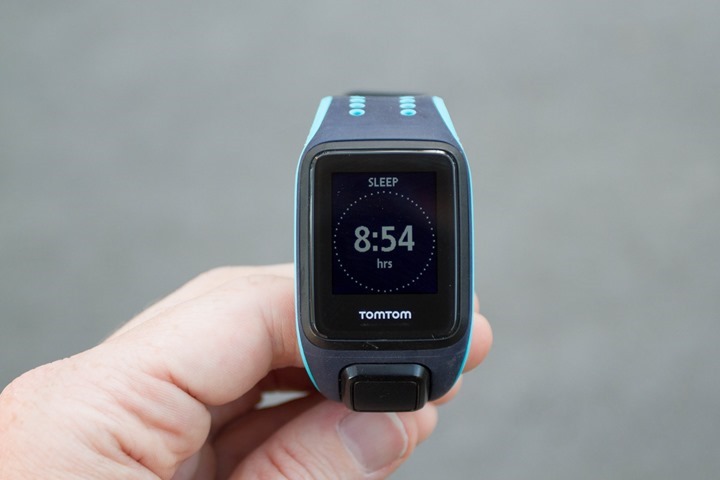
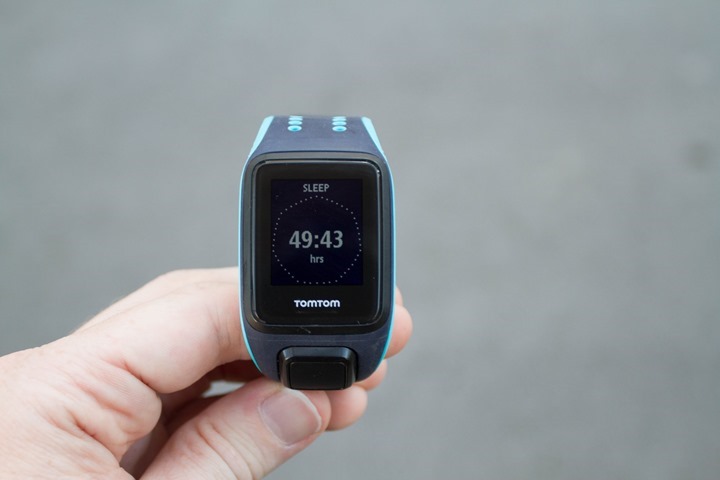

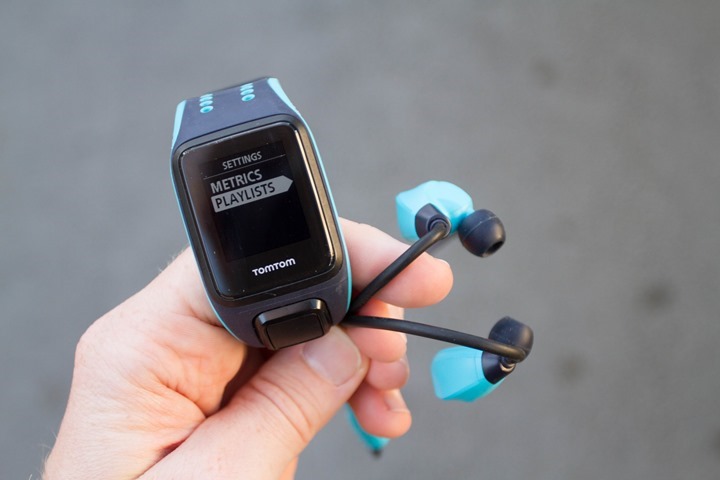

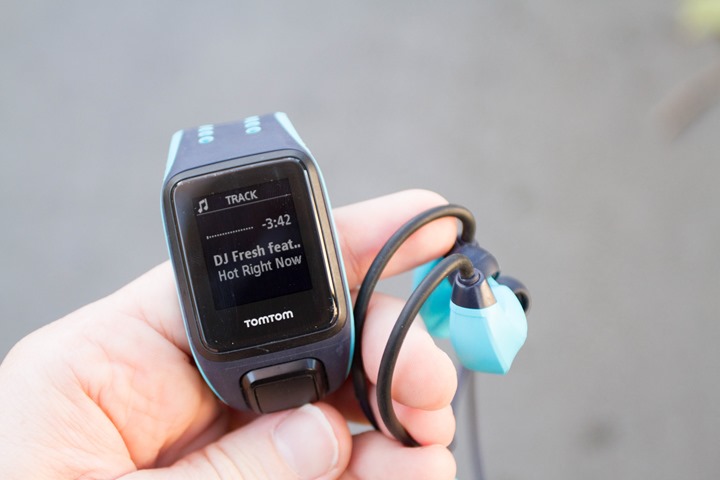
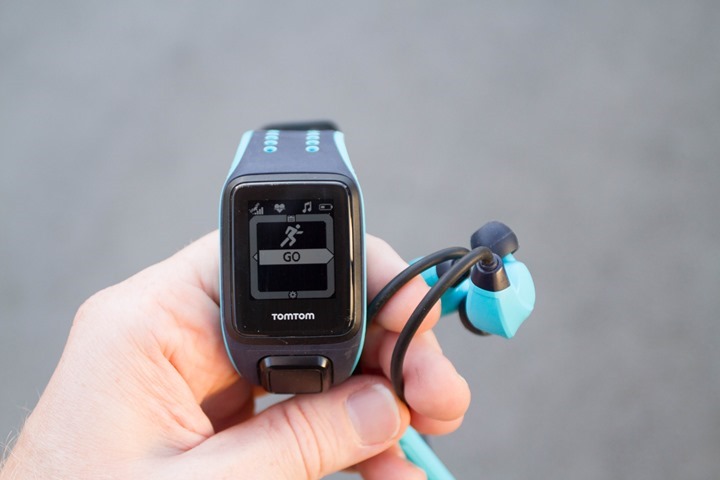
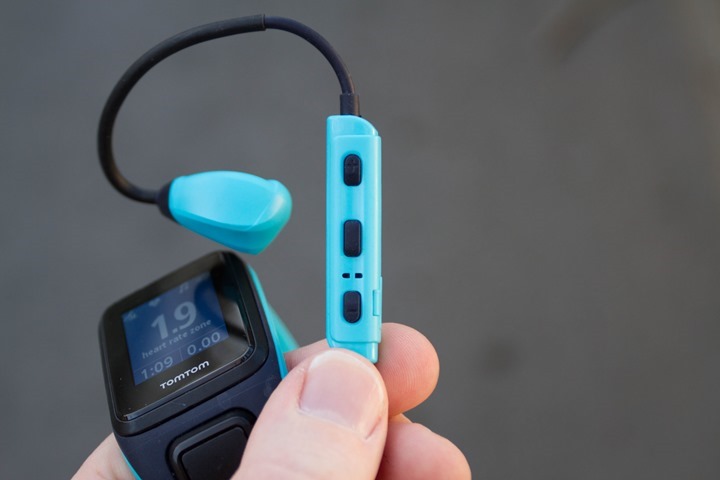
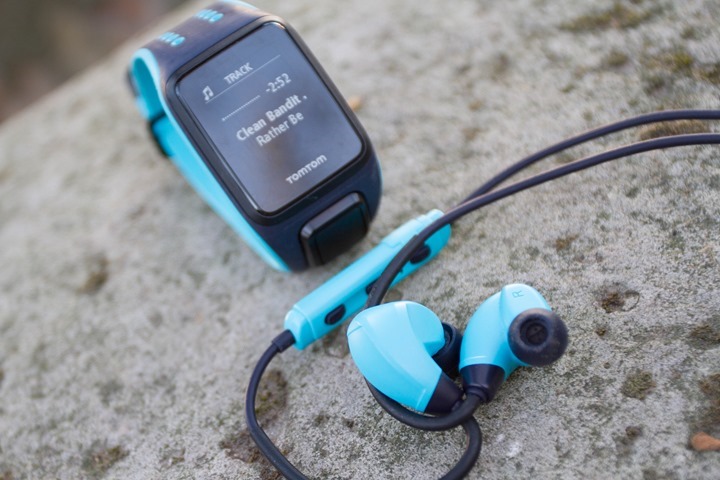
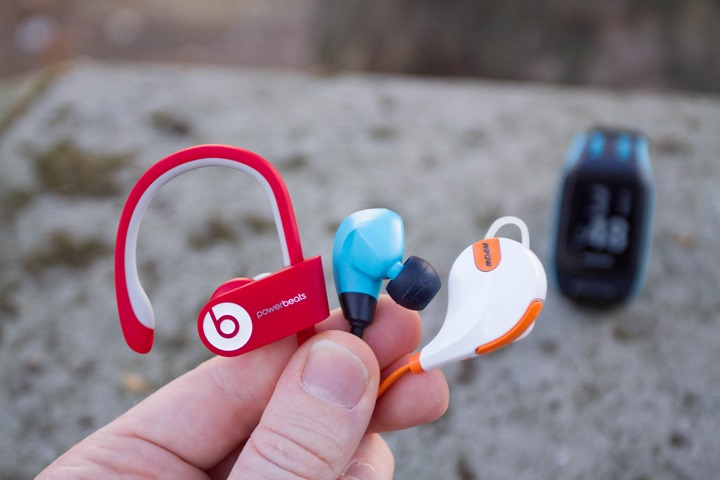
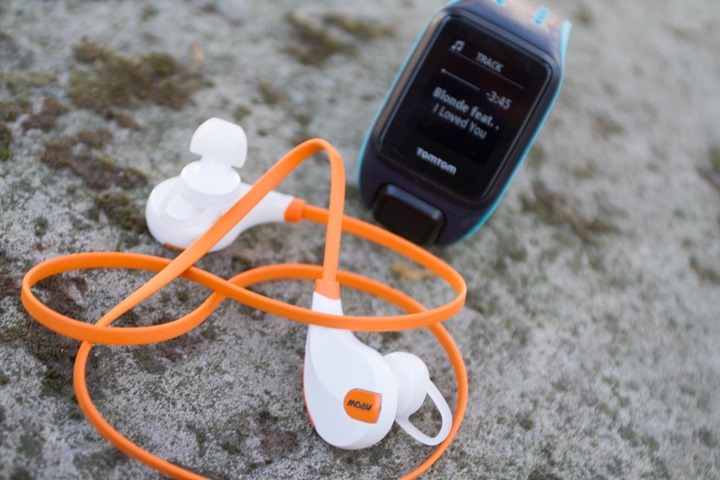


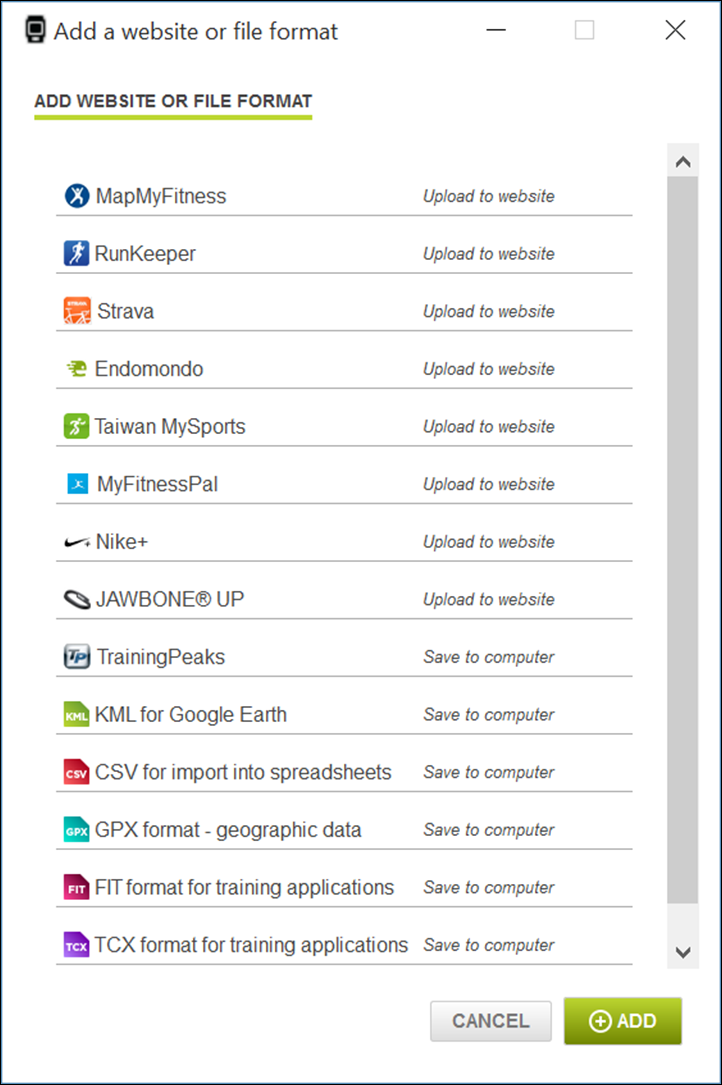
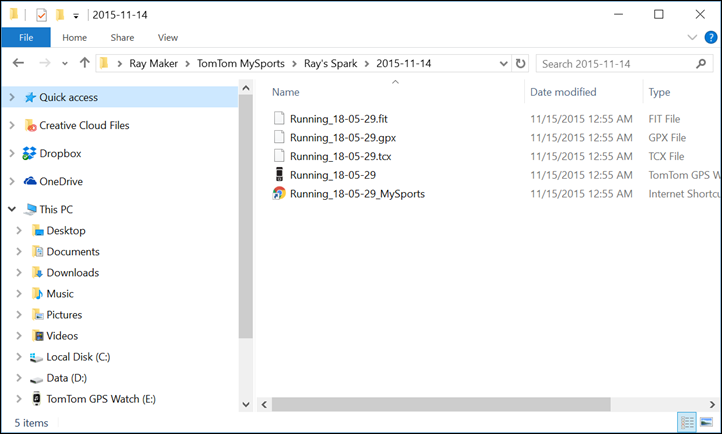
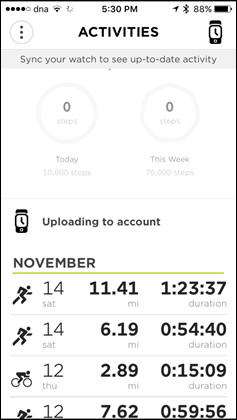
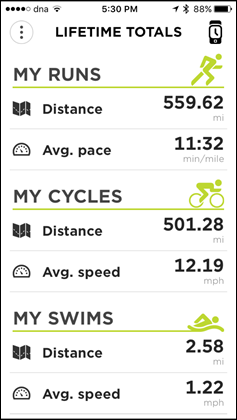
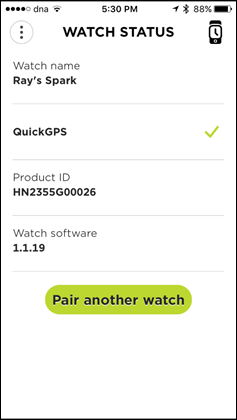
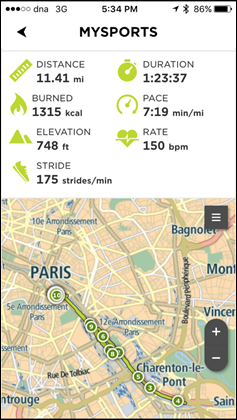
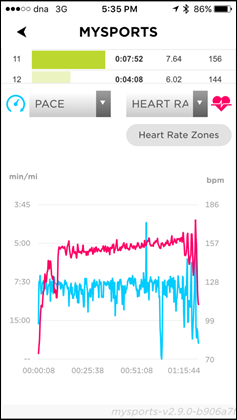
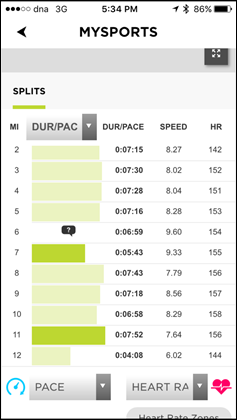
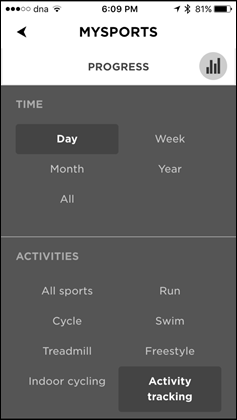
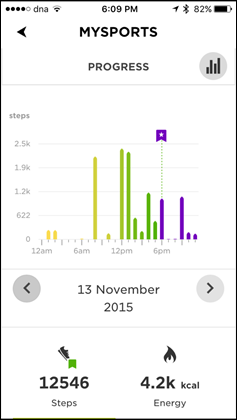
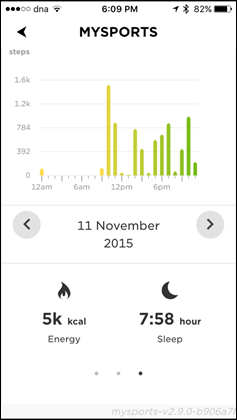
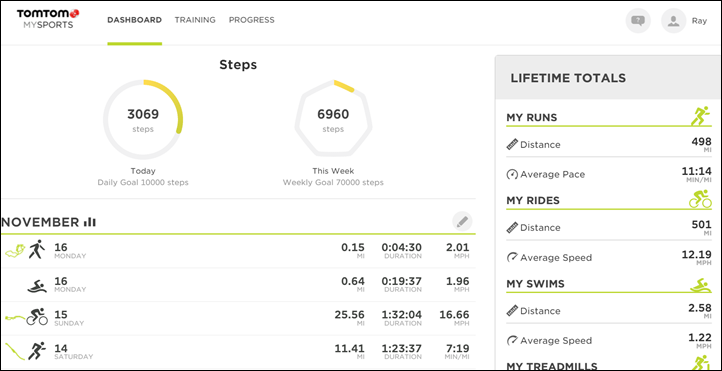
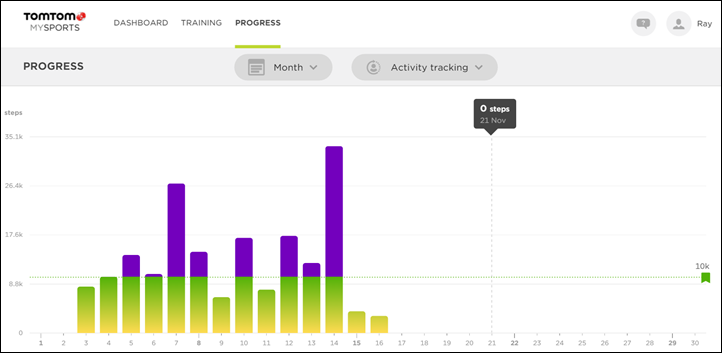
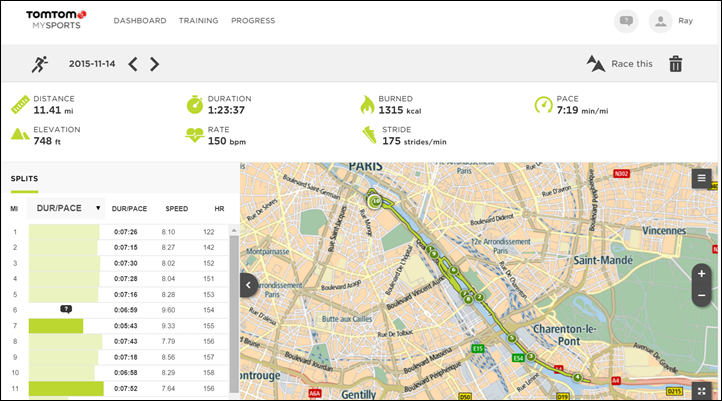
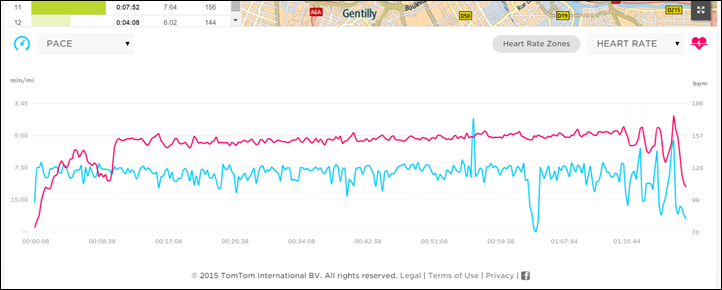

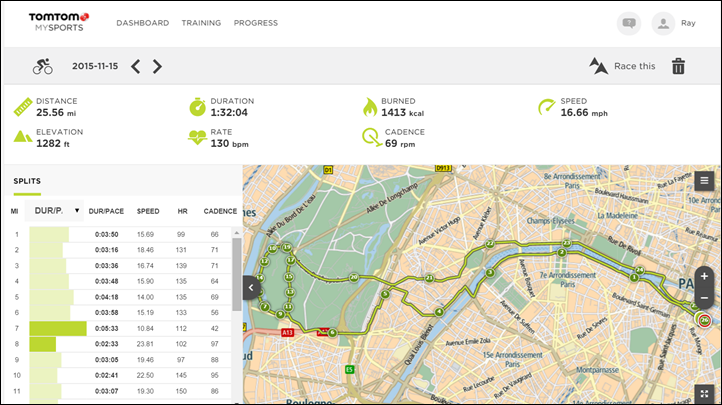
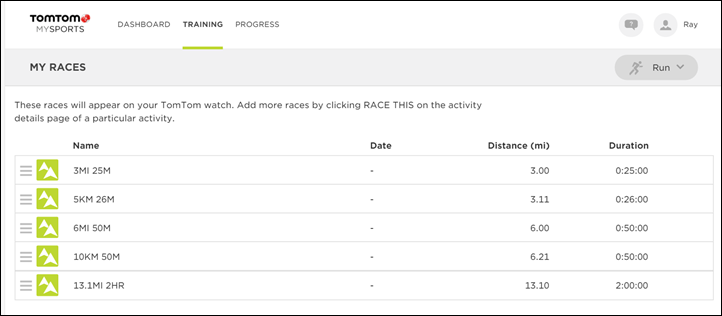
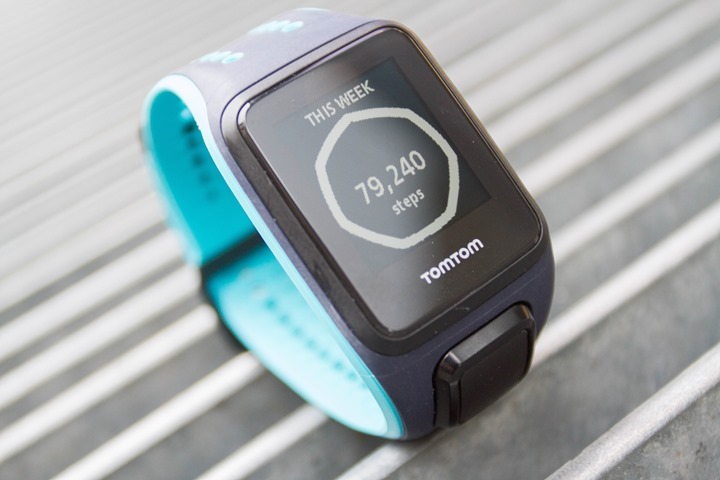

















Thanks for the review, Ray. Do you have any feel for if they’re going to make any significant software changes moving forwards?
I use the TomTom Cardio as my “grab and run” watch and really have very few complaints – its basically the same watch with restrictions on it. The biggest ones are around the running “modes” though. As an example I want mile splits as a watch feature, not something that I have to “select” (that are then incompatible with interval warm-up/cool-downs).
Having the downloaded files contain real splits would be good too – as it is, whenever you upload the file to TrainingPeaks (or similar) you get one huge segment. Their own website splits them out, but that’s about all it does. Its possible that that’s been fixed – I see the you had “beta” PC software – but it’d be really good to know before recommending this over the equivalent Garmin for holiday giving.
One more random comment just in case they’re reading these comments and weighting them over their own support requests – (if so, hi TomTom guys) – only showing speed in MPH for intervals on the website is silly. Making it choosable would be better, but is there really any runner out there who uses intervals but wouldn’t prefer to see pace?
On the beta, it was just to get one of the firmware updates before it was released. That release was about 2-3 weeks ago now. So on the production versions since.
As far as updates, I suspect we’ll see good progress on the web side, for the simple reason that them dual-paying probably isn’t something they want to do. So once they start cutting folks over and get comfy there, they’ll focus that team on new features.
As far as the watch goes, I’m less optimistic on some of the advanced features making it. I think they could easily knock out stuff like auto-pause, but don’t think that HRV will come to light. Just my guess.
Ray, I think your advice to considering purchase on the TomTom watch with what is available today and not what might arrive in the future is spot on. I say this as a purchaser of the last Multisport watch who was disappointed with how few of the promised (and published) upgrades were actually delivered. Auto-pause was one of them, so I wouldn’t be surprised if it didn’t make it to this generation either. That said, the functionality as initially delivered worked OK.
Or the Gym/Indoor cycling mode – Indoor cycling worked with the first MS 1.2 software, then they broke it, and never fixed it – Now if you ask on the forums about any of the old “planned” fixes they point you to the URL for the new product….
interesting tactic, but yeah… :)
Ray – Do you plan on doing a headphone review? I have struggled and failed to find a solid pair of bluetooth headphones that fit my ear.
Thanks and great work as always.
I don’t plan one at the moment, mostly for the reason you noted around fit – which can be super-tough to narrow down from a review standpoint since everyone is so different.
Also, it doesn’t help that I tend not to be a big wearer of headphones while running.
Thank you for your time.
Thanks for the review Ray! You said the battery life is 11 (?) variable hours. What is it with HR and music?
It’s super variable. I find that it’s horrible at the light + music + optical + GPS, down to about 2hrs. But just optical/GPS I’m able to do a weeks worth of workouts and activity tracking.
Meant to add the backlight battery note in there…good call!
Frustratingly there also doesn’t appear to be a way to start a run in “nighttime” mode and then turn it off once the sun rises.
Yeah, I wish there was the manual option with a ‘Stays on’ setting like on a Garmin.
Thanks , I’ll probably hang on till they figure out graphene battery tech then.
Thanks for the review Ray. Just to clarify using the heart rate sensor only with workout modes (no GPS) your battery life lasted a few days?
Yes, easily.
Hello Ben, Kellie and all! To add to Ray’s response, here is a breakdown on what the battery life is designed to be: when using GPS only, it should last up to 11 hours. GPS + heart rate monitor is up to 9 hours, GPS + music + heart rate monitor up to 5 hours, activity tracking + music up to 6 hours, only activity tracking up to 3 weeks and clock mode only up to 6 weeks. Hope this helps!
Ray, is it possible to use this TomTom spark in ultramarathons to keep it plugged it during a run or does it get disabled? Is there a way to bypass it to allow charging AND a concurrent workout like how you figured out that the vivoactive can do both? I called and technical support did not even know about that trick. ;-)
link to youtube.com
Thanks for your help!
I don’t have one with me at the moment while travelling, but I’m 99% sure I tried it once before and it locked the screen & ended the activity.
Perhaps someone else is able to double-check again. Note that if trying you need to ensure it’s not being plugged into a computer, since that will start the sync process. Versus something like a wall outlet/USB battery pack will give it just straight juice.
Screen locks out while charging whether in computer or in other charger.
Thanks for the quick comments. That was the main reason why I bought the vivoactive over this tomtom. I’m trying to Boston Qualify but I’d also like to use it to run 100 milers. So unfortunately I had to buy another old Motoactive gps since I don’t like to bring my phone on runs for music and this nice light vivoactive for locking in my pace. I was going to experiment with the Moto 360 Sport but I read a lot of negative reviews so I was unsure if it was worth the gamble. Thanks again!
Thanks Matthew!
Ray,
One last question, does the Garmin 230, 235, and 630 all have the ability to go from usb mode to garmin mode for a long ultramarathon auxiliary battery connection? I’m wondering if the audio prompts were worth it or if I just stick with my combo vivoactive + motoactive for the time being. :-)
Thanks again!
~Matt
Thanks for the review!
It’s still a bit baffling to me that TomTom refuses to spend the time to enable an open-water swim mode. Especially when this was advertised way back when as the first Multisport was released. I bought in on that note, and they’ve still refused to put it in. For that reason, I’m out. #sharktank
Ray – Just a note, they have disabled the red LED sensor and are only using the green ones. I am not sure of the reasoning, perhaps not enough added accuracy for the battery usage?
A big change from the older models is the addition of the indoor cycling and gym modes, which were sorely lacking on the Runner1 and MS models. This is a big highlight for me as it was a real miss on the old models. However, I am still scratching my head over features like auto laps, auto pause and other running basics that have been requested for 2+ years that still did not make it into this model. Perhaps they will come down the road, but as you pointed out they have a spotty track record for updates. They update a lot but it seems to be things that they want that the users don’t necessarily care about.
Keep up the good work. I don’t make a purchase without checking with you first and the podcast is top of my list!
Very interesting on red led, I’ll find out details. It’s funny though, I had the red pick from late Sept and it came out so pretty, and my more recent pics were just green. But I’ve long found that taking photos of optical sensors is super tricky, so I just wrote it off to the wrong combo of camera lighting.
It looks like the IR LED isn’t on, either. ;)
(Only because you said “You can clearly see the different colored LED’s here.”)
Hello all, the red LED is not in use at the moment (since software version 1.1.14) as, to measure your heart rate, the red LED does not bring any benefit – it’s the green LEDs that do the hard work there. To save the battery consumption we’ve switched it off for now, and it has no effect at all on the accuracy of the heart rate measurement.
Hey there! Any word on when the TomTom Spark Cardio (GPS and optical sensor, no music) will be released? Thank you.
Thanks for this great review Ray! I am still not sure whether I have made the “right” choice in terms of the TomTom Spark vs Garmin FR 235, but given that I already own the FR 220, I will lean towards trying the TomTom Spark and then getting a FR 235 down the road as a more “serious training” watch, or if we are lucky, perhaps Garmin may decide to manufacture a FR + music storage + BT playback – that would be the best of both worlds for me! :) :)
I am honestly disappointed about the lack of interval alerts (vibrating etc), as this is something I really use in my FR 220, as well as the inability to plan workouts and download them to the watch. However, I think the TomTom Spark might be a great watch for relatively easy going runs where you don’t necessarily want or need a ton of stats.
I look forward to reading your FR 235 review when it is out next week!
Best wishes,
Philippa
ps: any news on when the TomTom Spark HRM+earphone bundle (US$299) is shipping out? I already pre-ordered on CT (using your discount code – many thanks!) and just wondering when they might actually become available.
Is it true that this unit does not have interval alerts of any kind (ie vibrate, sound etc)? this is a deal breaker for me.
It does have alerts. It vibrates/beeps at the start/end of each set.
No when you go into Run mode there is NONE, GOALS, INTERVALS, LAPS, ZONES & RACE. Selecting LAPS lets you pick an alert based on TIME, DISTANCE or MANUAL. So I use LAPS->DISTANCE set to 1km, and every 1km it vibrates/lights up and gives you the lap time. I think you can also get it to show the previous lap time on screen as one of the metrics, but haven’t fiddled with that yet while running.
Sorry. I haven’t read the whole article yet. Couldn’t stop chuckling at this:
“That’s just the way I role.”
I believe that’s actually the way you roll.
Trying to proof while eating dinner never works…pasta sauce everywhere too!
Thanks so much for the review. Did I miss it, or did you not have any input on battery life? In your initial look at the device (which I was reading last night), there were a lot of comments on battery life while running GPS and music and/or HRM. My biggest wish is to run with music and not have to take my phone, but I need it to do that for at least 5 hours (I’m a slow runner). Will this do it, or should I just wait?
Thanks!
Hi Beth, to answer your question, when running with GPS, music and heart rate monitor on at the same time, your battery life should be up to 5 hours. If you only run with GPS and heart rate monitor, but no music, then it will be up to 9 hours. With GPS and music, but no heart rate monitor, it’s still up to 5 hours. Cheers!
Any idea why they aren’t doing ‘running cadence’ from the wrist?
The cadence is recorded, and a summary is shown on MySports for each run e.g.: 170 strides/min, this summary is also exported to Endomondo. However if you get the app ttwatcher from link to github.com you can open the TTBIN file & export a TCX with the full cadence info!
It is very logical that optical HR (from wrist) does not work well in cool weather. In order to work, this method requires blood flowing in the peripheral venous system. The issue is that body cuts peripheral venous flow (through contracting blood vessels in this area) in cold weather in order to maintain core temperature. Cycling is worse because hands do not do any work and the air flow cools down hands even more. Running might have issues too in sub-zero degrees weather.
What I see interesting in Ray’s optical HR reviews (not only this but others too), that in MAX intervals > 180bpm, when the work quickly ends, the optical HR tends to follow actual HR very very slowly (remains at high HR longer). I’m not sure is it the issue in the algorithms, that could be worked out or physical phenomenon related to blood flow in the hands.
To me optical HR seems to be ok, for normal running (in warm enough weather), but I’d leave it out for max interval workouts.
thx for the explanation Tony! “cycling cold hand”-flashback!!
there’s lots of “limiting” factors when it comes to optical measurements!
Temperature, light from outside (noise), skin color, hair, placement of the sensor (watch) on your wrist, …
You always have to keep in mind that you’re moving away from the source you want to measure, your heart! And the arm is the 2nd worst point (besides the foot/ankle) for measuring the HR.
The belt still is/will be the best way (place) to measure your HR. And it has been in the business for a long time :P
Don’t get me wrong, i’m still impressed how well those things perform, but the above mentioned points are keeping me from a purchase. Let’s wait what the future will hold …
“That’s just the way I role.” Roll, not role. :)
You’re saying Ray isn’t a great ‘role’ model??
Ray is a great ‘role’ model!
Best use of a rolling pin evar! BTW spotted a few typos etc…
Thanks. Randy is running trough my typos as we speak. I had to leave for a 6hr journey, so wanted to get it posted. I gave it a few read throughs, but alas Randy usually catches the many I miss.
Great review as always Ray.
I have a few questions about music.
1) Is it possible to have playlists? If so, how do you navigate through them during a workout?
2) Can you only control playback through headphone controls?
3) Is there a ‘shuffle’ mode?
4) Is it fairly easy to upload music to the watch?
5) How often did you get dropouts and how long do they last?
Happy Thanksgiving (if you are celebrating it)!
1. Yes there is playlists. If you use Itunes the playlists end up in your mysports tomtom app on your computer. There you can just push what playlist onto your watch.
2. Playback is only through headphone controls.
3. Yes there is a shuffle mode.
4. Only difficulty was converting itunes library playlists export into xml. file. Why you have to do that I don’t know. One the the my sports tomtom see the playlists it is very simple to add and remove them to/from the watch.
5, For me once I switched the unit to the side I had my receiver I don’t recall hardly any dropoutns on a 9 miler.
Hi Troy
How did you make your Spark “see” the converted playlists?
Thanks…Ray…as always, great review. I have 1 question about HR…the past Tomtom Runner Cardio didn’t use their HR info to calculate calories burned in a work out at all, do you know if that has changed with the Spark? I hope that makes sense…in other words, you would have your HR info and your estimated calories burned but the HR had no sway on estimated calories burned. My wife is eyeing the Spark, but estimated calories burned based on HR info is big for her so I just thought I’d check. Thanks for any info you can give me! Thanks again for your awesome reviews.
They still use MET tables to calculate calories for running, cycling and swimming. Freestyle and gym mode use HR based calculations. The problem is they use the same MET tables for indoor and outdoor cycling, when the have different MET values. Plus if you are using indoor cycling without a speed sensor you get no calories burned at all because it has no pace to compare to the MET table.
I understand why they use METS since they have units with and without HR monitors, but I can’t understand why they can’t simply have it use HR if it detects HR data and METs if it does not (or make it a user option to use HR or METs).
Ray – Has this ever come up in your discussions with TomTom?
Yeah, I figured it would be the same. This is a major fail IMO! Seriously…if they can allow HR to take over in Freestyle and Gym then it should be easy to do with Running, Cycling and Swimming. I think this will be a deal breaker for my wife unfortunately. She wants to see calculations based on her specific heart rate. Thanks for the response Tommy!
Hi Gavin, I’ll try to answer your question. As Tommy mentioned, at the moment, the TomTom Spark currently uses HR to measure calories in the Freestyle and Gym modes. In case we will expand this to other modes as well, we’ll make sure to let you know via our regular channels! At the moment, for other sports, the watch estimates calories based on the type of sport, your gender, weight and the intensity and duration of the exercise. I’ve made a note of your feedback and will pass it on to our development team as well. Thanks.
any hints re: FR235 optical sensor quality? I can’t wait….. :)
Thanks for the review. If I were looking at the watch only (no music, no HRM), would you give it or the Polar M400 the edge? Just looking at it for running/walking the dog and as an activity monitor, and I also want to be able to get the data (as easily as possible) to Map My Run and RunKeeper.
My two cents.
I’ve been happy with my M400. I just got a Scosche Rhythm+ HRM to pair to it. It has smartphone notifications and the app/website are good enough for me.
You can export your workouts one at a time for importing to Strava and it seems to import everything, including HRM data.
Although MapMyRun will import the data, it doesn’t show my route as far as I can tell. I’m not sure about Runkeeper either.
Having worn a vivoactive for the last year, it seems that TomTom has missed the boat by not including any smartphone integration. By including activity tracking, this sets the expectation is that this is 24×7 wearable. Nobody is generally going to wear 2 watches at a time, so they are forcing you to choose between smart watch and fitness watch. Moto 360 Sport from the Android Wear lineup looks interesting, but without an optical HRM may not capture much interest nowadays. The Garmin 235 with 24×7 heart rate monitoring, GPS and smartphone integration looks to be the most complete mix of features but is a little chunky for a day-to-day watch. For now I’ll stick with my vivoactive.
No one is going to wear two watches at a time! Ha! Do you know where you are?
Good review. The watch has so much potential, but not there for me yet. Problem is I keep comparing it to my 5 year old Motoactv still in use today. Audio alerts over the headphones to stay in a pace or HR zones, touch screen, and exporting splits properly to training sites are a must one you’ve grown used to them and very helpful. Why no power meter or ANT support?
Everyone making a do all watch like this today should look at what was on the Motoactv in 2011 and start there. Add in proper waterproofing, swimming, slightly longer battery life, and great third party support with proper exporting. We really do need another Android based fitness watch or to tell Garmin to beef up their Vivoactive. Maybe this watch can gain a bit more through updates, but right now it’s just not there.
Martin,
Couldn’t agree more. When it comes to training I still haven’t found anything that beats the Motoactv. One day…
What is the battery life of the Tom Tom headphones?
Thanks!
Hi Ricky Yim, at full volume they last up to 3.5 hours, at 40% volume up to 4 hours and on standby up to 180 hours.
Thanks for the awesome review Ray. Waiting with baited breath for your Microsoft Band 2 review before pulling the trigger :)
Two things to note for me
1) Is there a link to the GPS + Cardio option that you listed. I did not need the music option, so saving some cash there would be great.
2) There is a small typo in your Nov 14 run paragraph. In the sentence “That section is actually underground, so something weird stuff happens there.”. That should be “so sometimes” instead.
I’ve been using the watch for a few weeks, and most of my complaints center around the way they’ve handled music playback. I was coming from a MotoACTV, so perhaps my bar was set too high.
Main complaints (which I posted on the first look post as well):
-Only mode of playback seems to be “shuffle”. It’d be nice if I could pick my track from a list
-Can’t pause or access any music controls or info on the watch once you’re running. I always end up pulling my headphones halfway out when I have to use the earbud controls; why not add a view that’s “music”? Every other conceivable view seems to be available. It’d be nice to figure out if I’m on episode 4 or 5 of my podcast without listening to the entire intro first.
-Can’t resume a track from a previous run. No bueno for audiobooks or podcasts. Also can’t fastforward, so far as I can tell. Gotta start over, every time.
If you just want to shuffle music while you run, it works fine. Anything else is a bit of a challenge.
Finally, their Android app has some major issues. The Play store and the TomTom forums are littered with bad reviews and problem reports citing dropouts when trying to upload workouts. The best solution is to add the watch as a “trusted device” is you’re using a newer build of Android. You may have to do some factory resets of the watch and re-pair multiple times as well. Mine finally syncs, but it took a lot of headaches to get it working consistently. Even then, it’s not automatic. (Unlike, say, the MotoACTV, which just does it over wifi when I get home.)
Any chance these things get changed? Alternately, can someone just give me a MotoACTV 2.0 (with an optical HRM built in)?
Shuffle mode only would be a dealbreaker for me, as I primarily listen to audiobooks while running.
Could you give me some more details on the way the music player works? You say it plays in shuffle mode only. Does this mean that if I make a playlist of songs, it just shuffles through the playlist and it can’t play the songs in order? I was thinking of making a playlist from chapters of an audiobook, but if this is true it won’t even play those chapters in the right order…
I’m not known for grammar but this doesn’t sound correct:
“My testing has been on a mix of both of those units, and in the following this review I’ll return the media loaner to TomTom like normal.”
Do you feel better about yourself now?
Something is wrong on the internet, just trying to be helpful :) I can stop… aaarg ok one more.
“None, that none of these were terribly cold ” –> “Note, that none of these were terribly cold”
Thanks.
Thanks, Ray! Disappointed they didn’t add many new features besides the music and activity tracker. If you had to pick for a runner who doesn’t cycle, would you mean towards the spark cardio w/o music ($200), fr225 ($220-250) or save a little and go with the cardio runner.
I’m also considering getting the 220 ($150-$164) and picking up a scosche rhythm plus later on.
Thanks!
Thanks for the great review, Ray. I’m intrigued by this watch because I like the music features. But I have to run with my phone for other reasons, and I already have a tickr x, so I just can’t see making this purchase or any watch purchase right now, except for perhaps the swim features. But even then, the Black Friday deals are making the garmin 920 xt in the ball park. That seems like overkill for someone like me, but it seems to have a better “just works” factor. Thanks again for all your work.
“Said differently: TomTom doesn’t have the greatest of track records at adding new features to GPS watches. Sure they’ve done a couple of sprints for the Spark already – but I worry that many of the features they’ve described for the future may not appear.”
So true, one of these new features I heard about was the multisport option for the previous multisport watch. To be fair, I never read anything where TomTom said that it was a future enhancement, just something they were looking at as an option. I still like my watch, just hope that someday they will add a true multisport option to be more competitive with the likes of Garmin and Polar.
Was it ever mentioned how the backlight is turned off or on and options regarding it? I didn’t see it in the review.
Cover the screen with your palm for a second or two to activate the backlight. Or turn on the night mode which leaves it on all the time, but as noted above it burns the battery. I wish there was a setting that triggers the backlight on button presses, like Garmin.
How well does the manual lap function work? Do raindrops trigger it like in the previous Cardio Runner?
Hi JR, the manual lap function on the Spark should be less sensitive to rain drops than its predecessor since we now have two sensors to trigger laps and back light, on opposite sides of the screen, instead of only one. This means rain drops would need to hit both points at the same time, which is less likely than when there was only one sensor. Hope this helps clarify your question!
Thanks for the review, will definitely consider this next to the FR235.
Does it have a ‘current’ HR mode, w/out starting some kind of workout? Also, I’d love to see what the HR activity graph looks like! Will check your TomTom Cardio review to get an idea….
No mode such as that. Though, you don’t have to start a workout recording to see your HR, you can just pretend to prepare to do a workout, without pressing Go, to see it.
I never understand the fixation on current pace by runners. It makes no sense, you are a human not a robot trying to achieve a fixed pace. Not to mention the usual lag and it’s never, ever going to be a useful metric. Yet a ton of people…mostly newbies and hobby joggers whine about this the most. I used Avg Pace and call it good.
How is the Vibration alert? I found the the TomTom Runner had the best vibration alter of any of the watches out there to date. I hope they didn’t change that.
It’s still pretty good, I had no issues with feeling it (for example, as a trigger to start an interval).
While I think instant-pace is less valuable than some make it out to be, I think avg pace is at the opposite spectrum as well. I personally prefer a lap-pace as the best way to pace.
I couldn’t agree more re: current/instant pace. I take 30+ people on runs up to 20 miles, and EVERYONE has a different current pace. Many come up to the front to complain that their Garmin says our pace is too (insert fast or slow). Interestingly, the average pace works out to be pretty close. I think it may be because humans simply are too slow running to cover enough distance between readings to not have measurement errors show up. I imagine whether your arm was swinging forward or backward as being enough to influence the reading. Maybe not. I don’t know the actual process involved with measuring instant pace. Nevertheless, I also display at all 3 metrics you mention: current/instant pace, lap pace, and average pace. I am called upon to deliver an average pace but find lap pace to be the more significant for what I’d doing right now. That’s true for all the brands I’ve used.
“I never understand the fixation on current pace by runners. Yet a ton of people…mostly newbies and hobby joggers whine about this the most.”
I can only speak for myself, as a newbie runner. I have a bad habit of starting off my runs too fast, and thus running out of steam before the end of the run. Therefore I look at my current pace to see if I’m going faster than I should be. As I get more experience, I’m starting to get a better handle on it, but until then, something that can instantly tell me if I’m going too fast is useful. Right now I have my phone (Endomondo) set for 2 minute lap times so I’ll get a better reading every two minutes than I get with the “current pace” number.
I have come to prefer lap pace and split lap pace defining a lap as a kilometer, but I also greatly prefer getting pace (and cadence) from a footpad rather than from the wrist accelerometer or from GPS. The latter two are not completely horrible, but if one gives a high priority to pace than I’d suggest they should have a footpad and properly calibrate it.
So of course, the TomTom units don’t support footpods. Sigh.
Thanks for this info. This is my first GPS watch and just got it this week. Was frustrated with my first several runs because I wasn’t getting my audio prompts like when using a phone app. Just ran today and was able to see my pace for a certain distance. Again thanks because without that workaround it might have been a deal breaker for me. The buzzing and lighting up of the watch works great or at least similar to the audio prompt from the phone app.
Thanks for the comment. Am I to understand the watch doesn’t provide audio prompts of distance or time splits when in use? Is this the case for all running modes or just some?
I just ordered this watch and I’m worried about not getting prompts as I go.
Ray, I am interested in knowing if Tom Tom has any plans to support the Stryd running power meter? I would consider it if they would provide Stryd support in run mode. I would very very likely purchase if they provided power zone alerts via bluetooth. Cheers.
I’ll inquire, but I honestly doubt it. I’d think they’d support cycling power meters first (much wider audience), but I don’t get the impression that’s their target market.
I guess I could stop being lazy and go look it up but I didn’t see you mention the memory the watch has allocated for music storage. Set amount or different options?
3GB
Hi Ray, thanks for the review. The TomTom’s a good idea of the direction sports watches are going to go. However, I spotted the Suunto Traverse in your pictures and was wondering when we could expect your take on it.
I might be looking to replace an Ambit 2S soon and I’d like another Suunto. Even just a first impression of the Traverse. would be welcome.
Yes, I’m working on something for the Traverse. Not a full review, more just of a ‘what’s different’ type of thing/overview.
Nice review with great details…have only one question if i understood correct garmin FR235 does 11 days of battery life with activity recording which include HR recording as well. which means it capture sleep data based on HR as well.
Can you confirm above and how does spark works?
The Spark doesn’t measure HR 24×7, so no mode there. They’re talking about it, but that’s it. It does measure sleep, but just total hours – nothing like deep sleep/etc…
As for the FR235, it does do HR 24×7, as well as more advanced sleep metrics. However, Garmin’s battery claims of 11 days are super-optimistic. I’m getting about 2.25-2.5 days per full charge, assuming 1hr of GPS workout time per day. So, about 25% of claimed battery life.
Woah! That has to be a hardware issue and not a marketing-vs-reality issue, right? Let us hope.
Are they planning to improve the sleep metrics tracking?
I know it’s probably not your realm, but sports headphones are quite the tool for a number of fitness people. I’ve got x2 and Aftershokz Bluez2. Both are good. I’d love for you to check out the Aftershokz Trekz Titanium when it comes out as I’m interested. I used the Bluez 2 version1 until they died from sweat ingress. I used them cycling quite safely as they don’t block the ears. I’d be interested to know if they work with the TomTom Spark. Love your work.
Interesting. Thanks for the tip.
Have you had any problems with dropouts? I had a pair of Jlab Epic BT headphones that I returned because of constant dropouts. It seemed to be related to my Polar M400 also being paired to my iPhone 5.
Hi Mike S.
It did occasionally drop out, but that was mostly due to sweat ingress. I did notice the occasional dropout for like a second here or there if passing certain areas where there were lots of strong wireless signals going by in a similar broadcasting frequency. Otherwise, audio delivery was quite solid. It had a really long range too; At least 15 metres from the broadcasting device.
I’ll clarify, I don’t work for not am I affiliated with Aftershokz. They just happen to have the best product in my opinion for taking phone calls without having to stop my ride, listening to music while being able to hear the traffic, and can be controlled from my Magellan Cyclo505. They are great when they worked. I’m pissed that after 12 months of solid use, and $120 Aussie dollars they have died and now do not last more than 15mins before they become non-responsive. Company response was they are out of warranty and can’t be replaced under warranty. Pretty annoyed at that response, hence my interest in the next product and their claim for greater sweat resistance. I highly recommend you try them Ray as you could take calls while riding or running and product testing. You could even use them to take voice notes for your reviews while testing other products. Just a thought to help you out.
Good review as always ray.. but how accurate the HR during gym work or cross fit?
For better or worse, I’m not really a cross-fit person, so can’t say there unfortunately. Perhaps a few readers can weigh in.
Gym mode is a bit hit or miss honestly, but I think that may be more of a function of the technology than the watch itself (although it may be how they have implemented). On activities that requires a lot of forearm tension and flexion it seems to struggle as those movements contract the blood vessels in the forearm so it reads it as a reduced HR at times. Is it a material difference? Probably not. I have worn multiple HR straps during weight training workouts and even though there is some variation within the activities, they generally hit about the same overall average. I might not have even noticed the difference if I was not wearing two different HR monitors for comparative purposes.
I am histiorically a smart phone runner (if you understand) and it definitely appealed for the ability to go phone free (I like listening to music)
however I like an audio update each K as to pace/speed, and it does not do that
It also has known issues with certain headphones depending on which arm the watch is worn on, which feels pretty rubbish really, my own (admittedly very cheap headphones) would not work on left aarm, but would on right
I’m waiting for the moto sport and hoping that will meet my requirements.
thanks for the review
Richard
To be fair, most wireless headphones are finicky when it comes to cross-body wearing. I’ve seen that on other devices (Adidas for example), as well as phone use, depending on where exactly I wear it. The challenge is companies try to minimize battery consumption as much as possible, given the tiny batteries – which hits strength of transmission.
Hello,
Another good review, thanks! ;)
One question about the straps. I really like the blue strap, witch is a large strap. But I have a small size wrist(155cm), I wonder if it fits nicely, and if it doesn’t get too lose.
Can you advise on this?
Ups…155mm! :)
Probably not. I have a 190mm wrist and I’m within 20mm of the very smallest hole on the large strap.
Hi Pedro, there’s a way for you to measure which strap fits you best. The small strap fits a wrist size between 121-175 mm and the large one any wrist that measures between 143-206 mm. There’ll also be plenty of colours to choose from. The colours that the watch comes in are black and purple haze for the small size and black and ale brown for large. You can also purchase straps in other colours separately, like green, orange, blue, pink, grey and/or combinations, depending on the strap size.
Where Could we buy straps for this new phone?
thanks
Hi Ray,
The cycling part of this review has spiked my interest. I already have a Garmin Edge 520, and was looking at purchasing a Forerunner 235 for running, which I was also going to use as my HR monitor in broadcast mode whilst cycling.
Your review mentions that optical sensors aren’t very useful when cycling. Is this likely to be the case for the 235, or is it simply down to the Apple Watch, Fitbit and Samsung Gear fit having lesser optical sensors?
Apologies for discussing Garmin in a TomTom review, but it’s sort of related.
I’m still deciding on the FR235 while cycling. It seems to be generally better than the FR235, but not at the same level as a strap of Scosche. I’ve got a few rides in thus far with it, but want just a couple more.
You mean it seems to be better than the 225?
Yeah, this comment is confusing. Unclear if the 235 is better than [something replaced by mistake] or the TomTom is better than the 235.
For cycling specifically, I’m generally seeing slightly better HR accuracy performance on the FR235 than the Spark. But I want to get a few more rides in to be able to more concretely confirm that.
Thanks for clarifying!
so a 199$ multisport watch with optical heart rate is super competitive against Garmin! I don’t care about music; FR 235 is 329$ with some extra features but also an extra of 130$! I can’t undestand Garmin prices policy… Now in Europe ) 920xt is 469 E without heart rate. Tom tom cardio (runner 1) was 249, now runner 2 is 199 (without music). Instead, vivoactive is 249$
yeah but you can get the Forerunner 225 for $250 right now. I would argue that the 225 has more features than the $199 spark cardio (except cycling), and the 235 has even more features than that (several features that only the 620 used to have). The spark didn’t add many additional features except for music and activity tracking. The 235 has many, many new features (see Ray’s post about it and the 630). Not to mention that the Garmin website is better. So, if you consider those things, I’d say the price is about right. I’m not sure I would spend $330 on the 235, but it depends on what you’re looking for.
Also, is the $199 spark Cardio even a real thing? Haven’t seen that version anywhere yet.
Correct me if I’m wrong, The spark has a gym mode which I can use with HR and calories. FR225 doesn’t have that.
True, you can only upload activities as runs on the 225. From a purely running standpoint 225 seems better to me, but the spark is perhaps a more well-rounded product.
Not to mention you can get it at a discount far easier than a Garmin product. Ended up getting 20% off from backcountry.com bringing my total to $199 for the everything watch. That is $130 less then I can get the Garmin 235 right now which is a significant difference. ALthough I think I would like some of the features on the Garmin. Being a $130 cheaper at this point and having music this is a great buy specially for a first time GPS watch owner like myself.
I decided I probably wouldn’t use the music feature much and if I want music, I will just use my phone. Think I’ve settled on FR220 for $150 + Scosche ($64 w/ a coupon code). One feature that I really want is the lap pace, which isn’t on the TomTom. Also, I look forward to the personal records. Since I just started running ~6 months ago, I hope that I will be setting PR’s fairly often in the coming year :).
But that’s definitely a great deal on the Spark, hope you like it!
Great review!
Question, I had an earlier model and found when I wore it I would bump the “joystick” thingy and change screens or hit enter. Did you have that problem or have they changed the ergonomics or the amount of force it takes activate the buttons?
Thanks again!
I haven’t see any issues there. In fact, almost the opposite – it’s often slow to respond to presses.
Thanks to the replies and clarification on both questions I had.
Side note that I don’t know where to add… I am having issues with your new ad system when browsing on my phone, my method of choice. I don’t mind the pop up or redirect but I am normally getting a blank page and it’s not coming back to your site. Hopefully it’s just me and not happing to multiple people.
Hmm, very odd on the ads – hadn’t seen that reported yet. Let me know if you see it again. :(
Ray, (or anyone else)
Have you used an optical heart rate sensor device while cross country or downhill skiing? I’m curious about the problems heart rate sensors demonstrate in cold weather.
Thanks for another fine review!
Not cross-country skiing, thought I think I may have done one optical last year downhill skiing. I’ve used the Scosche many times downhill skiing without issue (on upper arm, below clothes).
That said, the last week I’ve spent in cold sub-0*C weather up north in the Arctic Circle. So lots of fun testing optical sensors.
Again a very good review, thanks for that!
I’m running with the older model, the tomtom multisport cardio. Yes, there’s a lack of updates and i don’t think that there will come more in the future. although i would love to have some more options like for example autopause. The tomtom forum is full of wishes ;)
What i’d like to know is whether the wristband from the spark fits also to the unit from the multisport cardio. Would be great to have a smaller wristband!
No, the wrist band from the Cardio does not fit the Spark. Nor vice versa.
Too bad. That would’ve been great!
Thanks for the quick answer! :)
Great review Ray. Additionally, have you try the accuracy of the gym mode? How’s the HR and calories compared to an old styled chest strap?
Ray, did you not have a chance to try out the treadmill accuracy? I’m assuming it’s not been improved any since they didn’t change much on the watch at all besides music and the activity tracker.
I see in the comparison that the Spark does not have personal records, but does anyone know if the website has them?
if you want to have accurate stats on treadmill, you need to calibrate it. There is a youtube video on this..check it out..
Thanks for this review Ray.
Quick question for you or others. I’m still using a Garmin FR10 and want to upgrade to include heart rate. My price range is $225-$250 (usd) and I’m down to the FR620 with hr strap or TomTom Spark. Between the two the 620 is a no-brainer, right?
620 is definitely a better deal imo. However, I can’t see myself putting on the chest strap for every run, optical is just more convenient.
I am also deciding between the Garmin 620 and the Tom Tom Runner 2 Cardio. The Garmin 620 is an old model but seems to have more features than the Tom Tom Runner 2 Cardio. However Ray indicated that the Tom Tom Runner might have firmware updates that will then offer more running dynamics data. In light it this, is it wise to buy the Garmin 620. Note the Garmin 620 is discounted by around 40% and is now sold for 33% more than the Tom Tom Runner 2 Cardio. I am in South Africa
Where did Ray indicate that? The TomTom Spark has no sensors for running dynamics metrics other than cadence. TomTom doesn’t make or sell a chest strap HRM that tracks running dynamics data, and won’t work with something like the Garmin HRM-Run or the Wahoo TICKR RUN.
No amount of firmware updates alone can give the TomTom Spark running dynamics related capabilities.
Hey Ray,
Thanks for the review.
How do you like the button controller on the watch? Is it fairly easy to use? A better idea than separate buttons or a touchscreen?
I find watch based optical sensors very impractical when training in cold or inclement weather where I typically where my watch on the outside of of my outerwear. Who really wants to pull up their sleeve to check their stats when it’s extremely cold or raining? Love my Scosche.
you can have a “window” on your shirt wrist area :-) It doesn’t need to be too big and can be through a transparent cloth, may be a 3M reflecting cloth stitched ? .. If you see tomtom commercial, they clearly mentioned that HR monitoring works better if you do some what warm up prior to running. I guess this is because of similar concern that you/most of us have. If you wear the watch on top of your outer wear, I am afraid, it may not even work (HR monitoring) !!
I’ve had lots of problems with my Runner 2 Cardio + Music and have sent it back for a refund. I suspect I had an early production model with some hardware glitches as I’ve not seen anyone else complaining (mine kept crashing half way through a run). I didn’t go for a replacement as I’d really lost confidence in TomTom plus was frankly underwhelmed by the Runner 2. My previous watch (now current again) was a Nike Sportswatch “powered” by TomTom. On the assumption that TomTom wrote the software for the Nike watch then they seem to have left out many of the good features eg tap to lap and then showing details of the lap. The music side of things worked ok but need the watch to be on the same side as the headphone bluetooth antenna to avoid drop out. The heart rate sensor worked fine for me and in general seem less prone to spikes than the polar strap I wore with the Nike. I did like that I could upload direct to Strava but the TomTom site itself was very poor. The activity and sleep tracking really do seem like an afterthought just to say they do activity tracking. Have put in an order for FR235 so will see how that pans out.
Hi Martin, similar story to me, I am sending my Runner 2 back and about to replace with a FR235. Not sure if you also experienced this but I found the average pace / current pace to be incredibly inaccurate when using the runner 2 on running mode.
Thanks heaps for the review! I really appreciate how thorough you are.
I’m super excited to buy one now. I’m going to get the Jabra Sport Rox earphones to go with it as well.
Hopefully TomTom do follow through with their promised updates, but either way the watch has all the features I am currently looking for. :)
Does the Spark have smart phone notifications?
Your table says it does but it isn’t mentioned anywhere else in the review, or in other reviews.
Sorry, that should read “Planned Dec 2015”. Updating now.
I know you said you weren’t doing head phone reviews, but did you wear the $20 Mpow’s long enough to gauge comfort/ability to stay put while running, and sweat-proofness.
Have yet to find sweat-proof earbuds that’ll survive more than a month or two.
No, not long enough to gauge long-term reliability. Though, they’re rated incredibly high on Amazon, and a few readers noted using them for running for rather long times.
Will a long sleeve over the watch affect the GPS performance? Like my cold weather running tops that hang down over my wrists; I have always just pulled them up for a second when I wanted to check my regular watch, or I have worn a watch over the sleeve, but since this has a HRM that needs to be in contact with my skin, that won’t be an option. Does it need to be both in contact with my skin and uncovered? Thanks.
I saw no problems when it was under a longer running shirt.
Appreciate your articles.
I’ve used the multisport for 16 months. My old eyes appreciate the interface. I wish the online tracking was more helpful. Something similar to trainer road would be helpful. On the hardware side, my right button failed after last week’s swim. Since the warranty is 1 year, I am glad that I purchased the extended warranty from a supplier on amazon. Hope to have fixed and back on my wrist next week. I swim 3 to 4 times a week and assume that the water proof seal is not robust enough to last longer than 1.5 years for many users so I’d at least buy the extended warranty.
Definitively was waiting for this in-depth review. Thanks!.
I’ve been waiting for a GPS watch for running with vibration alerts and the ability to store music.
If it had the ability to cue distance, pace, etc. through the bluetooth headset will be perfect to completely leave the phone at home.
It looks like it is not compatible to ANT+ HRM straps, right?. I didn’t want to pre-order the one with optical HRM, and I was hoping to use my existing Garmin strap.
Correct, no ANT+ compatibility, only BLE.
Hi Ray
Maybe you know this one:
Can you set mutliple zone limit/alert? For example, vibrate once out of zone 2 AND 3?
Thanks!
A
Hi Asaf, what you’re able to do is set a specific zone – for example to vibrate once you are out of zone 2, OR of zone 3. It can’t however vibrate once out of each zone – so the answer is OR instead of AND. Thanks!
Thanks for your reply! Perhaps I didn’t phrase my question correctly. I just want to know my heart rate is not too high (staying out of zone 5). Can the watch help with this matter? If I have to specify one zone only as a range, then I’ll get vibration alert when my heart rate is too low, which I care less for.
Thanks!
Hi Asaf, I see, thanks for the clarification. Yes, there is a way for you to do that. You can select to train in a specific HR zone (let’s say zone 4), or also set up a custom heart rate zone (where you choose a minimum and a maximum BPM). You will then receive alerts to tell you if you are in your zone or outside of it (also specifying above or below), which will also be shown visually on the watch screen.
Hey Ray(and community),
As a 2year multisport cardio user I warn everybody about a total ignorance of the manufacturer once the product is out and selling. Don’t take me for my word. Go checking the support forum on your own. Like here:
link to en.discussions.tomtom.com
Forget about any reasonable updates or features.
The watch is NOT a “grab and run” but rather a “connect to a PC if you want to go running later that day”. The quick GPS fix file expires in 2-3 days max. The blutooth connection takes forever to use and forget about Windows7x64ult(no support).
The watch lacks sporting essential features like the Autopause….and many others easily implemented by other brands. After 2 years of complaints they add the MP3 player!!!! Just try to count how many of the requested features they did implement: ZERO. OK, listening to customers is not an obligation-fair enough. So let’s count how many features originally promised by the manufacturer have been implemented in the updates: ZERO. The forum is full of BUG reports and minor reasonable feature requests-never even taken seriously by the brand.
TOMTOM wants to make easy money on the wearable wave of the market. They have never been a fitness brand. Get used to it. The only reason why they changed the HR sensor is its price. They just want all of the Myo margin for themselves. The future promises about new features thanks to the new sensor are straight lies for some of them are technically not possible to do with optical sensor of any source at all.
The UI is outdated(4years old-no change) and not very friendly. The system is sealed against any enthusiast developer’s will to experiment.
Maybe Garmin or Suunto are also far from ideal but I want to give them a chance. Tomtom got one but obviously all they wanted was the $300. Never again.
I am looking forward to the Forerunner 235 review. It looks like the better choice as far as the reviews go.
My old Nike/Tomtom Sportwatch is getting close to biting it and I’m looking at getting a replacement, but I’d like to keep the lap information I’m used to seeing when doing intervals/repeats.
What information is given at the completion of a lap?
Can I access lap history on the device?
The old Tomtom was missing quite a bit of this, and I was curious if it had improved any this iteration.
This is what is holding me back, thanks for writing this. The app right now sucks, I want to see it update before I commit to the Tom Tom spark cardio +. I too am looking at the Garmin forerunner F235 however the music capabilities of the spark is a big draw for me.
Hey Ray! Thanks for the review. Quick question: Did you get the Spark connected to the Scosche Rhythm Plus? I’d like the pick up the GPS only version and use it with the Rhythm Plus. Thank you.
Just tried it, paired no problem. Enjoy!
Thank you!
I bought my first GPS watch Black Friday 5 years ago – a Garmin Forerunner 410. Although I run and bike occasionally, the thing I use the watch for the most is I do quite a bit of soccer refereeing. Last year, I bought a Polar M400. The first thing I noticed is that the total miles on the 410 was 33 to 50% higher than on the M400. So, I had refereed over 200 games at this point thinking that I had run a certain number of miles and now realizing I was possibly way off. I’m assuming that with the SMART recording vs. 1 sec. intervals, the M400 is more accurate. Also, I used a phone a couple of times and it tracked closer to the M400. With refereeing, I’m of course going back and forth in a fairly small area, so I think I need the frequent intervals. In any case, even though I’ve only had it a year, I’m thinking of changing again. After reading your reviews, I think I’m leaning towards the TomTom Spark or possibly the Forerunner 235. Thank you for your great reviews and information.
Hi, what did you do in the end? did you go for the TomTom?
I’m in the market… looking to treat myself.. i’ve narrowed it down to the M400 and the new TomTom Runner 2 Cardio… i run a few times a week and use my smartphone for music and i use sportstracker which i like… but i want to get a watch i can use for daily activity also…
i’d be interested to see what you changed from M400 to as i cant decide…
As of now, I decided to stick to the M400. I decided that the things that were annoying me weren’t enough to upgrade when it still does what I want, particularly now that notifications from Androids was finally released. I’m still a bit perplexed that the Forerunner 410 had almost 50% higher miles of running (when refereeing) than the Polar.
Can you get audio cues such as pace and distance through Bluetooth? Using the headphones with that set they wouldn’t last 4 1/2 hours? Also with GPS and music is there a chance it could die before 4 1/2 hours? I’m doing my first marathon next summer and would hate for it to die at the end.
There are some audio cues – HR zone, etc. but surprisingly not pace and distance. I find the manufacturer’s battery rating is best case for brand new device. There are a few tricks to help, like leaving the watch on the charger until the last minute and not turning on the GPS and BT until the very last minute before the race starts. In your specific situation, I’d say it’s borderline for a 4:30 marathon. Also, check that your headphones can last that long too!
great review – many thanks
i want it for indoor rowing, so presumably would use indoor cycling mode
bit concerned that hr is less reliable for cycling than running. wonder if that’s because one is gripping the handlebars -in whihc case may be flaky for rowing as well
intend to give myself early Xmas present and will report back
any special relationships in UK? as with amazon US etc. sadly it is £s=$s pricewise – as usual
best
Diana
I’m really confused about which version of the TomTom’s have an optical heart sensor. Looking for the least expensive GPS watch with one.
Hi Jeff, to add to what Ray and Diana mentioned, the Spark starts with its basic version, which includes GPS, 24/7 activity tracking and multi-sport modes. The next step is adding either music or cardio (line-up may depend on country) and the high end model has both music and cardio. Hope this clarifies your question. The bottom line is that if you are looking for the optical heart rate sensor, this will be mentioned in the watch name (e.g. TomTom Spark Cardio + Music) and on the box.
Thanks, great review!
I just wondered why the older multi sports model is more expensive than the spark/ runner 2 model on certain sites, e.g. Amazon…
The trick to remember is that there are multiple versions of the Spark. So the $149 version for example doesn’t have optical, just GPS.
the ones with HR monitors all have ‘cardio’ in them
Thanks.. See that now
Thanks Ray for another top notch review.
I originally bought the Multi-sport after reading many of your other reviews and I’m relatively happy with my purchase and being my 1st main running watch its done as much as I ‘roughly’ expected. Given this new model I’d be reluctant at present to purchase this new version whilst mine still runs perfectly which is good as shows the original watch lasts well.
What has let it down though as others have stated on this thread and the initial review was the lack of comms from TomTom on software/watch updates being released on their main forum – mostly the virtual racer and lack of ability to customise your own race (only 5 defined races and you need to actually run a race before you can update a new one with no auto facility – very poor). This proposed update has been on-going for well over a year as a mega flaw in the watch and I don’t think this new one has this facility either. So couple of quick questions to aid me please –
1. Am I correct in think no improvements in race modes on this new watch?
2. I like my Multisport other than this so can you advise a low budget watch that has a good race mode facility where you can set distance and target finish time to pace you?
Since TomTom Community Mgr is making appearance a quick question –
1. On your forum for over a year the virtual racer/pacer has repeatedly been requested and limited response but I note ‘Julian’ has now stated it will be a facility added to watch – timescales for this update?
Thanks.
really would have liked to see comparison betweenn fitbit surge and tomtom spark cardio
incline to tomtom BUT
does fitbit have any major advantage?
not interested in garmin as have iphone that does not do ant so need bt samrt
nb for those who want hrv, the ithlete hr app [about £7 in UK] on iphone should pick up the hr from the tomtom watch. works very well with polar h7 chest band transmitting bluetooth smart. it may be different for real athletes, but my am hrv does not predict my pm performance, but hrv surely knows when i have a cold
Hi Diana, I’m a rower too (just indoor at the moment), but do a lot of running too. More running presently. First, I just returned a Fitbit Surge. I found the GPS to be prone to occasional huge errors, didn’t like that it wasn’t water resistant at all (Don’t need depth, but would find it fun for windsurfing.), and most of all, found the HRM wildly inaccurate. I tried shaving my arm, sealing the device in duct tape, sliding it up my arm as far as the large wristband would allow, and found it useless, unless I nearly sat still (Some call it a “Sitbit”.). I will probably try out the Spark+Cardio+Music. I find the music feature downright seductive, it’s waterproof, and so far it seems to get the best ratings of all optical HR sensors. Having said that, I’m scared to death about the HRM reliability (the great graphs above notwithstanding), since the technology is very similar. I’ve learned much from this review, and the comments, and my own experience with Surge. The coldness problem makes sense if one allows themselves to get cold, constricting their capillaries. Seems to me a good strategy is to get a good warm-up first, and then dress to stay sufficiently warm. As for us rowers, another issue may be the wrist side to side articulation. If one nudges the watch into different positions continually, I can see how the sensor would reasonably have problems. I plan to always wear a wrist sweatband distal to the watch, keeping it away from the wrist joint, and blocking some leakage daylight. I did find that the Surge worked better this way, though not sufficiently. I’ll feel I’ve been fooled twice if I find the Spark no more reliable in HRM. But what seals the deal with me is that it is also compatible with a smart Bluetooth HR strap. That’s my backstop. I can envision using the strap if needed for very serious training, and getting by with a so-so optical sensor the rest of the time, if need be. Hope it’s not the case, or that there’s some continuous improvement with the algorithms, but we’ll see. Wish me luck.
Thanks for another great review. BUT I notice that in a few of your latest “in depth” reviews you don’t test the units on a treadmill. Due to weather in PA/USA I have to run on a treadmill approx. 4 to 5 months of the year. SO for me this data, that is if it’s accurate or allows you to tweak the data – tune it if you will, is important.
Any reason why you don’t do the treadmill run tests these days?
AGAIN THANKS!
Sometimes I fit in treadmill runs, sometimes not. Really just depends on timing. For example, I did actually do one on the FR235, but didn’t include it in the review. I may try and go back and update the review to include it.
The TomTom Spark does not allow you to tweak it, nor to pair to a footpod (unfortunately).
Thanks for the feedback Ray! A;ways enjoy your info…
I guess at this point I’m swaying towards the Garmin 235…maybe. Though the HR is important to me. I’ve nothing but my ol’nike GPS sportswatch. It’s seeing lots of wear and I think it’s time to upgrade.
My list of wish’s:
GPS
Optical HR with accuracy.
Treadmill accuracy, don’t care if I need a pod or not. As long as the internal acclmtr can do the job.
Uploads my runs to nike+ site.
Again many thanks for the work/testing you provide!
I’m seeig the Spark listed in a color with black. is there a difference in thickness between this and just a black band?
Hi Angel, there is no difference in thickness between the different TomTom Spark straps (either the ones bought with the watch or the ones purchased separately as accessories), regardless of their colour.
What information does the watch display at each lap completion, and can I view lap times in history on the device? For the interval work I do, I found it limiting that the original Runner didn’t have much in that area.
Great review as always…
I pre-ordered the watch and was eagerly awaiting to received it to try out the Music function, the true unique selling proposition of the device IMO.
Quite disappointed to say that the watch is guaranteed to work only with 6/7 rather high-end bluetooth headsets out there. Many (including some posters above) have reported audio drop outs when the watch is not perfectly line-of-sight with the headset (which happens every toher step when running right?). I have 2 mpows and Motorola BT headsets and none of them work properly. On the Tomtom support forum they are saying that they are working on a solution but again can only guarantee compatibility with that short list of expensive headsets. If you havent bought it yet and you are not willing to shell out an extra $90-100 on a new headset, I’d wait for if/when the solution will be found.
In my personal opinion, this is a major technical issues and one that Tomtom should be handling better with loyal customers who have jumped the gun to get this product.
I bought a pair of the mpow headphones and have been using them paired to an iPhone 5 to listen to music whilst running. I also use a Garmin Vivoactive to record my run with that also paried via bluetooth to the same phone. I have been very disappointed with the mpow headphones as they consistently drop out – at least 30 times in a 30 mins run! I’m convinced that they cause a BT conflict / interference between the Garmin VA, the IPhone and the MPows as everythin works fine without them. So much so that I’m going to send the MPows back and revert to using wired headphones.
This is a Spark review, so maybe irrelevant to say how these headsets work with devices other than the Spark. But yeah, maybe they don’t work with anything. The post replied to was an old one, and I originally experienced all the dropouts as well. Would sometimes run with my left arm slightly elevated, or hang the headset receiver away from my head. But, as others might’ve mentioned, TT totally fixed this problem with their latest firmware rev. No dropouts at all now, at least with my TT brand headset.
I actually picked up a few pairs of the Mpow Swift for gifts (tough not to for $10 at the time). Ended up making g use of a pair whem my bluebuds walked at the gym. I use the comply foam tips and thr cord clips from thr jaybirds. I wear them reversed, left in right and right in left so they go over the ear and the cord ends up almost hugging thr back of my head like you’d wear the Jaybirds. Never once had them fall out. And the comply’s are comfy and give a great seal. I had extra cord clips from a warranty exchange of thr bluebuds, but you can pick them up from the accessory section of jaybird’s site. They ding you on the shipping so you can always get the comply foams from them as well, or if you know someone else with the Mpow’s, you can split the cost as they send you a couple pair.
I was surprised to like the Mpow’s to the point I had no desire to replace the bluebuds even when Walmart had them for $68. For $10 plus the comply foams and cord keepers, it’s still a steal. Looking forward to next generation versions as they seem to close the quality gap and show how overpriced the bluebuds and others are.
Hi Ray!
Thanks a lot for that review, very complete as usual!
I’d be curious to hear your opinion if you do test it on a treadmill, as I have found it to behave weirdly so far.
Also, in gym mode, HR seems to be very unstable, I’m not sure why that is.
A big disappointment
What I need is a watch that measures HR and transfers to iphone in EXACTLY same format as polar or cardiosport chest strap. Then I can use my much loved iphone apps in real time
e.g. ithlete heart rate: shows hr and zone in big display while exercsing – so easy to keep in training zone
or polar beat: very good but has stoppend working with ios 9, even after following all polar advice on deleting, reloading and pairing and unpairing
ithlete hrv: whihc measures haert rate variability form my polar h7 chest strap and is wanted by lots of ‘real’ athletes.
Would also like export of sleep and daily activity (hr every minute – say)
Finally, as I was contemplating whther to keep it the connection pins distorted so i can no longer connect to MAC or charge, obviously they will replace it but connections do seem more fragile than other watches and do not need the hassle. I note that all app store iphone app reviews are very negative – like mine
best
Diana
I’m confused. This is a TomTom Spark Review – it sounds like you had some sort of other product? Also – what connection pins? There are no pinouts on the TomTom Spark (just copper pads)?
It IS a tomtom spark review.
To charge the watch you have to attach to a computer via cable supplied. the pins on the cable connector got deformed – see picture.
Other comments apply to the software on iphone app: tomtommypsorts.
Watch has great potential, but not there yet imho
Also do want to know if there are other hr watches that transmit to iphone in real time – but do not know where to ask. Alos asked on your blog onstrapping equipment to byke.
Your reviews are truly great – recommend to everyone. Thanks
Thanks
Interesting, very odd on connector.
Yes, the iPhone app is pretty basic. In looking at my notes, TomTom did/does plan to enable BLE broadcasting of the HR signal over standard HR profile (BLE), but not till next year (and no specific time within that).
As far as other GPS watches, oddly no. Garmin’s FR235 & Vivosmart HR do, but only over ANT+ and not BLE. So those wouldn’t help you. And Polar’s new A360 doesn’t either. Mio’s do, but those aren’t GPS watches unfortunately. The Microsoft Band doesn’t, and neither does the Apple Watch (also not a GPS watch).
Then you’ve got the Epson units, while their non-GPS bands do rebroadcast, their running GPS watch doesn’t.
So basically…sigh. :(
Hi Diana, thanks for your comment. It’s strange to see the pins on the dock distorted as this should not be happening. We’d like to help and see why this happened – can you please send us an email at inbox.reviews@tomtom.com so we can be in touch with you for a solution? Thanks!
I am wondering: Can the spark be used right out of the box? Say…umm…Christmas afternoon, when I haven’t been able to update it from my laptop yet, but want to go for a run? Thanks!
I’m about 95% sure that you have to plug it into your computer first, I don’t think you can do it initially from phone.
Hi, I’m a 1 or 2 times a week part time runner (up to 8 miles ave speed) 2 x spinning class sort of person and cant choose between the Spark and the Fitbit Surge. I’ve read both reviews on here plus many more. One of my issues is the size of the unit – I work in an office so wear long sleeve shirt and note the big ‘joystick’ on the Spark and wondered if anyone can advise how this affects them during the working day as compared with the Surge. As only a part time fitness chap am wondering which will be best for me. Any advice appreciated
Thanks, Mike
For workouts, I’d focus on the Spark. Though, I’d agree that the Surge tends to look a bit better as a day to day watch. I didn’t see any issues with dress shirts catching on the Spark pod.
I have worn with long sleave cuffed shirt – no problems
Also considered both
SPARK is a bit clumsier to change view as it is single button with 4 move directions each going through several menus. so after starting a run and viewing hr, elapsed time calories ther are SEVEN presses to get to clock time. I need to know whether i will have time for shower before next task.
FITBIT has 3 buttons and swipe to navigate.
BUT I wold definitely choose SPARK because it can dwon load to pc or MAC. Apparnetly FITBIT only goes tp phone, so view over long period not so useful, although app itself is better.
Have decided to stick woth chest strap until someone can provide continuous real time transfer to iphone, BLE.
best
Diana
I’ve both: the most annoying thing with the FitBit is that you cannot choose the three displayed values (just one, the smaller on the lower part of the display) while with the other one you can easily customize them freely; no options for intervals, training zone, etc. too, but absolutely better app (flawless synchronisation where TomTom MySport on Android is pretty crappy, IMHO: sometimes I’ve to switch off/on the bluetooth, sometimes reset the phone, etc.), far better activity/sleep tracking; I also really enjoy the possibility to pause/start/skip track with the watch. But as a sport watch, the Spark is better. At the moment, I’m not sure in the end which one I’ll keep: actually, they still can be improved and at the moment I don’t feel they’re the definitive choice (=I’ll need to upgrade in the future).
Thanks for the review. I have a 170mm wrist size. Should I get me a small or large size TomTom spark ?
Hi Nandini, the small strap fits a wrist size between 121-175 mm and the large one between 143-206 mm. This means both would work for you, depending on your preference, though, since you are towards the higher end of the small strap, getting the large one would leave you with more room to loosen and tighten it.
Thanks for the review, really informative! Just a quick question regarding the cycling mode – do you need to also buy the Cadence and Speed sensor, or will the Spark work fine without it? Will the Spark still give you some details and info if you don’t pair it with a cadence and speed sensor?
It’ll work just fine without it (outdoors), you just won’t get cadence. And indoors, you won’t get speed.
I see that there is a bluetooth Polar cadence sensor on amazon for much cheaper than the TomTom one. I would think that they’re compatible, seeing as it’s all BT. It’s on my Christmas list! :)
For those looking for another alternative to have music in a fitness watch or are die hard MotoActv fan, the details on Moto360Sport are starting to come out with availability in January. Hope it’s close to MotoActv feature list. link to motorola.com
Thanks for your reply! I have one more question which I hope isn’t too silly. The gym I go to actually uses the Mio Link heart rate bands and so I was thinking that I could just pair this with the spark instead of spending the extra money on the HR model. However, if I did this, would I also be able to pair Bluetooth headphones or a speed/cadence sensor as well? Basically I’m wondering if you can laid multiple Bluetooth devices at the same time to the spark. Thanks!
Hi Ray
Is it confirmed that they’ll get phone notifications soon?
I need as xmas gift for my brother and cannot decide between garmin vivoactive and tomtom spark cardio. Cost is more or less the same. I really like that he would be able to run just dressing the watch (w/o the HR strap). Any suggestion? Does it have a good firmware as garmin? I see several posts complaining about bugs.
Thanks
Mario
Just to get some clarification… does the Spark on play music in a shuffle mode?
What I meant was “ONLY” play in a shuffle mode…
No – you can upload playlists to define what order it’ll play in (and choose between them).
By default, it’ll just play in shuffle though.
Hi,
I have a couple of questions if you have any time to answer them.
Would you choose this over the Garmin Forerunner 225 taking everything into account and why (not)? To me it doesn’t matter if I can listen any music via my watch, I just want the most accurate measurements and best value for the money. My workouts mostly consist of running, working out in the gym and occasional swimming (although I’ve never worn any sportswatch whilst swimming).
Have they already done any of the updates they’ve been promising and how have these turned out? I’ve read that they no longer use the red LED’s because it doesn’t add to the measurement, which seems odd because why would you’ve chosen to install them in the first place then?
Kind regards,
Joeri
I would generally say the FR225 is more accurate than the TomTom Spark (but note the FR225 is not the same as the FR235).
My guess is that the use of red LED’s has nothing to do with not adding to measurement, but with causing battery drainage challenges.
Have you had any chance to try the function where you can race against a previous time? Might be something that interests me as I’m trying to get my pace up on the 10K runs and that might be an extra motivator.
Thank you for the awesome reviews!
Great review. I am a bit of a luddite, so please bear with me. I actually want a watch such as this to measure my fitness during pick up soccer games. Two questions: 1) Do you think this watch would be good for that task? and 2)Do I need to have a smart phone to operate? In other words, can i just show up at the field with my watch, adjust settings and track my distance travelled, HR etc.
thanks
Rob
Fast stops/starts can be tricky for an optical sensor (of most types), so it’s hard to know as I haven’t tested in that scenario.
You do not need to use the phone at the field (or anywhere else).
Hi fellow Spark users
Can someone please explain why I don’t see any playlist on the TomTom MySport Connect? Using Windows 10, tried to export playlist from itunes to music folder. XML, M3U… With no success.
Help appreciated!
Problem solved. Right click the TomTom driver icon and choose Music to define the right folder with the playlists.
I bought this exact watch (with the music feature) for my wife along with jaybird headphones and it has some problems. Pairing the the headphones along with the phone is not easy and it appears that it is not very consistent. She spent at least a couple hours trying to get both devices paired, and then one would drop off and she would have to start all over. Also, the watch does not calibrate well for the treadmill. Way Off!!! Upon reading about the issue… it doesn’t seem like there is an actual callibration, rather a correction. Unlike my 310xt, you can’t manually set a callibration factor. I understand that the watch uses arm motion to judge distance, but it just doesn’t work. It is recommended to do this 5 times to get it callibrated, but it just doesn’t callibrate. It gives the same half distance after the 5 times needed for “callibration”. I understand that it is tough to get it 100% accurate but the watch is consistently half the distance off.
I’ve been experiencing the same issues with the treadmill calibration. No matter how many times I set it, the watch continues to report distance half of the actual value run. This leads me to believe it’s just a distance adjustment for the current run, not a calibration for future runs. The forums on tomtom’s site seem to indicate it’s a common/known issue.
Considering most of my winter running is indoors, I may have to return this if it doesn’t get fixed quickly. I shouldn’t have to count laps on the indoor track or remember to update the distance afterwards. That’s what I got an indoor-capable watch for.
ANNDDDD this is exactly why I have not pulled the trigger as of yet. And why I asked Ray about the treadmill feedback above.
IF device manufacturers are going to 1/2 arse products that cant track accurately HR via optics and have solid GPS and indoor track/treadmill – I’m out.
Shame they waste our money on things that fail per what they are “promised” to do. Not as if these things are cheap far as pricing…
What a shame.
So for now I’m still in a holding pattern.
Thanks for the feedback on the device short comings!
After seeing all the comments about the treadmill distance being half of actual, is it possible that the calibration is working, but someone forgot to multiply distance by 2 (for two arms/legs but only one watch)?
Not sure which case is worse, but whatever the error is, it needs to be fixed quickly.
Yes, I too just got this watch and do 80% off my running on the treadmill. I was hoping to see a treadmill review here but have not :/ So far, it is not accurate at all and upsetting that is has not been fixed. I will give this 1 more week but then will be returning it.
Just done my first run with new tomtom runner 2. Very impressed! However couple questions. Calories – I did steady 4.5 Mile 45 minute run but says I burnt 709 calories! I thought the average burn was 100 calories per mile? Heart rate- ave 149! think this is far too high??( I only pushed hard 2 or 3 times)
Any thoughts?
Hi Mike,
The calorie count is directly related to the heart rate. If the heart rate is off, the calorie count might be incorrect as well. This link will give you more instructions on how to improve the heart rate readings link to bit.ly.
Thanks for the excellent review, Ray.
I just got a TomTom Spark and have completed two runs. I have the basic unit, with no heart rate sensor and no music. So far, it’s great. It met my expectations. One minor issue is that the mileage and time measurements show up differently on the watch and on the TomTom MySports website. At the end of my runs, the watch showed:
8.04 mi in 1:12:06
2.04 mi in 17:10
Once I connected it to my PC and the info uploaded to the TomTom MySports website, the info was:
8.09 mi in 1:12:05 (0.62% longer distance)
2.05 mi in 17:09 (0.49% longer distance)
Anybody know why this happens?
I thought running was done through MET, not HR? At least that is what was said by TomTom earlier in this thread of discussions…
DO NOT lose the charging cord or you will end up with $249.00 worth of plastic junk. The charging cord and accessories are not available in the USA and after NUMEROUS phone calls to customer service, which is down right horrible and sounds like it’s based in India, there has been no resolution and no cord provided. Just a “I’M SORRY”
What is up with that TomTom? We need the accessories here in the US!!! I would like to get an extra charger and a different color band!!! Any timeline on when they will be available in US????
Hi Oliver and Mike, the charging cord at least is available on the TomTom website: link to bit.ly.
Can I connect (pair) the TomTom spark cardio + music with a Bluetooth HR chest monitor? I already know it does have a built in HR but just thinking about trying to get more accuracy.
Regards and thanks in advance for zyour answer-
Yup.
Just got spark for Christmas. spark synced to my phone great the first time now it won’t do it again. The watch picks ap the phone and gives me the code but my sports app says it can’t find it. The watch is listed and there is an x on it or it will let me tap it circle spins but then says it can’t find it. Earbuds work great. I’m assuming it’s the app. Uninstalled and reinstalled the app no luck. Any ideas?
Angel, you can always do a full factory reset. Also, try deleting the BT from the list and then pairing it again (via settings on your mobile). Finally, make sure no other app is simultaneously running when trying to sync (just in case…) and that the TT app is open in the background.
Hi Angel, please contact our Customer Service via link to bit.ly; they should be able to help you out.
I Bought this watch (Spark + Cardio + Music) in November and tested for about two weeks, before I returned to the store, it was an enormous disappointment.
The main problem for me was the GPS, it was very slow and sometimes I couldn’t acquire GPS signal, this was very strange, since I didn’t have any problem acquiring GPS signal using the the tomtom Multi Sport cardio, in both locations I used to train, the multisport cardio was very fast getting the signal.
Honestly I Expected more, for me it’s probably the end with tomtom, the app is still very week, had to use the mapmyfitness.com, the updates to the previous watch multi-sport cardio didn’t added new features, and probably the same will happen to this watch.
It would have been interesting to know whether or not you received the GPS QuickAssist information download (can check via settings, but now that it’s been returned – hard to know) – since GPS signal acquisition should be in the seconds.
I Ray, first thank you for your reply, I had received the GPS QuickAssist Information, the first time I tried the watch, I believed this was the problem so I connected the watch to the computer an check the quickgps I got the information it was up-to-date
But the problem persist, I execute a factory reset of the watch and updated again but the gps was still slow, and again the quickgps was up-to-date, it was strange since as I said before, I am using the multisport cardio in both locations i use to train and didn’t have any problem.
I have updated my account (couldn’t change any settings on phone app) on web from 24 hour time to 12 hr time. It will not change on watch. It shows up correctly in app now, have seen it update gps fix 3 times, but my phone and watch doesn’t look like it is syncing good. It wouldn’t updat steps yesterday, I had to repair this morning. It has steps now. Have not done an activity yet. Will do one today. App syncing needs improvement.
Hi Ray,
Thanks for your insightful reviews!
After doing much research, including on your site, I had narrowed my wishlist down to the Tomtom spark gps cardio + music and the garmin 235. I received the Tomtom for Christmas and have been using it for a few days, so I thought I’d share my thoughts here. ..
1) I have a Samsung Galaxy s5 and I’ve had a lot of issues syncing between the mobile app and the watch. All apps and software are up to date. It’s very frustrating.
2) I was under the impression that the Tomtom tracked sleep, but I cannot find these data anywhere on the website or the mobile app, so apparently this is false (or it may exist, but I just can’t figure this out)? The manual on the Tomtom site says to go to the “Progress” tab in the mobile app, but that tab doesn’t exist in the android app right now?
3) I was also disappointed to find that you can’t really check your heart rate at any given time; you can only see your heart rate during an activity.
4) I’m still really hoping for continuous heart rate
In summary, I’ve found that it works well as far as tracking runs (heart rate and gps), but sleep tracking seems basically nonexistent. Also, even if it doesn’t record heart rate continuously, I’d like to be able to check it manually, without starting an activity.
I’m really disappointed that, according to a Tomtom reply above, calories burned aren’t calculated using heart rate?!?! That was one of the main reasons I narrowed my choices to the Tomtom and the garmin 235…I really hope I read that wrong and this isn’t the case…
I will give the Tomtom a few more days, but I’m on the fence about keeping it. I may return it and spend the extra money on the garmin 235.
I hope other readers find this helpful.
Does anyone know anything about the sleep tracking issue? Or whether the calories burned calculations use heart rate at all?
Regarding sleep, I only have the iOS app, but you can see it within the screenshots in the review (both on the device, and on the app). Perhaps you can find those same pages on your Android app.
(To find, just search on this page for the word ‘Sleep’, it’s the second instance you’ll see.)
Thanks for this and all the other great reviews! You mentioned that, “The TomTom Spark is one of the few GPS watches out there that has storage for music.” What other choices are there?
Adidas Smartrun GPS. Also there are a few smartwatches, such as I believe one of the Sony units.
The Sony SW3 is one. Samsung Gear S2 is another. The S2 can also take a SIM and be your phone, but it runs Tizen and not Androidwear so your options for running apps is limited to Nike I believe. Many were getting excited about the LG Urbane 2, but LG pulled it. It seemed to be as close to a Motoactive replacement as one would get.
I’m guessing you can’t transfer music from your phone to the Spark. So that’s a dealbreaker for me. I’m also a jilted multisport owner. Over promised and under delivered on the updates and improvements. Not to mention simple things that should be on/off type settings are modes forcing you to choose a mode to get something you want while sacrificing something else. Never understood it. I downgraded to the Runner for $50 after having too many problems with the MS. I sold my warranty replacement I was shipped and pocketed the change. Then the button on the Runner snapped off which made a morning alarm pure hell. I think I’m going old school with the new garmin 230 to get my 4 metrics on the screen and my Sandisk Clip and wired buds. Still relegated to transferring via the computer for music. Or I can just pop the card from my Note 4 in the Clip before a run.
Has anyone else had problems with activities not exporting to TomTom MySports Connect? I have had the watch for a month and three runs have not uploaded when I connect to my PC by the USB cable. They show up on my watch, I can see all the details of the run there; but the day of the run is not in the folder file and did not export. There is an answer in the Troubleshooting section online about how to Re-export old activities, but I get stuck on Step 5 when it says to go to the activity folder and select the date of your activity, because mine is not there. Again, I can see the runs on my watch. If this keeps happening and can’t be fixed, I am going to return it.
Also, after I disconnect from my PC, the 12 hour clock goes back to the 24 hour clock, anyone know how to lock in the 12 hour clock?
Thanks!
Mine will not change from 24hour clock either, WTH?
You should be able to go into setting screen (press down from main screen), clock and 24hr and change from on to off and that hopefully should fix the problem.
How I did not see that! Thanks!!!
The problem is that it will not stay on the 12 hour clock after I disconnect from my PC, it goes back to the 24 hour clock and I have to change it back to the 12 hour every time.
James do you have your computer set to a 24hour clock? there is an option when you plug your watch in to download your runs, – ‘set time and date to match computer’. Maybe change that to no, and it may stop it from happening.
Could be the time settings under account on the website as well. On Mon I had it set to 12 on the account, but it wouldn’t change it for me. It may actually update his and its set to 24 there.
Thanks Mike! It was the setting on my account on the web site that makes the watch stay on the 12 hour mode after disconnecting from my PC.
Now, if only I can get a solution to my other problem (see original post) about activities showing up on my watch but not uploading to My Sports Connect. A further development, two days ago, my three missing activities suddenly showed up on My Sports Connect, some up to two weeks late. And today’s run did not upload, who knows when or if it will show up….
Hi James, the missing activities folder is odd. Please reach out to us via inbox.reviews@tomtom.com with a brief explanation of the problem or just a link to your comment here so that we can give assistance.
Hi Ray,
I did notice the screen shots in your review, which is why I thought it was operator error…and it could still be, but I’ve uninstalled and reinstalled and restarted and updated, etc., and I still do not see any “Progress” tab in the android app…
I do see the hours of sleep on my device, by the way, I just don’t see any sleep data anywhere else.
Maybe it has something to do with the marshmallow update? Does any other readers have the Tomtom app and an android phone? Too bad I can’t get any feedback from Tomtom itself…
Do not does*
I apologize for not thoroughly proofing my reply before submitting, but the Bengals and broncos are in OT!
I am training for my first sprint triathlon. Besides individual training sessions, is the TomTom Spark Cardio suitable for use at a triathlon race (sprint, OD, HIM, IM)? would it be able to work well enough for swim, bike and run legs compared to the Garmin 920XT and Fenix3? (understand there is a big difference in pricing but TomTom may be distrupting this range of products) . Thank you.
Thanks for the great review as usual. I had an tomtom multisports and have now purchased the tomtom spark cardio. But I am just wondering if you have tested the Training zone pace setting. I used this on my old mulitsports and once I set the pace training zones and start my run it would go to a graph screen and show a if i was in my target zone or not. But the spark cardio goes to the graph screen but does not show any vertical graph lines while running (see picture). Tomtom now tell me that this feature has been removed because of feedback from customers, however the screen is still there and just stays blank during my run. This is a feature I used all the time with my multisports and I am very disappointed that tomtom have removed it. However I can still get a graph screen working in the Heart zone setting. Have you had any issues with this setting?
I’m really confused about the daily calorie count that it displays in the same menu as steps. Yesterday i put my watch on later in the day and after 1 hour of pottering around my h ouse it said 2200 calories. Anyobe know what this means as it clearly is not calories burned. If it is, its wildly inaccurate (i wish)
Hello Joanne, calories also include the base metabolic rate, which are the calories burned by the body without being active, although 2200 kcal does seem a bit high. Should you ever have inaccurate readings again, please reach out to our Customer Care team so they can evaluate whether your watch is functioning as its supposed to. You can contact the Customer Care team via link to bit.ly.
I appreciate all the reviews you do here. So far, despite a few quirks, this watch is holding up well for me. The one problem I am starting to see is more a problem with long-term use. I am noticing skin breakdown where the hrm contacts. There’s a jagged edge that makes up the unit that I think might be causing it. Normally, I wouldn’t care and just stop wearing it outside of working out. But this is supposed to be used for the long-term. Step counting and monitoring sleep. Wondering if anyone else here is seeing something similar?
Hi Matthew, I am sorry to hear that. You should be able to use the watch for longterm use, of course. Please reach out to our Customer Care Department via link to bit.ly and explain your situation to them. Thanks!
Is it possible to pair up headphones in the middle of a run or do I always have to pair them before I start?
Hi Angel, to pair your watch with your headphones you have to see the start screen which you only can when you’re not in the middle of an activity. So, no, it is not possible to pair your headphones with the watch during a run.
Just got a new tomtom spark cardio music, and after i start using it, i just realised that my unit got no click sounds, it can only buzz (although i already have the the setting as click+buzz)
Has anyone run into this problem before?
Thanks a lot in advance.
Hi Peace, please contact our Customer Care Department if that issue persists. They will be able to help you with this. You can reach them via link to bit.ly.
I read your review which seemed accurate and evenly balanced and i bought the TomTom Spark with music – it has just arrived. i cannot properly charge it as i am unclear how to attach the cable to the watch – i took the strap off and managed to get the end of the cable into the charger but it was impossible to remove without using a tiny screwdriver end to loosen it enough to take the cable out – what am i doing wrong??? Help, please, or it is a very expensive mistake!
Hmm, something went wrong then. It should just easily pop in/on/off. Any chance you put it on upside-down/backwards?
Hello Ray (or someone else),
You have the different training options like goals, intervals, zones, etc.
Suppose I want to run for 30 minutes in a certain zone, can I choose the training option ‘time’ (set on 30 mins) AND ‘zone’ (set to certain zone) at the same time?
Another question: for which reasons would you prefer the Forerunner 235 to the Spark?
Thanks for the great review!
Hello Kenneth, you can set a goal for one of the 4 metrics on the watch – a combination is not possible at this point.
Hello TomTom-manager :-)
Thanks for the answer. I bought the runner 2 + cardio + music this week. Did my first run yesterday and happy with the product!!
Although it would be nice if a combination of goals is possible in the future.
Greetz
Kenneth
Hi,
Can anyone tell me if the clock face can be changed. I plan to use everyday but don’t like the way the time is displayed in these pictures…
struggling to decide on between this and the Polar M400…
Hey, first off, thanks for such a fantastic review as ever! You are always my go-to place when I’m looking for a new sports watch :) Just a couple of questions on switching between running/cycling modes, if that’s OK:
1) Is it easy to switch between the two? On my Garmin it’s one press of a button – I don’t mind if I have to do a couple of clicks to switch between cycling and running, but obviously it’s inconvenient if I have to dig deep into a menu path every time I want to switch between activities.
2) Does it store separate metrics setups for each activity? e.g. if I want average pace, current pace and time for running, but distance, speed and time for cycling, will it automatically change the fields displayed on-screen when I change sport mode from running to cycling or vice-versa, or do I need to re-configure the metrics screen every time?
Thanks!
Guy
Or, alternatively, is it possible to configure different metrics screens I guess, so that I can just switch from my “running” screen to my “cycling” screen as required?
Got an answer from TomTom’s twitter feed – for anyone else wondering the same thing, it does indeed store different metrics for different activities, so watch has now been ordered :)
Has anyone managed to break the screen on the Tom Tom Spark? My 14 year old got one for Christmas and it lasted all of 8 days. She has no idea how she cracked the screen, but unfortunately it happened in a pool and I am pretty sure that no amount of drying out in rice will help the electronics recover!
I am a long time Garmin fan so know how they would deal with this. I am waiting for Tom Tom to respond as they are having phone issues today…….
My experience with the multisport is the glass is pretty fragile. As I was removing my multisport from wrist band, it dropped all of 2 feet to the ground and cracked from the corner. If it has been only a couple days, call tomtom support because I believe it is still under warranty. Mine was about 3 months old and well outside the window.
Thanks,
They responded immediately and will replace the watch.
So far I am impressed.
Hi couple of questions-
-Does anyone know if the calories burned during say a run also include the day 80 calories burnt naturally when inactive?
-I did 2 exact same runs, why did the slowest run which took 45 minutes not 40 minutes show me as burning 100 calories more?! The quick run I did interval training so lots of HR spikes – was sure this should have burned more calories?
Cheers!
Hi Mike, calories are calculated with MET tables which are based on pace and distance. The HR isn’t taken into account which explains why your faster run burnt less calories according to your watch.
Why wouldn’t the HR not be taken into account when determining calories burnt? That would make it more accurate, so why not?
Hi there.
Got the tomtom for my wife and a garmin 235 myself.
The pedometer (step counter) seems way off on the tomtom. A work day at home easily counts 10000+ steps. During dinner it counted ~200 steps where garmin counted 0!
compared to a old school pedometer during a 2km. walk it seemed ok but seems as if small movements are counted also.
Any experience with this?
I had a similar issue when I first got mine. We drove 8 hours from MI to NY and it was calculating somewhere around 4000 steps during the ride. I read you should do a factory reset through the computer to fix it. I haven’t noticed too big of discrepancies, but what I would suggest is to have the same person use both watches for a day to see where you end up after the reset. Planning on having my wife do that this weekend with her fitbit.
Hi Allen, the watch uses the data from the accelerometer in the watch to calculate steps. Lots of arm movement may result in extra steps; however, you numbers seem very high. I would suggest to get in touch with our Customer Care Department via link to bit.ly.
Hi I’m glad to hear from you.
Being a sw. engineer my self I have no problem in seeing the challenge for the watch. It has to determine what is a footstep and what is not. But to be honest if the algorithm used for this, detects eating dinner as 200 steps or driving to work as 4000 it simple isn’t good enough to be sold!
Then the feature should be removed until the algorithm has been properly maturd and tested.
I have found out that the issue have been raised at tomtom site a month ago but there is no response about a solution:
link to en.discussions.tomtom.com
Garmin faces such issues and releases new firmware often. Even removes features if not found good enough.
When can tomtom users expect a fix of this relative simple problem which I must ad is a KEY feature of the product? (Only measured value available with one button click)
Best regards.
Allan.
From the review:
Note: I’ll put all of these files up in a ZIP file in the coming days for you to download, just compiling them all and wanted to get the review up for you in the meantime.
Are the tracks posted?
I am disappointed in my Garmin 920XT GPS and consider a Spark instead. The 920XT is always off the track (compared to a 305 and other), distance calculation is still OK unless you run trails, that are consistently cut in corners (I have tested 35 laps on a 5km trail).
Any comment about the Spark accuracy compared to other units?
The first gen had a SirfStar V chipset, is the same used in the Spark?
(a good start for a good GPS, not all)
This may be more associated with my link than my spark; as I am just now realizing the same things persisted for my multisport. When I ride, I tend to use my Mio Link to handle the hrm function so I can throw the spark on the handlebars. I just realized there are distinct gaps in the heart rate. Not just drop-offs where it mis-reads, but actual breaks in the lines. I think I’ve noticed it on every ride I did this combination. Anyone else try a mio link in this fashion? Are there better interactions with a different hrm dedicated arm band?
Some of these gaps range between 20 and 30 seconds as well…so fairly substantial.
Seem to be some that have problem with Polar H7 too
link to en.discussions.tomtom.com
So the Spark seem to be like the first gen: Limited by SW and specific issues
I wouldn’t blame it on the spark specifically because as I looked back through my time using the multisport cardio, the same discrepancies existed. Now the link has been criticized in the past for dropping connection with phones. Was thinking that may be the same issue. Both the spark and multisport by themselves worked fine. I’m thinking its more of the ANT hardware that connects to the devices.
Not ANT but BlueTooth Low Energy for TomTom (and Ambit3 and Polar V800 and phones). The Polar H7 band users had no problems i other setups, I have not heard much from other watches/phones. So I would assume this is the TomTom watch that is the problem
Yes, I found this article VERY helpful. I have been trying to figure out which gps unit I want for running with all the features I want and this article answered all my questions and helped me make my decision. Thank you very much!
Ray,
As always, top notch review.
I noticed in your review and on other review websites (eg engadget) that the smartphone integration (sounds like just notifications?) is planned for Dec 2015.
I checked the TomTom website but it is scant on detail – are you aware if this has been implemented yet (and what they decided to include – eg missed calls and perhaps ability to read SMS?).
This watch sounds really promising and quite a bit cheaper than the FR235 – I think this would get me over the line.
Cheers
I haven’t heard of any specific updated dates. I’ll poke in though this week, or perhaps the TomTom Community Rep here will chime in.
While the potential is there, I wouldn’t sell myself on this unit unless it is for what it is now. As others have noted here, tomtom tends to make broad claims about potential, but once the device starts selling, they have often failed to deliver.
Hi Dean, features like message and email notifications, 24/7 heart monitoring, as well as the option to share activities on Facebook and Twitter are in development and will be announced in 2016.
Dear Tom Tom,
Being announced in 2016 is a bit too broad a timeframe for me. Can you be any more specific?
I don’t care about Facebook or Twitter posting – besides, no doubt you can do that from the app, I don’t need to do it from my watch. Why further complicate and use up precious memory.
I do care about call/message notifications. 24/7 HR monitoring sounds great.
Torn between the Garmin 235 and the TomTom Runner 2/Spark with cardio. Custom workout programming seems to be a differential – how flexible is the Tom Tom? I note Garmin can be pre programmed from a laptop etc.
Grateful, and great reviews
Garmin 235 is a league ahead by the looks of it.. I was torn between the spark and the garmin 225.. same price bracket .. I went with the garmin.. only really because I didn’t like the clock face of the spark for wearing all the time, and it can’t be changed I was told… but happy so far with my purchase…
Hi Chris, with the Runner 2 and Spark you can choose between different types of activities like Run, Cycle, Swim, Gym, Treadmill, Indoor Cycling, Freestyle, and Stopwatch. For each type of activity you can then choose a training program like Goals, Intervals, Laps, Zones, and Race. If you select Goals for example, you can set a distance, time, or calorie goal, whereas selecting Zones e.g. gives you the option to train within a target zone for pace, speed, heart or cadence. There are lots activities and training programs to choose from which makes the watch a very flexible tool. I hope this helps. If you want to read more about the above, please have a look at pages 29 and following of the user manual. You can find the user manual here: link to bit.ly.
Thank you for all your in depth reviews I use them as my before any purchase. I have purchased the Garmin vivosmart HR and Band 2 and have returned them both and just bought the TomTom Cardio Spark. My first question is that I can not seem to find out if it monitors my heart rate 24/7 or just when I start an activity, my gut tells me it only when I start an activity, but I hope not this is by far the most comfortable wrist heart rate monitor I have worn to date but looking for something that gives me 24 hour heart rate monitoring. I have looked at the fitbit surge but it just looks too big and uncomfortable. Do you have a suggestion for a wearable 24/7 heart rate monitoring device that I have not bought?
Hi Eric, 24/7 heart rate monitoring is currently in development and will be introduced this year.
Nice to see TomTom here – not so often on the TomTom forum.
I have considered replacing my Garmin 920xt with a Spark but the SW is very limited (I have bought and cancelled the gen 1 due to this). Very limited intervall, no always on lap mode, no last km or current lap pace field, no cadence, only 3 fields. You almost have a winner.
Yes. I never understood while simple on/off settings on other watches are mode only on the TomTom. They force you to choose specific things that should be general options. Big complaint for a long time in the forums and never addressed.
Ray, any word if the TomTom team is any closer to relaunching the app? In your review you mentioned that TOMTom has devoted an entire team to this, just wondering if they’ve actually released anything?
I paired my headphones once and they worked fine. Now I cannot get them to show up on the watch. I have tried to pair again, and it cannot find them. Any suggestions?
Hello Mike, please contact our Customer Care Department about this via link to bit.ly.
So I have a Suunto Ambit 2s. I am looking only for an activity tracker. Right now Imy options are the TomTom spark and the Vivosmart hr. Any suggestions?
There are many in the TomTom forum that are not happy with the Spark as an activity tracker.
* Step counter reacts on many other than steps
* One clockface only, not time and steps at the same time
* (not yet) continous HR
etc
The Spark seem to have merits, activity tracker is not a strong one though
Anyone else have problems with pace? When I set my Runner2 for mile laps (and when I don’t) the current pace is anywhere from 20-40 sec fast. The mile laps will report correct. Sometimes pace starts off okay for the first few minutes but it quickly losses the plot. I sent an email to TomTom and their only response was that they know there is a problem. A little underwhelmed to be told only that they know about it and nothing else; timeline for fix, sorry, etc etc.
the response I received from Tom Tom…..
“Thank you for taking the time to contact TomTom Customer Support. My name is Jitendar and I will be glad to assist you.
…..
as I understand from email you are getting inaccurate PACE information of your TomTom Sport watch. I’m glad that you emailed us and I will try my best to answer the query.
We have indicated that the issue you are experiencing with the PACE inaccuracy of your watch is a situation we know about and which is under investigation.
I will also ensure that our relevant team is aware of this and take this as a priority. Please be rest assured that we will take all measures to have it fix as soon as possible.”
………………
Is it possible to get a firmer timeline?
community manager?
Ray?
Hi, the latest release (1.2.0) has small pace accuracy improvements; more to come in future releases as we are continuously working on it. You can always check the latest software updates here: link to bit.ly.
Just checked those release notes for the 1.2.0 update. Can somebody please confirm that the Tomtom Spark Cardio now supports continuous HR monitoring?
link to us.support.tomtom.com
Thanks.
Affirmative. link to en.discussions.tomtom.com
Am I able to connect a heart rate strap and headphones via bluetooth at the same time?
Yes.
Can you use an HR chest strap or scosche hr strap with tom tom spark in the pool to gather and see hr?
Thanks, your reviews are great. But I would like to know the answer to this question for other fitness watches too.
No, as it won’t transmit through water. Which is the same problem for most watches.
Some companies have workarounds that sync after the fact, like Garmin with some of their watches being compatible with the HRM-SWIM and HRM-TRI straps. And Suunto with their Movesense straps. And finally, Polar can transmit through water on analog frequencies for certain units as well.
I recently purchased the TomTom Cardio Spark Multi and am having a hard time getting the battery to last past 2.5-3 hours. I bought it for tracking my current pace, my training and getting through a marathon. But at that battery rate I will not. I was running music and GPS of course which is why I bought it. I don’t get a good current pace either. Do you have any suggestions for me. I am probably going to return the unit and get something that last a little longer. I also have very small wrist which makes find a comfortable watch a pain. Any suggestions??
Hi Miranda, when the battery is fully charged, you should be able to use your watch for up to 10 hours of activities that need GPS reception (e.g. running and cycling). The watch loses charge more quickly if you connect it to sensors like a heart rate monitor or cadence sensor. A lot of beeping and buzzing also drains the battery faster as well as using the back light. If you feel like your watch is loosing battery quicker than it should, please get in touch with our customer care team via link to bit.ly
Hi, thanks for the review!
Do somebody know, what’s the size of the memory for activities (activity-tracker and workouts)? It’s not the storage used for the music as far as I know, because when you browse the flash-storage there are no files for activities. So there has to be another storage…
Thanks!
Hi Tzoe, there are 500MB memory for activities.
I was getting increasingly excited about choosing this watch…. until I read…”The metrics that are shown are: Clock, Duration, Distance, Pace, Avg. Pace, Speed, Avg. Speed, Calories, Heart, HR Zone.”
Thanks for the tremendous review… but I really would have thought that you’d highlight this as a showstopper for a lot of runners. Who doesn’t often use lap pace, and lap distance? And much more. All that technology, and they have chosen not to give flexibility /customisability in the way the data is displayed.
There is much about the TomTom that I like, but with a slightly heavy heart, I’m going to have to head back to Garmin.
Hi Bill, you can customize the screen to fit your needs and choose one main metric and two secondary ones. The main metric is shown in a larger figure in the main part of the screen. The secondary metrics are shown at the bottom of the screen. Page 31 of the user manual explains how to change the metrics. You can find the user manual here: link to bit.ly
without lap pace i have to purchase a different watch. it’s a complete show stopper. that’s the feedback mechanism to show whether you need to speed up or slow down to achieve your time goals for the mile, or whatever lap distance you choose. or whether a goal time is achievable after getting gassed running up a hill.
Looks like the Spark Cardio versions just got an update to 1.2.0 which includes 24/7 heart rate monitoring.
link to en.discussions.tomtom.com
Yes and the update fixes some bugs plus better BT headsetsupport – nice update TT.
Does this mean that the heart rate reading is viewable on iphone in real time,as with chest monitors?
It does spot checks every ten minutes and uploads it to TomTom Mysports. I’ve attached a screenshot from my Mysports app. (Sorry, it’s in Dutch but you get the idea…) Real time heartrate is only when you start a workout.
Thanks Ruud
It is DURING WORKOUT I need to see on iphone, so I have visual of whether in band.
Polar chest monitor does tis with either Polar Beat [free] or ithlete HR [£6.75 but very reliable]
Does current version of spark cardio do this?
Grateful for any comments, including from TomTom monitoring person, in addition to DC’s great review
Hi Diana,
watching real time HR info via the iPhone Health app or in any other way on your iPhone is not possible. I believe the TomTom Community Manager already addressed this point somewhere in this thread.
Diana, why do you need to see it on your iPhone specifically, though?
The TomTom Spark Cardio can tell you:
• your heart rate; and
• the corresponding heart rate zone, according to the individual settings in your MySports account.
You can set both of them as secondary metrics displayed numerically (on the bottom corners of the watch’s screen) if you want, and/or you can make one of them the primary metric displayed numerically. You can even see a real-time chart of your heart rate on the screen of the watch, as an alternate display to numeric data.
If you are wearing the watch so that you can use its optical HRM during your workouts, you can definitely get a “visual of whether in band” if needed. You just cannot rely on your iPhone for that, if that’s your personal preference. No apps. No colours or fancy displays, no customisation in the mode of presentation. No integration or uploading of data during workouts.
Clearly software is much improved since I tried one few months ago.
Presumably it can also upload record of HR during training interval?
BUT
I want it for indoor rowing and the angle on the wrist means I cannot see display without turning my head whihc distrube rowing rhythm. iphone is strapped i fron of me and I can see at all times
Ah, rowing. Fair enough, I hadn’t thought of that at all, sorry.
By “upload record of HR during training interval”, I take it you mean uploading only after the workout session is complete, and not while it is in progress? If so, then yes, it can.
You ventured, in another comment below, that “ONLY advantage of watch, any watch, is HR without chest strap”. For me, the advantage of using a sports watch – with optical HRM or without – is to track and monitor the metrics without looking at or carrying any phone while I run or swim. (In particular, I have no intention of ever getting an iPhone. It irks me that most sports watches don’t support integration with Windows Phone handsets, and I have to resort to using an Android device as a second-best option.)
Ray’s reviews have certainly convinced me that an ECG-based HRM is still a necessity in one’s toolkit (for measuring HRV, estimating VO2Max, etc.) However, people like me who are simply trying to get fitter in a disciplined way, the optical HRM is good enough for day-to-day HR zone based workouts.
Hi,
thank you for the great review. I just have one question regarding the HR. When I set up the HR min. and max. (i.e. 120 – 145), it reports to my headphones (and also vibrates) that my HR is ok or it is too high or too low. But this reporting seems to be very random. Sometimes I get the feedback to my headphones but sometimes I dont at all and I am not pretty sure what I am doing wrong or how this works. Could anyone advice on this? Thank you! Jana
This was the best review out there, and instrumental in my decision to buy a Spark. The feature set was what won me over mainly. I just don’t know anything else out there that provides GPS, heart rate and wireless music. The real question for me was how well these features would work, or if they’d work at all. I had just returned a Fitbit Surge because its optical heart rate monitor didn’t seem to work at all for me. It’s GPS got wildly flaky as well at times. This review shows TomTom (TT) data that indicates very acceptable accuracy for all functions. Briefly, here’s my take, today. GPS is great. It may meander a few meters off the trail here and there, but the maps, distance, speed, and elevation gain calculations meet my needs. Don’t really understand the “quickGPS” that needs updating, but whatever. Finds GPS lock relatively quickly. The music quality on the TT headset is better than expected. Really great, actually. It started out with a bad dropout problem, but that was fixed completely with a recent firmware update. So of the big three features (to me), GPS and music are winners.
But then there is heart rate. If I could get the data shown in this review, it would be a dream come true. Not so, for me. I can say that the optical HRM works better than the Fitbit one. And I can say that very often, it is reading very accurately. But the OHRM is just not consistent enough to perform any semi-serious HR based training. I have worn an old analog Polar cheststrap, and watch on my other arm for all outdoor runs. About half the time, the TT will read 5 or 10 beats low. A few times, it would suddenly be low by 50% or more. Once, it was when I was running toward the low sun, and maybe some sunlight slipped under the (tight) wristband, through my pale winter skin. I have a high, for my age, maximum HR of 180. I’ve never seen the TT reach above 170, while the polar has confirmed 180. When your blasting yourself at these levels, and the lady in your headset thinks you’re at half that and is yelling, “Push it!”, one is inspired to find a new coach. I find that the heart rate zones are meaningless and useless, when using the OHRM. And these results are for running. On a rowing machine, for more obvious reasons, it NEVER comes close to working.
Having flunked the OHRM like that, I still think it has value in tracking 24/7 low level rates, overnight patterns, and resting HR values. Still nice, but overrated for fitness purposes. As an EE with much measurement technology experience, I think the OHRM is a very tough way to measure heart rate. A very tiny signal with a wildly varying noise background, requiring complex estimation algorithms to deliver some result. It may be the best of the bunch, but I doubt that any of them will ever work very well in strenuous situations. It will never be as reliable as a chest strap ECG reader that simply picks up a loud electrical pulse and counts it directly.
So, speaking of chest straps, my ace in the hole, backup plan, was to resort to an external chest strap, which TT says will work. With such a poor OHRM, I think maybe they should include these for free, but whatever. I did notice that there are some straps that are waterproof and talk to some gym machines (Polar H7), which the TT strap did not, so I leaned that way. Then, I heard, on the TT message board, that the H7 disconnects and drops out frequently, with the Spark. Looking further into their list of compatible HR strap monitors, I found that the two Mios on the list are optical wrist HR monitors, that the Wahoo strap listed is no longer available, that the new Wahoo Tickr doesn’t work, and that basically, there is no way to tell if there is ANY off brand HR strap that will work with the Spark. One person on the message board said that his Suunto Smart Strap worked. It is not on the TT list. I wrote TT directly. They replied that they haven’t received enough complaints to consider it an issue. I still don’t know how to proceed. I would hope the TT brand strap will work. Seems that they should admit that their strap Bluetooth connection is incompatible with anything else out there. Be nice if it would just work better with more options.
So, two out of the big three get A-, and HR gets a D. Will give it a C when the chest strap situation is worked out. There are lots of miscellaneous features which I find good, acceptable, or could be improved but not losing sleep over. Bluetooth connection to my Android Nexus7 is very temperamental. Doesn’t seem to automatically sync at all. Need to re-pair every time, and try several times each time. Could do better there. And if it could do better there, then why not have a working Bluetooth connection to my laptop?? When one wants to sync up and download data there, they have to remove the watch, attach the somewhat odd cable, and plug into a USB. Granted, we need to charge the battery also, but not every time.
So that’s my take. Not as stellar as DCR’s review, but I’ll be keeping the watch. Sooner or later I’ll get a chest strap working, and then it’ll finally do what it needs to do for me. And it really is an awesome idea and potential. GPS, HRM and music, on a wristwatch and a couple lightweight wireless accessories. I think a big improvement on having to carry a heavy phone on runs.
Oh, and another annoying thing is the treadmill calibration. I’ve tried a few times, and the calibration is off by from 50% to 100%. Either I’m running at 3mph, or 14mph when the treadmill has been set at 7.5. I can’t imagine how an accelerometer on your wrist could tell one anything about “stationary speed” as one gets on a treadmill, but what baffles me is why they try to do it that way. Why not allow calibration or editing of the data on the website record? Something needs to be done better here.
“So, speaking of chest straps, …”
My Wahoo TICKR X (now) works with my TomTom Spark Cardio+Music, and I posted about it in the TomTom discussion forum.
link to en.discussions.tomtom.com
For me the whole point of the watch is to ditch the chest strap – not expecting any time soon, judging by DC’s excellent reviews.
iphone + apps does excellent monitoring of steps, distance while walk/run and sleep and works well with bluetooth headphones.
ONLY advantage of watch, any watch, is HR without chest strap
Regarding HR straps: you probably noticed that the belts noted as incompatible all offer extra functions from your basic chest strap (and the H7 offers these extra functions only if you have a compatible Polar watch).
I have issues with the combo H7+Spark, but my other straps when paired with the spark, which are just dumb simple BT HR straps, work just as accurately (a tomtom and another from some supermarket brand).
Save yourself some momey and just go with any basic chest strap, I’m pretty sure they all work.
So, this cheststrap question resolved itself in an interesting way. I was browsing through Amazon and came across this.
link to amazon.com
Yes, that’s a Bluetooth cheststrap HRM for $5.57, and free shipping. With all my frustrations and confusing reviews, I gave it no hope of working, but ordered one anyway as a long shot. I could risk $6. The darn thing works! At first, I tested it with an Android app, and don’t know if that was needed to kick start it. But now, I just strap it on, switch the watch setting to “external”, and after a short while they find each other on their own. I don’t think one can use the watch and a separate app at the same time, but I don’t see a strong need for that. So I’m good for the time being. Pretty much knew that the optical HRM wouldn’t work, but my chest strap backup plan did. Read up to 178 on a hill sprint the other day, and it’s rock solid during weight lifting and rowing, which is like having a new function altogether. G100 probably right. Basic is better. But TT still needs work on that compatibles list.
Hi guys, the list with compatible sensors can be found here: link to bit.ly. This list isn’t complete meaning there will be sensors available that work with the Spark / Runner 2 as well. I am sorry to hear about the issue of the combination with the Polar H7 and I will forward this information to the product team.
yes… you guys probably could replace this list with a list of “incompatible devices” or “reported to have issues” : this would probably be a lot easier to maintain and probably more useful. As far as I’m aware, it probably is limited to a couple polar belts…
Any news on when you can get interval notifications through the headphones, or if there will ever be an update that will let you know your current pace, km, etc.
just out of curiosity, since I always thought that such functions were implemented in phone apps because some people would run with the phone in their pocket or something hence would not be able to read the screen: in what is this more convenient than just taking a look at the watch?
I’ve had the garmin forerunner 305 for years. I really like it but always found I couldn’t hear the alerts over my music. I found I was constantly looking at my watch and it was hard for me to really get into my runs. I now use my watch and a mobile app. I love that the audio coach updates me with my interval, current time, pace and split pace every km and I can just use my watch as a quick reference. It just works well for me. So ideally I could find a watch that can do both for me and I can save my data!
Hi,
if you were running for longer than hour, can tomtom display time as 1:00:01 (hours:minutes:seconds) or it just displays hours and minutes like 1:01 ?
And do you find average pace, particularly at the beginning of the run o.k?
Thank you. Dalibor
The duration of your workout is in h:mm:ss format if it is the primary metric on display (i.e. occupying the main section of the session statistics screen) on the TomTom Spark. Where it is a secondary metric (i.e. occupying one of the bottom corners of that screen), it will only be shown in h:mm format.
Hi, I tried Spark TOMTOM.I feel uncomfortable with the charging point for daily use.
I have been searching for a GPS watch with a decent wrist-based HRM and music capability. However for music, I typically use Pandora, etc. Can the Tom Tom offer music control like this outside of downloaded songs? I have also heard the gps signal can sometimes take much longer than say a Garmin..thoughts?? Thanks!
Erica, I’ve never seen anything else that plays music, unless you’re looking at a smartwatch that needs some tethered phone, or something. And it will be a looong while before something is around that does a continuous wifi or cell based streaming of something like Pandora, while running through the countryside. You have to arrange your playlists, with some effort, before workouts. But I think doing it all with a wristwatch, wireless headset, and Bluetooth chest strap HRM, is awesome. Yes, that’s chest-strap. If you spend your life sitting, or mildly walking, the optical wrist HRM of any such device may work. But for any serious heart rate zone based training, you need a chest strap. TT has a feature called quick GPS, which I don’t understand. But if you update it every few days, it apparently speeds up GPS lock. Works for me. All set after a few seconds of stretching before I take off on runs. Good luck. Hope this helps.
Erica, the TomTom Spark Music does not and cannot connect to Pandora’s servers or that of any other music streaming service, since it has no Internet connection of its own. If you don’t want to bring storage media (e.g. on-board memory in a watch, a phone handset, etc.) with you and carry a finite amount of downloaded music, then you have to bring a mobile network connected device – which none of the running watches are in today’s market.
There would also be little prospect of putting the specific controls (e.g. thumbs up, thumbs down, change stations) for Pandora – being just one particular streaming music service in the market – onto a running watch that is connected by Bluetooth to a phone handset that you have to bring with you on your runs. Especially so, when the watch does not even have a touch screen, but rely on four navigational buttons (and one cover-the-screen ‘button’) to control all of its functions.
DougM, TomTom’s QuickGPSFix functionality is described here:
link to uk.support.tomtom.com
and the equivalent functionality for Garmin is described here:
link to support.garmin.com
Thanks ASmugDill. I was going to look it up eventually. Am curious why starting at the same location requires updates from what I thought were geosynchronous orbits, but very little matter. I think it’s a good idea for anyone to connect and refresh the watch before any run, not only to get the best most recent GPS update, but to do a soft reset on the whole watch. I noticed one time, having not connected with the wired USB (needed for soft reset), that my Bluetooth chest strap HRM started sticking badly at certain levels. For the second half of my run it’d keep telling me to “push it”, and then all of a sudden it was “too hard”, and repeat. Seemed to go away with a fresh reset, and continuous values returned. Who knows what firmware hairballs collect, without a frequent reset?
Actually, there are some wrist watch that can do the trick of streaming music: that’s the case of some Android watch, like the Samsung Galaxy Gear S or S2 with 3G connection. Even if technically they are not sport watched (they are mainly intended to be as smart watches), they pack an optical HR wrist monitor, they are also GPS/GLONASS capable and IP67/68 certified (water resistant) and they ave built-in Bluetooth 4.1 to pair with any BT earphone to play you music (either from the internal storage or from the cloud). Although I’m not sure about Pandora, they do support streaming from Google Play Music and Spotify.
You can also try another way: you can use Android Wear Smartwatches, as some of them are packed with HR wrist monitors, like the Motorola Moto 360 and some other models from LG (not sure about other brand, but I think there are more). Although the quite misleading name suggests that they’re smart, they are actually pretty quite dumb: to operate them for almost anything, you need to carry your phone with you (=they relay on the smartphone capabilities, like the GPS), i.e. the watch is a sort of remote control/display for the phone. But I think there IS a suitable setup for running: you can have a small Android phone (maybe an old one or a really cheap new one, as cheap as lower than 50$) in your pocket, start a fitness app like Endomondo (which as a companion app to be installed on the watch) and your preferred music streaming app and then simply control everything from the watch without any needs to pull out your phone from the pocket.
Note 1: at the moment this work pretty well, but the usability can be improved: e.g. you can have only two metrics per display (let’s say one with HR and current pace and swiping to the next another one with total miles and average pace) or to change from watching on the watch your pace and HR to the music controls, you have to swipe between some watch screens (not exactly ideal when doing an intense workout/run, with your arms swinging around).
Note 2: there ARE some a Android Wear suitable to be used standalone, as it packs it’s own GPS and internal storage for music: for sure the (new) Motorola Moto 360 Sport or the (old) Sony Smartwatch 3 (which unfortunately lacks the integrated wrist HR monitor).
As per the MS Band 2 review, I’ve been looking for a watch / band to replace my Mio Fuse – as I’m not happy with having all my data stuck on a mobile device (especially having just changed phones and having a years worth a of data stuck on a phone I know longer need / use). The device itself is superb – and I’m happy with the HRM accuracy (when compared to my Polar chest strap).
With that in mind, I thought I’d try out the Spark Cardio+Music from TomTom. I bought 2 – one for the other half and one for me.
We’ve both worn our Mio Fuse’s AND Sparks at the same time – for direct comparisons. I have to say, I really like the design and functionality of the Spark – it’s a doddle to use and the various training options are great – especially the ability to export the data. For me though, that’s where the positives sadly end.
For daily tracking the step counter is terrible. My phone and Fuse and generally within a couple of hundred steps of each other, the Spark was always several thousand higher in step count…some days almost double the Fuse. It registered steps when walking fine – but it also seemed to register lots of other actions as steps – even when sat at my desk working, or driving to the office. I tried a factory reset but this made no difference.
At no point could I ever get the device to pair with my phone. I have a Nexus 6p running the latest version of Android, the latest version of the app and the latest firmware and I simply gave up trying in the end and only used the PC software to sync. My other half had more success here – albeit it was unreliable.
The biggest issue for me however is the HRM. I know the issue of using OHRM during weight training – my Mio will sometimes drop down a touch on the HRM reading during a heavy lift involving a strong grip – but will rapdily pick up the heart rate after releasing the weight. The TomTom was always 30 seconds or so behind. I could live with that, but when indoor cycling (spinning) and pushing high heart rates I had some real problems. Up to around 150bpm the TomTom would mirror the Mio Fuse almost perfectly (within 1bpm most of the time), however when pushing up to the 170’s and 180’s, the TomTom struggled badly. Numerous times where my Mio showed 170+bpm the TomTom would be sitting between 130 and 140 – and would stay there for up to 5 minutes before suddenly catching up again when my heart rate dropped into the 160’s again. I tried this a number of times and it repeatedly occurred. When pushing hard intervals (shorter ones or sustained) this is no good for me. The Spark seemed to really struggle at high heart rates AND struggles with a rapidly increasing heart rate. The Mio Fuse is superb in these scenarios.
I have to say, my other half had a little more success (not perfect) – but she generally doesn’t get her heart rate as high. She was very impressed it GPS however – especially as it would mean wearing one device rather than combining her Mio with her Garmin.
Sadly for me though, the inaccuracies with the HRM (my primary requirement) mean I have decided to return both watches. I had very high hopes and love the design but it just won’t work for me . It’s a good but I don’t think it’s quite there het.
Why not upgrade your Fuse + Garmin setup to a new Garmin with OHRM?
There are some Garmin models in the same price range of the Spark: I also have a Fuse + Garmin Vivo Active and a TomTom Cardio Multisport (old model) and I was thinking about something like this.
For the moment I’m waiting, since I’m not very happy with the sleep tracking of the Vivo (I usually watch some TV in bed before sleeping and a lot of time it reports it like a was already asleep) and before spending another bunch of money I want to be sure they have fixed it (same problem with FitBit Charge HR and Surge: so I think it’s a little bit tricky and we have to wait and see).
(I know, the music feature also is appealing, but for the moment, I’m quite happy with an mp3 player embedded in the earbuds: there are absolutely not bulky and since you already need to wear them, it’s not another device to carry around. The day I’ll find a model with more decent sound, it would be perfect: mine are just a really cheap no brand, maybe the ones for example from Sony sound better).
I looked at the vivosmart HR but the other half needs GPS so we had to rule that one out.
We also need something that will do a decent job across a number of activities (weight lifting, cycling (outdoors and spinning), fitness classes and for her the addition of running.
The only thing that came close was the FR235 but I’m not sure about it. HR accuracy from the OHRM is my primary concern and for me the Mio is very good most of the time…certainly when spinning its superb. I just wish Mio had a cloud service and that’d be perfect for me.
Did you consider getting a chest strap Bluetooth HRM to go with it? That’s what saved my TT purchase, that it at least had that option. And I found a new one on Amazon for $5.75, including shipping. I tried another OHRM before the TT and was very disappointed in both. I flatly do not believe that OHRM is or can be made reliable for serious, high HR training. Fine for daily easy going tracking and sleep monitoring. But that’s it. You didn’t mention the music. To me, having good gps, strap HRM, and wireless music in such a lightweight setup is really phenomenal. They do have many many kinks to work out, like a years old treadmill calibration issue that they just seem to refuse to address. But those top three features keep it a keeper for me.
I didn’t want to go back to a chest strap. For certain training I do I find the strap would often slip no matter how tight I made it (anything with plyometrics).
The music being built in…fantastic idea but I don’t cycle with music, spinning and gym classes theybplay music and weight lifting o do with a partner so don’t have music (just listen to what’s on in the gym).
For spinning my HR gets very high and I can sustain it. My Mio tracks perfectly what my HR strap used to show.
I hope TomTom can iron out the links as it would be very good then.
Hi Ray, thanks for the great review. I’m assuming like the other Tomtom multisport devices there isn’t a multi-sport mode?
Correct.
Two thumps up for Clever Training and Ray, not so much for Tom Tom. So I received the Spark from Tom Tom in October and had generally liked it alot but noticed battery problems and occasional wonky heart rate readings. Then recently upgraded to software version 1.20 and things slid downhill fast. The battery wouldn’t hold a charge when used simply as a watch with 24/7 heart rate tracking longer than 10 or 11 hours. It was supposed to last that long while gps was running. I did a hard reset several times which didn’t improve the issue but seemed to make things worse as it will now not link to the phone app. By the way, no way to downgrade the software to the previous version. Called Tom Tom and was dumbfounded they would not give me an RMA on product on the market only 4 months. FYI, Garmin will give you an RMA immediately whether you are under warranty or not. They wanted a copy of the purchase receipt. No problem, pop over to Clever Training website, download the pdf version and send it to the dude in India. Wait two days. Still no RMA. Fiinally, get an email, he wants purchase receipt, a picture of the watch, serial number, my address, phone number, and email. Well, my address, phone number, and email were on the first email that I sent, which included the receipt, and on the purchase receipt. Maybe me and India dude are having communication problems. Don’t know why they need a picture of a watch. I oblige. I still haven’t received an RMA and there is no address on Tom Tom’s website to return the watch. You are totally at the mercy of email with a dude in India.
Conversely, I pick you the phone after the second strange email from Tom Tom wanting everything I already sent them plus a picture of the watch, and I call Clever Training. I speak to Barbara who speaks perfect English and appears to be somewhere in sunny Florida. She says I am beyond the 60 day return window but will see what she can do. Low and behold, I get an email within 10 minutes with an RMA to return too Clever Training for a new watch! That’s service and that wins customers! Hurray Clever Training! Barbara called the Brand Manager and got the deal done in ten minutes. If she were in middle America I’d hire her away from Clever Training. Tom Tom needs a lesson here. You got me away from Garmin but you probably aren’t going to keep me for long when your customer service stinks. At least in the past, don’t know about today, when I call Garmin, I get someone who speaks very good middle America English from Wichita, Kansas and I get an RMA not the run around. Clever Training are Ray are awesome, Garmin is pretty good, Tom Tom not so much. Tom Tom, listen, you may have a hit here but do not screw it up ala Motoactv and get some better customer service.
Two thumbs up! It’s Friday. Sorry about the spelling.
Thanks Bart – always good to get great feedback on the Clever Training crew. They do great work and are super customer friendly!
(And thanks for the support via them!)
Unbelievable. I’ve already mailed the watch to Clever Training but today, 3/1/16, I get this from Tom Tom.
Dear Bart,
Thank you for updating the incident with your response. My name is Praful.
The reference number for this incident is 160224-001575.
I apologies for delay in responding to your query due to high call/email volume.
Bart, I understand how frustrating it is when you are unable to use your watch. Please be rest assured I will be there to help you further.
The issue might be with the hardware of the device, please provide me with below mentioned information so that I can replace your watch.
Complete Name.
Complete Address.
Telephone Number.
Email Address.
Once we have the information above we will start the replacement process.
I trust the information mentioned above will be helpful to get you a resolution. Please feel free to update me regarding the issue and I will be happy to assist you further.
I’ve now sent them three emails all of which contained the purchase receipt from Clever Training that contains my name, address, and email address. Each of those emails also contains, at the bottom, my name, address, email address, office phone, cell phone, linkedin address, etc.
Tom Tom, your customer service is the worst of any I may have ever dealt with!!
Hi Ray, thanks a ton for the review and once again how you find time to do so many of them in such depth is a mystery to me. Anyway, I’ve had a Runner 2 Cardio + Music for 2 days now, having made a transition from a Vivo Active. I have read through all the comments trying to find some input as to why TomTom My Sports on my PC wont open without the watch being connected and once done why data cant be edited and saved without having to reconnect the watch every time. I was hoping to find that I had made a mistake with the set up somewhere and a fix/upgrade, but didn’t. If that’s how it is, then in comparison with Garmin Express it’s a real PITA. Do you know if it will remain that way, the reason for it or if changes are in the wind to enable non connected access for reference and editing? All software versions are up to date.
Hi John!
You can’t open the main app and get any useful functions without the watch connected – but you can actually open the ‘Activities’ folder via the shortcut if you right click in your task bar. This is interesting, because if you want to re-export out in a different format, you can double-click on the TomTom Activity sport file from your activity. However, you can’t change the export settings without it connected. So I suppose it’s somewhat a catch-22.
(P.S. – Thanks for the support!)
Thanks Ray. I tried as you suggest but don’t see an option for Activities, nor can I find the list of file type options for export. However, having posted link to mysports.tomtom.com to the Google Bookmark Bar it does open the App without the watch connected and one can navigate within it. A bit of a long way round. The version I have is the latest as far as I know, downloaded the from the website yesterday. It looks different to the shots in your review.
Hi John,
Ray is probably not aware of that but Tomtom is changing the way the transfers work little by little and the website is evolving slowly.
They recently moved the export settings from the Mysports connect app to the website (there is actually a big button in the app that should bring you directly there if you have the latest version…) in case you didn’t find it already, go to mysports website, click on your ID (top right corner), click settings and you’ll see the app and export tab appear.
there, simply click on what file types you want to export, what websites you want to connect etc… and from then on, each time you connect your watch to your PC, all these things will be automatically exported.
do not hesitate to go directly to tomtom user forums or FAQ if you have any more questions, there are a bunch of people who can help over there ;)
The PC program only transfers activities (and factory resets the watch). Activities are only viewed on the MySports site.
In contrast, at least the Android app has a local viewer. (Limited, but works OK. There are alternatives.)
If you have synced to the phone already, you must first copt .ttbin to the computer, then ‘reimport by doubleclicking with watch connected’.
link to uk.support.tomtom.com
link to uk.support.tomtom.com
Don’t know if I included it in my comment above, but I have an Android device where it syncs and transfers data automatically via Bluetooth. What I don’t get is, why won’t it transfer in the same way to my PC, which also has Bluetooth. I know it needs to be charged now and then, with a plug. But for everything else … ?
My summary/review of the device.
I was disappointed with the mediocre GPS in my Garmin 920XT, heard good things about the TomTom GPS and really liked the watch when I tested it in a store and got a Spark Cardio when I got a buyer for the 920XT.
However, while want to like the Spark, I find that the TomTom is not doing the job for me, it is ultimately annoying. There is so much more potential. I returned it, may come back if there are improvements. (Will probably get a new battery for my ForeRunner 305 as I see no good alternative.)
What I like:
* The GPS is often accurate
* The watch is small and light
* The screen is quite OK and relative well used.
* Both vibration and sound
* Optical HR could be convenient
* Phone BT connectivity enables QuickFix and activity details
* Better pricing than competitors
What I do not like:
* GPS accuracy is good for 90% but can be worse than the 920XT in some situations. The Spark cannot be trusted.
* No cadence for running
* No dedicated lap button. Manual lap mode can give you ‘touch screen’ to get laps but that is less accurate and do not work with gloves (but occasionally with wet jackets).
* Very limiting and frustrating watch SW (more below)
* Annoying bugs (more below), some have workaround.
* Optical HR do not work well for me when running. OHR is OK on ‘easy’ activities, but when I increase the effort it fails miserably. (I wear the spark partly covered with sweater/glove to keep the arm warm.) It is not comfortable to have the strap that close.
* While the price is lower, the watch is not usable and not giving value for the money. With better SW, the watch would be a bargain for a higher price.
Bugs:
* Display ‘freezes’ for me in about every 3rd activity, it stops updating until button is pressed
* Syncing to phone only working sporadically. There is a workaround to open a menu to re sync, not working well for me
* Device occasionally freezes, connect to USB to release
* Pace is often way off from the actual pace. Lap pace is OK.
* Seemingly incompatibility with some HR belts like Polar H7 and Wahoo Tickr.
SW limitations:
* Recording cannot be started if no GPS/HR lock. It should be my choice if I can give up accuracy the first meters.
* No lap button. Should be available in all modes (touch screen but rather long press right).
* Summary for lap is number and pace/speed only, not time or distance.
* No information for previous laps (except in stopwatch mode).
* Average pace/speed for a configurable time/distance (like pace last km)
* Only one function at a time: Either manual laps or autolap or intervals or zones or ‘race this’. It also means that you cannot end intervals with lap, so run a lap+button, then 60s rest is not directly supported. For me it means that I only can use manual laps, other functions are not usable. It should be possible to activate more than one at a time.
* No cadence when running
* Night mode is always on only. Should be mode to light when events occurs and button is pressed
* Pace/Speed also using the acceleratormeter, like Suunto “Fused speed”
* Display is very limited with one changeable field only. However, the GPS/HR/battery status is not always necessary, should be option to use that row for two fields.
* As there are no “pages” with configuration, all data is stepped through in main display. I at least want to hide information there like calories and pulse zone.
* A little dull time display.
The SW limitations should be easy to fix (display is probably the hardest), but TomTom has not done much to existing devices, so I have no confidence in improvements.
Other improvements I would like to see, most requires new HW:
* Micro usb or usb-c connector, I dont like the cradle
* Custom apps:
– watch faces, interactive widgets
– data fields
* HR retransmit
* Barometer, better elevation
* MySports Race configure, custom activities
* If there is a optical HR and 24/7, the pulse should be visible, both last recorded and force updated.
Other improvements – not my wish, just listing what other has asked for:
* Foot pod support (no plan myself)
* See better activity summary on device (sync to phone better, except I want some lap info when running)
* MySports is poor, but there is autosync to Strava etc
* Tracker inaccurate, very little information. (Only max HR with 24/7 tracking, and the HR tracking is bad for me.)
* Sleep tracking has no details
* Auto pause
* Treadmill accuracy (but if fused speed is implemented, this should be better too)
* Swimming accuracy, also no lap button
* “Map” or breadcrumbs (I expect to bring a phone if I need that).
The store I went to had not put the Spark on display as they had many unsold gen1 devices. The Spark price is also dropping. There are many TomTom on sale on auctioning sites. It seems like I am not the only one to be unsatisfied. The watch has so much potential. I would love to improve the SW myself.
I would be very interested if TomTom made an Android (Wear) device: TomTom hardware with customizable SW:
The Spark Cardio is half the price of the Garmin 920XT so a direct comparison is not fair. The TomTom advantage is sleekness and occasionally better GPS, the 920XT is better at everything else.
Gerard – Excellent Summary on the Spark. You listed out most of the Pros and Cons that I have also experienced with the watch. For me, I also owned a Fenix 3 but really loved the idea of having HR and Music all in one on a single device. Hence, I brought the Spark. However, as you mentioned, the biggest let down for me was in accuracy of the instant pace, it’s just way off compare to my Garmin Fenix device. Also, GPS seems accurate on most parts but I see some small portions of the tracks showing way off on my runs. Also, the limitation of a display customization of metrics is a huge let down.
This device does have lots of potential if these short comings in SW can be fixed. But given TomTom’s track record, these issues may never materialize.
Okay Tom Tom, where are the colored straps? Its been a few months!!!!!!
You can order them from TomTom: link to tomtom.com
Caveat: “Please allow 4 to 6 weeks for shipping and delivery.”
Apart from the black one, which someone has reported receiving on the TomTom discussion forum (link to en.discussions.tomtom.com), the other colours may yet be waiting for mommy to meet daddy in order to be made.
I’ve had one for less than a week and am done with it and My Sports. In my opinion its the bottom of the pile and have reverted to my Garmin VivoActive. Its for sale now and deep regrets at having wasted money on it.
Those seem to be UK at least UK dollars. I need US.
Hi all,
And thanks for your reviews Ray.
I got the watch yesterday and off I went Today for my first test run on the treadmill (Still a bit cold for me here in London). I had the same issue as already mentioned by many other people, the distance, speed, pace etc. is way off. Luckily it is possible to adjust the distance and during the run we can still see all the values on the treadmill display.
The good news is that the HR was very accurate, compared to the one measured by the treadmill handles.
The other good point was the music, the Tomtom paired with the mpow swift headset worked flawlessly
So, looking forward to my first run by the river and hope that distance, pace etc. will be measured correctly.
Hi all
Seems like just the watch I am looking for tight now.
Thanks for the review
I have one question pertaining to the two strap lengths. I am a big boy and was wondering, when they quote the length of the straps, if it is the total length (including the watch unit) or if it is the actual length of the straps. The Garmin 235 measures roughly 25cm (total, including the face) and that fits only just. If the Tomtom measures 20 odd cm at the most, including the face, it will definitely be too small.
Thank you for your input.
Monty
You measure the wrist on the inside, so it includes the watch unit
link to tomtom.com
I have wide but thin wrists, circumference 175mm and had like 40mm extra strap which suggests that max size is slightly more than 206mm.
To all at TomTom
To echo a number of others here and several major web reviews, a key issue for me is the inability to change the clock screen. Most other watches give 3-4 options.
If TT can change this to show the time (preferably with seconds), battery remaining (seems v fiddly to have to go two levels into the menu to check this) and the date, I would be sold.
It’s a nice looking watch, especially with the interchangeable coloured straps, but the above holds it back in terms of everyday wearability.
I’ll be placing my order if this gets fixed!
I would agree with that! I would like to be able to select metrics to go on the clock face like you can with the activity face. I would like to be able to look down at my watch and get the time, current heart rate, and daily step count. I’m sure others would like to choose what metrics they are most interested in. Thanks!
As with the Garmin Forerunner 235, which is another GPS running watch with an optical HRM, readings for 24×7 heart rate tracking are not taken even remotely as frequently as one-second intervals. In particular, the TomTom Spark Cardio takes HR readings for the purpose of 24×7 HR tracking at ten-minute intervals (on the hour, then at ten past, and so on).
Therefore, it would make no sense to expect to be able to see, on either the FR235’s or the TomTom Spark Cardio’s watch face or clock screen, the user’s current heart rate at a glance without deliberate action to trigger activation of the optical HR sensor (cf. “look down at my watch and get”, without pressing any buttons or otherwise signalling to the watch that the current HR is being requested). I don’t think you’d want to just see the most recent HR reading taken up to ten minutes ago.
Conceivably the TomTom Spark Cardio can try to use accelerometer data to detect wrist turns toward the user (which is something the FR235 does), and trigger per-second HR readings for the next minute or so (which is something the FR235 doesn’t do without the user’s deliberate manual intervention by button-presses), but then you’d be asking for a far-from-trivial change to the firmware, and I’m sure TomTom is not keen for a ‘feature upgrade’ that would consume battery power unnecessarily due all the false positives throughout the day where the user is not actually looking to check his/her current heart rate. Better risk the minor inconvenience of requiring the user to manually request the HR reading by pressing buttons, than give rise to real complaints about compromised battery life.
Speaking on choosing metrics for the watch face, you cannot do that on the FR235 out-of-the-box, without either developing your own Connect IQ watch face (and coding your selection of metrics in it), or using what someone else has developed and hoping you’re lucky enough that it just so matches what you want. I just cannot see TomTom putting in an equivalent platform for its Spark range as a firmware upgrade. If the company is going to bother at all, I think it will put it in an upgrade range of watch models, and charge you a premium for the new ‘advanced’ feature because it is desirable.
Is anyone else having an issue with heart rate not registering after you get sweaty? I’ve read and re-read how and where to wear the watch, however it seems about 10-15 minutes into my workout (when I get really sweaty) the heart rate isn’t accurate at all (i.e. it stays in the 70-85 BPM range when I know I’m in the 150s to 160s). I’m disappointed in this, but haven’t heard anyone else mention it. I also talked to the friend who convinced me to buy the watch because she loves it and she doesn’t seem to have this issue (and she’s a sweaty workout person like I am)…maybe I have a defective unit? Any advice or feedback is appreciated!
Thanks
Not for me personally…and I’m a sweaty bastard when I work out.
Good to hear! I really do think I have a defective unit with the way it hangs – it mostly ‘sticks’ at 86 bpm for my entire 45-60 minute workout. I’m pretty disappointed in 2 calls I just had with TomTom Customer Support. The first customer service representative told me that there is a software fix coming in about a week and to just wait and don’t worry – this was before he even knew which watch I own or the exact issue (all I had said was I was having issues with my heart rate on my watch).
I called back because it seemed that the first rep was only concerned with getting me off the phone as quickly as possible and the new representative told me that it is my sweat interfering with the heart rate reading and that there wasn’t anything I could do about it. I find this extremely odd for a few reasons. First because my good friend has this watch and sweats just as much if not more than I do and her heart rate reading seems pretty accurate (we’ve compared to my old Garmin heart rate watch). Also, no one else online has said in any review or feedback that their heart rate is being affected by sweat – seems a little silly that a fitness watch supposed to be worn during working out (when people sweat most) wouldn’t work if it got sweat on it. I feel like I may have a defective watch since others aren’t experiencing this issue. The representative told me they cannot exchange my watch because I’ve had it over 30 days (I’ve had it about 40 days). I asked to talk to a manager and they said they’ll have to call me back in 2 hours!
This is my first TomTom product and I’m not too happy with it at this point. Bummer too b/c I was looking forward to the music/bluetooth headset part!
Optical wrist heart rate monitors are very controversial, in general. There are some who claim them to be superior in performance and accuracy to a chest strap, and many who claim the opposite. I started with a Fitbit Surge. I returned it because the OHRM was useless for me. Always reading far below what it should, sweaty or not, but usually sweaty. I tried a Tomtom Spark, based largely upon this review, which shows excellent HRM correlation. But unfortunately, for me, it’s not much better than the Surge. The thing that sold me on the Tomtom, and the only reason I kept it, is that it has the option of utilizing a Bluetooth chest strap HRM. That was my backup plan, what I had to resort to, and what works very well for me now. As an electronics designer of a variety of measurement systems, I can confidently say that OHRM is far more difficult to make work, than is ECG style (chest strap) HRM. They may eventually get it right, but due to apparently subtle differences in wrist physiology, it works well for some, and not at all for others. And none of these companies could care less.
Why not try to swap your unit with your friend for a workout?
If yours won’t work with her and hers will work with you, then it’s the watch and the warranty must cover it.
If yours work with her and hers not with you, then it’s definitely something else (maybe your sweat, your wrist morphology, etc.).
Good call Luigi – however, we live 300 miles from one another. I do see her a few times a year so maybe I’ll try hers when I see her next!
I had exactly the same problem with my runner 2 cardio in relation to the measurement of the pulses. I sent my unit for service of tomtom and they have given me a new unit
I bought one of these watches earlier this year, (subsequently returned), and had considerable trouble trying to calibrate with a treadmill, on the fly, following the instructions and phone conversations with a tech. First, the mileage didn’t register at all after input on three different occasions, and another attempt on another day repeatedly doubled the mileage that I entered. I was told that “a lot of people had brought up that issue…” Why on earth would they put out a product with this built-in failure? When it came to intervals, the miles could only be entered with one digit after the whole number, i.e. 1, 1.5, or 2.0; it wasn’t possible to enter 1.25, or 1.75.
Well, I couldn’t make up my mind between this and the new Garmin Vivo HR, but the Garmin won’t be out for another 6-8 weeks or so. I decided to order the TomTom (from Clever Training, of course) and see how it works for me. It appears that people either really like it, or have already returned it. Many of those returns have been for reasons that aren’t relevant to me, such as using as an activity monitor, etc.
If it doesn’t work out, it will go back and (hopefully) the Garmin will be what I need.
EDIT: Have to admit, I’m disappointed by my first experience with Clever Training, so far. The item came with “Free 5-7 Day Shipping”, so I went with that. Well, I ordered on a Tuesday, the item didn’t ship until late Friday afternoon, and the estimated arrival time (on FedEx’s site) is NEXT Saturday. That’s 11 days to get a small package from Florida to Michigan. That is just not right, in 2016. I’m hoping that future experiences will be a notch or three up from this!
Hi Tim-
First, thanks for the support.
I checked with the Clever Training folks. I think you misunderstood the wording. When you ordered, the 5-7 day estimate was when it would be in-stock (as shown on your receipt). Meaning, the product was back-ordered. So that’s until it gets to them.
After that, you selected free shipping, which will vary based on where you are in the states relative to Clever Training (located in Florida).
Cheers.
Hi, Ray. Thanks for taking the time; that is appreciated.
I’m not sure where that info came from, but I am 100% sure that when I went through the order, it said “In Stock”. That was the reason that I went with this watch, over waiting for the Garmin unit. Either way, it’s not a major deal, just a mild inconvenience, as when you finally make the purchase, you want it now! First world problems, eh? :)
Thanks, again. I know you are an insanely busy person and for you to get involved like this means the world to me, as a consumer.
Hi Ray, Thanks for the review, Is there any way the stopwatch can be used while using other modes?
Humayd,
Stopwatch is a separate activity mode in its own right on the TomTom Spark, and hence mutually exclusive with any other activity mode. However, I’m pretty sure Duration (i.e. time elapsed since the start of a tracked activity) is a metric available in all other activity modes, and Laps→Manual a training option within each if you wish to record times for manually marked laps (using the same cover-the-watch-screen trigger as in Stopwatch mode).
Which feature or metric are you specifically after? You cannot see a list of times for previous laps during a workout in any other activity mode than Stopwatch, but that’s about it, if I recall correctly.
I mentioned in an earlier post that I had returned this watch for various failures, but I just discovered, (too late for a refund from Apple), that TomTom charges you for the three “sample” songs on the watch! Okay it’s not a fortune, but multiply that by the number of people buying this unit, and it probably amounts to tens of thousands of dollars.
WTF?!?!
Not here in the US, as far as I can tell. Got one techno sample that I quickly overwrote, but don’t recall getting a bill for it. Do I get a partial refund for erasing it??
I got a bill on my iTunes account for the three songs after I downloaded the TomTom watch app.
That’s increda-weird. Especially because the packaging states those songs come with it.
I don’t ever remember seeing a bill either, and I’m certain by now there would be 2,283 ticked off comments if so.
Not saying you didn’t get charged (obviously, you did), just really curious on how that would even occur. I’m not even sure there are API ties to even have a 3rd party app on the desktop trigger a iTunes music purchase.
That’s what I thought, Ray. So you can imagine my surprise, (and anger), when I saw this bill. I’m now trying the dispute route with PayPal, as Apple can’t help due to the time that’s passed. That, on top of the fact that the watch was a disappointment in the aforementioned areas, and being told by the techies that “…we have had a lot of complaints about this issue, and we’re working on it.”
Well, I have a confession and apology to make: Turns out that my daughter ordered those songs, and I erroneously assumed that they were the three songs that came with the app, because they showed up after the free TomTom listing on my iTunes statement.
Sorry for the misleading comment, and I apologize to TomTom for any misunderstanding about the music.
Haha…no worries! Good to find out the cause there!
Ha ha. Kids!
Hello, I was already looking a long time for a HR watch without a chest-strap. This is the best review I read about it.
I decided to buy the TomTom Runner2 Cardio about two weeks ago. In the beginning it was not accurate, and I was looking for solutions on the Internet. But the problem remains. For example, when I start a session, my HR is very very high while I’m running very slow, when i start running faster my HR is lower??? I read that the cold could be a reason…but is 10°C as cold?
Now I’m looking how I can change the values of the zones (as measured by a professional sports-test), but I think this is not possible because I can’t find it. If possible please tell me.
It doesn’t synchronize with my Windows Phone (but no problem, I knew it before), but it is also not possible to synchronize with a Samsung Note Tablet (2y old, no updates available so the app will not work). On another Samsung Note tablet from a friend (3y old) it is working….????? And is it not possible to synchronize with a computer via Bluetooth, so you don’t have to connect with USB every time?
I like the design and the simplicity to program the watch, but I am very diappointed in all the points I mentionned before.
Sorry to say, my experience is the same as yours. I’ve tried a couple optical HRMs, and I’m convinced they are all junk, but some people get very lucky with them. Not us. I found a Bluetooth chest strap on Amazon for about $6 that works great. Just finished a run. While recovering at a HR of 135, I switched from chest back to wrist HRM. Wrist said 65. I don’t know how anyone can claim these OHRMs work at all.
I forget which page it’s on, but you can set your heart rate zones online, and it gets uploaded to the watch. I have same puzzling question about no Bluetooth connection to a laptop. It seems to work well with my Google Nexus, so odd if other Androids wouldn’t work. But I don’t know. Thinking of getting a Windows phone. Be nice, and reasonable, if they’d include it.
This watch has 3 features which keep me sold, and keeping it. The GPS, HRM (via Bluetooth chest strap only), and wireless music. But it has a ton of other features that flat out don’t work, or should be included. And they’re on the low end of seeming to care about customer complaints.
This is where a TomTom MySports user can customise his/her HR zones: link to mysports.tomtom.com
(Drag the equal signs on the boundaries to change the thresholds between zones.)
To synchronise wirelessly, you must use a mobile device that supports Bluetooth Smart that will not support the use of the provided USB sync cable/dock. I guess there is no compelling call for supporting wireless syncing on PCs and Macs, especially considering that there’s an opportunity to sell more product (i.e. USB sync cable) for those who want to be able to sync using more than one computer, and TomTom can still claim users have the flexibility of syncing with any number of mobile devices and computers (just using different technologies, with different prerequisites, depending on the type of host device).
Hi Doug, thx for the information. Somethimes I’m thinking I want ‘to much’ from these gadgets, but you confirm that I’m not the only one. There is always a world of difference between publicity (everything is possible) and reality(nothing works as promised).
I bought this one because I don’t like the chest strap (I used it for 10y on a sigma HRwatch from 30€) it always falls off…
But the issue of the zones is already solved, thats good news!
Hi ASmugDill,
thx for the zones issue. Already one problem solved!
But why is it always so complicated to find this information…
It should have been reasonably easy to find. The feature is explicitly mentioned in the TomTom Spark Reference Guide, available from TomTom’s web site: link to download.tomtom.com
“Your watch uses heart rate zone boundaries based on your age. Using TomTom MySports, you can adapt these heart rate zone boundaries and they are then synchronized with your watch.”
Hi ASmugDill, thx for your reply, with YOUR information I could find how to change the zones.
Is it possible to change the icon of sport? I accidentally used freestyle in stead of running and cannot find how to change it. If i click on the edit-pensil in the right corner I can delete the whole session but I cant’ edit…
Can someone confirm if it’s possible or not?
Thx,
You cannot reclassify a tracked workout afterwards in TomTom MySports, I’m afraid.
Hey, Smug. You seem to know the ins and outs of this watch. I’ve downloaded the reference guide and looked it over from top to bottom and I can’t find the answer to this. With my old Timex Ironman watch, I needed to clear the workouts off from it, or it would eventually run out of storage space. I don’t see an option to do this on the watch, or in the My Sports Connect application that runs on my desktop PC. Is this something I need to concern myself with, or does it automatically take these off from the watch once it has uploaded to the MySports account online?
Thanks for any info.
Once a workout activity has been synced – via either the TomTom MySports app on a mobile device, or a computer running the TomTom MySports Connect application – with the TomTom MySports service ‘in the cloud’, the data for that activity is automatically cleared from the watch’s memory.
Thanks. I was guessing that, but couldn’t find the documentation. Are there more resources available other than that reference guide? I hate to ask questions when I could look it up myself, but I don’t know where else to look it up.
I cannot think of other official and/or authoritative technical reference material, sorry.
For what it’s worth, I spend a lot of time reading recent (and older) threads in the ‘Spark and Runner 2’ section of the TomTom discussions forum (link to en.discussions.tomtom.com), and I picked up a lot of information about the product from there. Also, I’ve done a non-trivial amount of experimentation on a TomTom Spark Cardio+Music in the three weeks I had the watch, before returning it for refund around mid-February because the unit I had proved to be too unreliable operationally, so there’s a bit of firsthand experiences thrown into the mix.
Yeah, I kinda snooped around over there, as well. I was just hoping there was something a little more concrete. The reference guide is a bit “fluffy”. They tell you what a feature does, without really explaining the benefit or how to use it, many times.
That’s an interesting take on it.
To be fair, I personally think that a reference guide is not intended to be a tutorial or even owner’s manual per se, and is therefore not written to address the owners’ and/or users’ interests, such as what (potential) benefit a feature offers or how to apply the watch’s capabilities to serve a particular use case. If anything, I’d say the reference guide is “dry” and matter-of-fact as opposed to “fluffy”, offering descriptions of the features of the device and the procedural ‘how’ to activate and/or configure them (as opposed to how to utilise them), but leaving it entirely to the individual reader to apply the information contained therein in service of his/her desired outcomes.
For what it’s worth, as an consumer and a geek, that’s my personal preference for documentation (as opposed to, say, tutorials that gives laymen a fair amount of handholding to familiarise themselves with how a device or application can fit within their personal IT landscape). I despise ‘courses’ and tutorials that aim to take everyone to the same level of understanding of the core and advanced features of a piece of technology.
I don’t disagree with you about the reference manual. I guess my question was, is there an “owner’s manual”, in addition to the (quick-)reference manual, which WOULD give those in depth instructions? I’ll give one small example of what I’m talking about: the “lock” function says, “Select Lock to turn the activity lock function on and off. The lock function prevents your current activity from being paused or stopped if you accidentally move left.” OK, great; if I turn that on, how do I pause an activity? Do I press and hold? I know I could experiment with the watch, but I don’t want to do that for every single question I have. It would be nice if the documentation was there. In an age of electronic documentation, there is no need to print a 100-page manual, but it surely doesn’t hurt to have one online that we can research.
Well, mine came in a couple of days earlier than FedEx had predicted, so I rushed down to the post office last night so I could use it today.
I’ll be very honest: I was shocked at how good the HRM was, for me. Every half mile, I actually put my hands on the sensors on the treadmill and each time, the watch was either dead-on with that reading, or off by only one! (My gym has about 50 treadmills and they are all very consistent; each one that I’ve been on gives me the same results at the same place of my workouts.) When I looked at the chart afterwards, it was exactly as I expected it to look, with no sharp dips or jumps, anywhere.
The music was surprisingly good. It’ll take a little getting used to the feel of the headphones, but over all, very few issues.
The only bad that I found was, the measured distance was about 45% of what I actually ran. When I searched for how to calibrate it, I discovered that there are lots (as in, LOTS) of owners of this watch who have been unable to calibrate this watch, no matter how many times they have tried. Several have even responded that the TomTom support people state that this is a common issue and they are “working on it”. That concerns me greatly.
I (mistakenly) thought this watch had the ability to reverse colors, to black text on white background, but I can’t seem to find that. I think I’ve looked at too many dozen watches on DCR!
I’m hoping that we get some decent outdoor running weather soon, so I can get out and see how this thing really does tracking my distances with gps. I’m expecting it to be far better.
Hey Ray,
Fantastic test, thank you for the hard work ! Read it yesterday, get the runner 2 cardio 4 hours later. First impression, just the watch itself actually, was very good : well built, very easy to use. First test today, 1 hour biking both dirt path and road.
On flat road, HR is more or less accurate. When climbing, it just do not work … I had average 110bpm when I was suffocating.
On dirty path, it was worst. 80 bpm almost all the time (with my last bro Sigma Sports, i would have been likely 130 bpm)
My question are :
– will it be better next training ?
– which other GPS + HR watches should I consider to connect my Windows Phone with ? I get this one because swimming capabilities (my training is 40% swimming, 30% biking, 30% fitness, and I do not run)
– Is a HR connection with a standard tomtom belt doable ?
Thanks a lot,
Philippe
@Philippe: The only GPS sports watches equipped with built-in optical heart rate sensors that will sync with a Windows Phone handset via an app running on it are from Garmin (e.g. Forerunner 225, Forerunner 235, Fenix 3 HR, the yet-to-be-released Vivoactive HR), as far as I’m aware. I use a FR235 with a Nokia Lumia 920 running Windows 10 Mobile (Technical Preview), and as far as syncing and ‘smart watch’ capabilities go, the combination works fine; actually, I’d say it works much better than I’d expected, and I’m really pleased with that aspect. However, with regard to your use case, the FR235 does not have a Swim activity mode for tracking strokes, SWOLF, etc., even though the watch itself is waterproof to 5 ATM.
You can use a Bluetooth Smart chest strap HRM with the TomTom Spark (aka Runner 2) Cardio – and the TomTom-branded chest strap HRM should work with it – but not for tracking your heart rate while swimming. (You may also want to read the discussion thread at link to en.discussions.tomtom.com.) Mind you, the optical HRM on the TomTom Spark Cardio is not supposed (or promised) to work while swimming, either.
Can I use a heartrate strape on the tom tom spark music (not cardio!) for running activities? If Yes, will I still have interval trainings available?
Yup, you can.
Today i was tested new LifeQ sensor on new Runner 2, take a look:
link to kaitbords.lv
Thanks for the review. A short question: can it be declared that the Runner 2 and the Spark Cardio are the same? I mean, Runner 2 also can the followings: sleep tracking, water resistant and Bluetooth syncing? Thanks.
Identical. Simply packaging/marketing.
Dear Ray/readers,
I’ve spent hours reading your excellent reviews (and all of the comments) about the Spark/Runner2 and FR235……
But, i’m stille not Sure which unit to buy? Both seem to have There own struggles in life. So, for a 95% runner, What to buy? The TT full option, or the FR235.
Please provide me with some descisionmaking answers/tips!!
Hey, Mark. I am probably about a 90-10 runner/cyclist. When I run indoors, I always have music on; when outdoors, never any music, but always gps. I’ve had the TTS (full option) for just over a week. Crummy Michigan weather (it’s snowing on “Spring” break, right now!), so it’s sadly all been inside. What I really wanted was a GPS watch that had HRM built in, as I’m too tactile intolerant to deal with a chest strap. The fact that it also had the music with bluetooth was the clincher for me. That, and knowing that Clever Training would give me 60 days to return it.
So far, this thing has been outstanding, in terms of heart-rate tracking. Could not be more impressed.
The music has performed very well. Very little skipping, easy pairing to the headphones every time, good sound quality. The things I don’t like about the music are not major, but they might be to you. While you can copy a playlist (or many), each song in the playlist gets copied to a folder on your watch. It’s not like your iTunes, where you have a library of songs with multiple playlists using those individual songs. This can gobble up your limited watch memory quickly. Also, there are no audio tools to allow you to cross-mix your songs, or to trim off the beginnings or ends of songs.
The accelerometer is not good. My indoor distances have not been close to my actual distances. Now, this CAN be calibrated after you finish your run (make sure you do it BEFORE you finalize the run), but it appears to be more of a correction than a calibration. It also appears MANY have had this issues and TomTom hasn’t addressed it, to this point.
It’s really great that after your workout is uploaded to the TomTom MySports account on the web, it can be passed on by them to a different service. I have used Training Peaks for so many years, and it’s really nice to not have to suddenly switch to a different service, or to have to manually enter my activities into there. What is also good is, once you pair your watch to your phone, it will upload directly from your watch to your phone, from your phone to the web, and then on to your external service, such as Training Peaks. What is NOT good is, your watch and phone will only remember each other for about 15 minutes! After that, you have to re-pair them. Again, it appears I’m not the only one having this issue.
Overall, I like this watch a lot. If the GPS works as expected, I don’t see myself returning this watch, despite its shortcomings. It does the major things that I want it to quite well. Hope this helps. Good luck with your decision!
I had a TomTom Spark Cardio+Music for three weeks, but returned it because – most of all – it was just too unreliable operationally. If you look on the TomTom discussions forum, you’ll see quite a few users (including me) having reported two critical reliability issues:
1. The firmware crashing and the watch spontaneously resetting itself in the middle of a workout (e.g. upon hitting the Cool Down phase of an Intervals workout) and losing the activity data for the session.
2. The firmware hanging in the middle of a screen transition, upon which the only way out is to trigger a reset by connecting the watch to a USB power source. If it happens in the middle of a workout, the activity data for the session will be lost. Also, while the watch is ‘frozen’, it will not record steps, heart rate, etc. until it is reset, which may be quite some time later.
Another common complaint, which may or may not concern you, is that there is a widespread issue with the TomTom MySports app not allowing successful pairing with TomTom watches (including but not limited to those in the Spark range) on mobile devices running Android 6.x.
In terms of music playback, it seems many users have reported issues with pairing and audio stuttering/dropouts. I’ve not had issues pairing any of my (six or so) Bluetooth audio devices with the watch myself. However, audio stuttering/dropouts is a real issue when running outdoors, much more so than using a phone handset or standalone wireless music player.
In terms of comfort, wearing the TomTom Spark is passable, to the extent that I could wear it to bed and not feel it interfere with my falling asleep. However, it is chunky, and is noticeable enough to not go well with business attire. (The FR235 is far more comfortable to wear, and less of an eye-sore when worn at work.)
I bought a Garmin Forerunner 235 and am very happy with it, all things considered. It was a boon that I managed to get it for almost the same price (+3.4%) as I paid for the TomTom Spark Cardio+Music. Obviously, the former doesn’t offer music playback, but I bring my phone with me when I run anyway. Unlike TomTom which has yet to deliver on its marketing promise of smartphone notifications on the Spark, notifications (and calendar updates) actually work on the FR235 – even with my Windows Phone! – and the customisable watch face during the day, and multiple configurable data screens during runs, make it much more enjoyable (to me, anyway) to use than the TomTom Spark.
The other thing is that the FR235 will allow some the user to create fairly complex custom workouts, while the Spark is far more limited in that regard.
The thing I dislike most about Garmin is the lack of an app that is designed to (also) work properly with tablets. The TomTom MySports app is relatively limited in functionality and features, but at least it works on my iPad in landscape mode when I’m reviewing my runs.
Great review Ray, thank you!
My lovely wife gave me the Spark Cardio for my birthday today!
My main cardio these days is swimming so I am interested in this functionality.
I noticed that the HR function doesn’t work while swimming.
Does it work if you wear a chest strap?
Many thanks,
Simon.
No, Bluetooth Smart won’t transmit through water more than about 1-2 inches. So not enough to get to your watch unfortunately.
An alternative is to just run it in freestyle mode. It won’t always be a great read on the HRM…but better than nothing. I just adjust my workouts later on with endomondo to be more specific to what I actually do.
Hy Ray :)
So happy to have found your website and your amazing reviews.
Basically I was looking for a fitness watch without chest strap (I can’t seem to bread wheel while running with it) to be able to control aerobic and anaerobic exercise heart rate zones during my workouts.
I am not a pro-runner and I run mostly in treadmill and exercize at gym.
And was reading your reviews about the Polar A360 (big no no on not counting distances) and the TOM TOM Runner Cardio.
Between those 2 what would you recommend me to invest on?
Greetings from Portugal
Cintia, did you mean the TomTom Spark (aka Runner 2) Cardio, which is the subject of Ray’s review here, or the older, superseded TomTom Runner Cardio?
I don’t know much at all about the Polar A360, but I would recommend that you have a look at the TomTom discussions forum about the Spark’s performance for treadmill workouts, and issues with calibrating it for such. (Essentially, you cannot calibrate it such that its estimation of distance gets better over time, and it won’t learn and remember your stride length, etc.)
As for gym work, wrist-worn optical heart rate monitors are generally less well suited to forms of exercise where there is lots of flexing of the wrists. If you simply want to get away from using a chest strap, have you considered using an armband such as the Scosche Rhythm+ instead?
Wellllll
OMG, help… on my on-line store I have a mix of Tom Tom versions:
* Tom Tom Spark
* Tom Tom Spark Cardio
* Tom Tom Spark Music
* Tom Tom Runner 2 Cardio (and Music)
Although I occasionally run outside, mostly I do it in treadmill (10k to 15k). I was leaning to TomTom (compared to the A360) because it could measure km’s and speed but now I’m getting really confused :(
I did not know Scosche Rhythm+ and I will look into it.
Thank U ASmugDill
Hi, Cintia. If I can offer my two cents…
I live in a cold-weather state in the USA. I am forced to run indoors for more than half of the year, so treadmill running is my norm, unfortunately. I wanted a device that could track my HR, but WITHOUT a chest strap. I am far too tactile intolerant to have that thing around me. I have had my Spark for almost two weeks now. The Spark/Runner 2 (exact same device) has been outstanding in terms of measuring my HR. I have only done running and cycling, however. As ASmugDill pointed out, you may get different results in things where your wrist flexes a lot.
It has also done a very good job of playing music without audio stuttering. Today was the first time I had any real issues and it only happened between mile 4 and 4.5. It wasn’t horrible, but it was annoying. TomTom says that they took care of much of that issue with software version 1.2, which I am on, and for the most part, that has been true for me.
I love being able to glance down at my watch and see where my HR is while I am running. This watch is not perfect, but it is VERY good, and as long as I don’t have any major glitches in the coming 6 weeks, I don’t see myself returning it.
I would recommend buying it from Clever Training. They give you 60 days, no questions asked if you are not satisfied. Good luck with your decision.
Thank you for your input Timothy!
I have real issues with chest straps and arm bands either.
Regarding pace and distance, do you think it is accurate on treadmill? Miles registered on the treadmill are the same on the TomTom?
About Clever Training is not an option for me. I’ll have to buy it here in Portugal and here I cannot return it if I have allready used it (or tried it) they only accept complaints for quality issues :(
Hi Cintia,
I have the Tomtom Runner 2 and run on treadmill as well as outside and I can say that pace and distance are not accurate at all on treadmill unfortunately. Don’t buy it if you need it for that.
I had the Fitbit Surge for a while and it worked better on treadmill in terms of distance and pace.
I hope this help.
Hi, Cintia.
Bad news/good news on that. The bad is that it is NOT accurate on the treadmill. The good news (as someone above mentioned) is that it is consistent. This means, the hardware is doing its job, but the software is not turning that into the correct number, despite several calibrations. For example, I’ve turned my lap feedback on and set it to one mile. My watch will buzz every time it thinks I’ve run a mile. Well, so far, that is happening at about 1.85 miles! Again, it doesn’t make me happy that I have to go in and correct it when my run is finished, but it truly only takes me 5 seconds to do that and hopefully it will be temporary until TomTom gets its software up and running correctly.
Sorry you don’t have any better options to purchase in Portugal! Hopefully, you can find a better option so that at least you CAN return it if you don’t like it.
Hello,
Does anybody experience with Runner 2 and/or Multisport models if they can track the current altimeter and ascent/descent during a sport activity (running, cycling)? Can I have a look to the screen to see it during activity or only after activity I can download these data with other ones into the report?
If these watches can track the altimeter & ascent/descent, I need to configure these functions via app or watch originally contains these functions?
Thank you very much in advance.
Gergo, The Spark has no actual altimeter sensor built in, so no way of monitoring altitude real time. It does give you an altitude record, via GPS data, after the fact, shown with the map. But it’s not what it sounds like you’re looking for.
Very nice review but I’m still struggling weather to buy TomTom Spark or not. My sport activities are cycling and swimming (plus hiking and home workout sometimes). I don’t run. I’m casual at sports, 1-3 activities per week – more at summer, less at winter. I have Android phone.
I don’t mind having phone while cycling or hiking so music and GPS are not a problem but I’m interested in HR data for those activities. Not being able to track HR while swimming is not a problem either but I’m interested in all other swim data. Daily activity tracking, sleep tracking and alarm are nice features but not a deal breaker for me.
Is TomTom Spark OK to buy or are there similar devices with a similar price as Spark?
Right now TomTom is my first option, Garmin Vivoactive with HR strap seems like first alternative but it costs more, and Move Now as second alternative which is cheaper but they still don’t support HR on Android platform plus they have other cons…
Any suggestions?
Dario,
If you don’t run, are happy with your Android phone for music and GPS, and like to cycle, I’d skip the Tomtom. For HR monitoring, you can get a Bluetooth chest strap that will talk to a number of free Android apps. I got one to go with my Tomtom for $6. And it works with my Android tablet, though I don’t use it there. I got it because I found the optical HR monitor highly inaccurate and unreliable for training. It works for some, but I’ve heard that it is notoriously unreliable for cycling, due to some extra wrist stresses involved. I’d bet that you need a chest strap, in which case the TT has nothing extra to offer you. Note that I love mine, in spite of the OHRM issue. But I’m a runner, and find the wireless music and GPS from the watch, and the chest strap option real winners, over having to carry a phone.
Yes, that idea came to my mind too. Thing is that I’m tracking all those activities in different sources:
– for cycling and hiking I’m using Endomondo (withoout HR metrics)
– for swimming I have excel file – plain simple table with dates, laps, distances and avg speed, all manually entered after workout
– for home workout I’m using Sworkit and other apps without HR metrics
– for daily tracking of steps and active minutes Google Fit
– for sleep tracking Sleep as Android which requires manual activation to track sleep (which i forget many times..)
I would like to have all those data in one place so idea of buying TT is more like an upgrade in direction of all-in-one solution :)
Maybe TT without OHR but with HR strap is a good idea, but then Vivoactive with HR strap is also good. Problem is I cant choose what to buy…
Doug,
I found your comment really helpful! Can you give me the brand/name of the Chest Strap that are you using? And where you get it? Thanks
@Bryan: I think you’re looking for this among the earlier comments – link to dcrainmaker.com
Hey ASmugDill!
Thanks for the help!
The swimming mode is completely dysfunctional. I’ve tested the TomTom on the same wrist as an old Garmin, and while the Garmin tracks my laps accurately, the TomTom is WAY off. It is not my swimming style, as TomTom has tried to suggest, but the watch.
Hello, Nevin. Are you getting consistent readings, albeit incorrect ones? With treadmill running, the accelerometer is very poor, but the readings I get are at least very consistent, which leads me to believe it is a software issue that can be corrected. I am wondering if you are seeing the same thing or wildly varying results.
I’m getting wildly varying results. I’ll pause for a few seconds at the end of the pool and the lap counter will change right before my eyes. I have no idea if that’s a software or mechanical problem, but I do know that my Garmin Fenix 2 (which I dislike for other reasons) is consistently accurate based on my keeping track of my laps in my head. Thus, I know it’s not the way my arms move or how fast/slow I kick off the end, or that I’m pausing, etc.
Well, that’s disappointing, to say the least. With my treadmill running, it’s about 1.85 miles run to every 1 mile recorded. I have it set to notify me after every mile, simply so I can see where it thinks I am. Overall, I am fairly pleased with this watch. The HRM has been outstanding and consistent, except the one time where I had it clicked into the wrong holes so it gave poor readings due to my user error. The music has been good, with very few hiccups. The weather is turning nice (finally) this week, so I’ll be able to test the gps and the HRM while running and biking outdoors.
Is there anyway to hook this watch directly to mapmyfitness app, instead of the proprietary TomTom app? I really liked using the map my fitness app, the tom tom app leaves a lot to be desired.
I also really wish there was a sleep tracker that used the heart rate monitor to show you your heart rate over time, like it would for a run or a work out. I wanted the watch because it’s easier to sleep in than a chest strap, but the app is zero help, and TomTom doesn’t seem to play well with other developers.
You can do that on the mysport web site. In the setting area you can choose to sync data captured from your watch to several different apps like map my fitness, runkeeper etc.
In regard to heart rate reading during sleep you can see that on the mysport website (see image)
I hope this help.
@Liz: Did you mean specifically bypassing the use of the TomTom MySports app altogether (so, for all intents and purposes, you could uninstall it), but using only the MapMyFitness app on your mobile device, to communicate with the Spark and extract data from the device via Bluetooth? Just to be clear, so we’re not talking about importing data into your MapMyFitness account – by some manual or assisted procedure you’ll have to learn, which may involve the MySports app as an intermediary – for the endgame of processing, review and/or manipulation the way you like it as a user of a wearable fitness device; you’re talking about machine-to-machine data retrieval on a technical level, managed by the MapMyFitness app all the way down to data transmission formats and protocols.
If so, I don’t think the MapMyFitness app has that capability in the data layer, irrespective of the user interface features in the presentation layer. Can the MapMyFitness app connect directly to any of the Fitbit, Garmin, Polar or Suunto devices, and retrieve captured data while bypassing the manufacturers’ proprietary apps and fitness platforms? I’d be interested to know if it does.
As for reviewing 24×7 heart rate data charted over a time axis, in addition to what Luciano has said about the TomTom MySports online page, I would be surprised if the TomTom MySports app doesn’t offer the same chart when you review Progress for a particular Day in the area of Activity Tracking. (Alas, I cannot double-check that now in the TomTom MySports apps, because they no longer work for me since the last version upgrade in the absence of a TomTom device to re-pair).
Within the Tom Tom app, there’s a method to export the data. I set mine up for endomondo. So everyone I update and sync with the app, the files are pushed to other apps. Though it won’t push old logs…only the ones currently syncing.
UPDATE: We finally had a day that was worth running outdoors in Michigan, today. (Miracle!) The Spark was flawless. It took about 30 seconds to latch on to the satellite, but I was up against a two-story building for much of that, so it might have been a little quicker, if I had gone out into the parking lot away from the building a bit sooner. After that, a brief 2.3 mile run, just to get my outdoor legs AND the Spark a trial. When I came home and measured my route on Map My Run, it was EXACTLY 2.3 miles. Could not be happier with that. Also, the HRM performed very much as expected, with zero spikes or dips.
So far, there are two things that I would like it to do better: calibration of treadmill running distance to the accelerometer-measured distance, and bluetooth connection to phone to not need to be re-established daily. IMO, those are both fixable with software, and even if they aren’t fixed, not deal-breakers for me.
Hi Timothy,
I agree with all you said apart from the fact that you need to re-establish the bluetooth connection with your phone daily. What do you mean by that and what phone do you have?
I paired my watch with my iPhone 6 once and I did not have to do that ever again.
I really wish they fixed the problem with treadmill runs.
Luciano
Hey, Luciano. I have a Samsung Galaxy S6 Active, running Android 5.1.1. When I pair the watch, everything works great; the watch uploads all the activities to the phone, which passes them on to the web app, and from there to the Training Peaks app which I’ve been using for years. Unfortunately, after it does all that, it loses the pairing. If I launch the mobile MySports app on my phone, the watch icon in the upper right corner has an “x” in the lower right corner of it. If I go to the WATCH STATUS setting, it shows that it still “knows” my watch (name and product ID are still there), but they are not talking to each other. I have to go through the “Pair another watch” routine, enter the six-digit number, etc., It’s not a major hassle, just a minor inconvenience, and overall, far less work than actually manually typing in my entire workout, as I have done for years, now! Don’t know if the issue is with the watch software or Android, or maybe a little of each.
Ok, I understand, the same happens with me but I found that if I press the down button (I will try other buttons as well) on my watch the app connects to the watch and the syncing “magically” happens.
Try that and see if it works with your Samsung as well.
I’ve actually hit the down button, but then proceeded to the phone menu. I’ll try just hitting down once and letting it sit there for a bit to see if it does the same “magic”. Thanks!
OK, so it works! If I get done with a workout, my watch does not automatically send the info to my phone. If I launch the phone MySports app, it shows the watch icon with the “x” in the lower right corner, showing that it is not connected. As soon as I press the down button on the watch (within three seconds), the connection is made and it starts the downloading process! Crazy, but it works.
Thanks, Luciano!
Good to know it worked for you too! It works with all 4 buttons by the way.
Hardly intuitive, eh? Oh, well, there were only two issues that I’ve had which really bothered me. This was one of them, so I can cross that off the list. Now, if they get the software fixed to calibrate my indoor running pace to the actual miles covered, I’ll be very happy. It shouldn’t be TOO difficult, as I did few outdoor runs this week and the watch even told me my stride rate, and it was very close to what I expected it to be (based on BPM of music that I listen to when I run indoors), and this is done with the internal hardware of the watch, not with a foot pod or anything like that.
Well, the TomTom Spark reference guide does state, “If you open the MySports app on your phone and it is trying to connect to your watch, you may need to wake up your watch by moving away from the clock screen. Move down, left or right from the clock screen.” (link to download.tomtom.com)
I’ve already had that argument long ago on the TomTom discussions forum. ‘Automatic uploading’ could be interpreted as not requiring the user to instruct the watch and/or app to upload activity data, without necessarily meaning whenever – or as often as – the user wants or expects syncing to occur without any intervention or interaction with the watch.
Yeah, I TOTALLY missed that line. They should also put that in the actual numerated instructions. I’m sure more would see it there, rather than a “by the way,…” type of comment.
It’s funny you mention this discussion about “automatic”. I just leased a new Subaru Outback last fall. I could not figure out why the climate control was not doing its job, keeping everything where it should be, even though I had it set on “automatic”. Came to find out, there is “automatic” and “fully automatic”!!! What the hell??? Last I knew, “automatic” meant… well, automatic, I guess! You have to wonder what goes through the minds of these people who design stuff.
I had this watch for about 2 months now and have used it 5 times a week almost every week and was very happy until today when I went out for a run and I experienced a watch freeze. This is very annoying, there is no way to reset the watch and all data is lost.
Anyone else experienced such thing?
ASmugDill was mentioning this as one of the issues he (and others) had experienced. He said it occurs when the watch is transitioning between one step and another, like when you are in the recovery phase of a workout. He also mentioned that you will lose everything for that workout. Which version of software is your watch on? I am on 1.2 and have not experienced this one, yet.
Hi Timothy,
I have the same version (1.2), which I think is the latest. In my case happened when I was moving from one page to another and it got stuck right in the middle of the transition as you can see from the picture.
…again, very annoying!
Fingers crossed… I haven’t had that happen, yet. I was hoping that 1.2 had solved the issue for everyone, but apparently not.
This makes me very nervous. I ordered the watch on March 15, so I have only about three weeks left to make a decision. Based on its performance so far, I’d keep it. But, if it starts acting up like this, I’m stuck with it, and (after reading the official Tom Tom forums) it doesn’t appear that Tom Tom is heavily into the customer service thing, other than to send you emails that say they feel your pain, while they do nothing.
More accurately, there are two separate issues I know of (and have experienced as a user) with regard to operational reliability:
• Spontaneous reset upon Intervals workout phase transition, such as entering the Cool Down phase after finishing all the specified repetitions; no user interaction is required or involved. Since it is in the middle of a workout, the activity data is lost before the user has the opportunity to finish and save the workout. (The watch will continue to function after the reset.)
• Screen freeze in the middle of a page transition when the user presses a navigational button. To resolve, it requires either a soft reset by connecting the watch by the USB docking cable to an external power source, or running down the watch’s battery until it shuts down. If the screen freeze happens in the middle of a workout before the user has the opportunity to finish and save it, the activity data is lost.
There was some unconfirmed (but also unchallenged) speculation on the TomTom discussions forum that the screen freeze occurs if the user presses a navigational button at around the same time the watch’s 24×7 HR tracking function takes a reading (at preset ten-minute intervals, i.e. on the hour, at 10 minutes past, 20 past, and so on). I haven’t tried to confirm that with my own testing because I no longer had a TomTom Spark Cardio by the time it was suggested; I just didn’t trust that TomTom would fix such critical issues quickly enough if they are actual problems in the application coding of the firmware, so I returned my watch while it was still easy to do without a fight or involving Fair Trading government agencies.
Hi Asmugdill,
Thank you for sharing your experience and knowledge. I infer from your comment that the 24/7 HR tracking and the recording of an actual activity e.g. a run are two separate things and run at the same time.
If so, then, In my opinion, the 24/7 recording should be disabled during an activity and the watch should only use data captured during that specific activity which can also be used to display 24/7 information.
Anyway, I really hope Tomtom are working on this issue/bug which is a critical one. After only one episode I have already been thinking to sell my watch.
If that theory is correct, Smug, that would be good news for me. I never use the 24/7 HRM, and have no plans to do so. This might explain why I haven’t had any of these freeze-ups, so far.
What I DO wonder about is, how much is Tom Tom really putting into its “support” of this device? It’s not like they took a bunch of spare parts and said, “Look, we made a watch!” This watch is something that so many have been wanting for so long and mush have taken incredible amounts of work to develop, but now that it’s released, it is almost as though they’ve shifted their engineering team to some other department and nothing is getting fixed.
Having gone through two rounds with the original Multisport and Runner, I found TomTom over promises and under delivers on the things they say they’ll do. That’s why I downgraded to the Runner and sold my multisport after they sent me a replacement one. Then the 4 way button popped off which I discovered when I couldn’t turn the alarm off one morning.
I love the added music option but have no faith in TT providing me a glitch free experience, and it seems like many here are proving that yet again. So I went with the Garmin 235 and couldn’t be happier.
My next step is to pick up a cheap first gen androidwear watch and glue a belt clip onto it so I can use it like a wireless Sansa Clip I can transfer a playlist from my phone, pair my headphones and go. I’m cool with that solution along with my Rhythm+ for HR on my upper arm that has proven pretty accurate for everything I do.
Hi Timothy,
What do you mean you never use the 24/7 HRM? Did you just simply switch the HRM off under Tracker->Hearth menu?
I will try to switch off the heart tracker on all my next runs and see if it happens again. It would be great to know from Tomtom if this is a valid “workaround”.
As many other said before the level of support and lack of information regarding what is being done to improve/fix existing issues that Tomtom provide it’s disappointing, they are probably working on a new product rather than fixing/supporting this watch.
Luciano, I only wear the watch for my activities (running/biking/kayaking). I do not wear it as a “fitness tracker” nor as a general purpose watch. I was assuming that was the 24/7 monitoring that ASmugDill was referring to. Maybe I’m mistaken.(?) If I was understanding him correctly, the 24/7 feature was interfering with buttons being pushed/screens being changed WHILE the 24/7 HRM was happening. Maybe Smug could chime in and help me/us with this.
@Timothy Berkey:
24×7 HR tracking (link to uk.support.tomtom.com) is somewhat separate from 24×7 activity tracking. The former was promised in the marketing of the Spark Cardio (and Cardio+Music) but only delivered when firmware v1.2.0 was released on 26/1/2016, whereas the latter was available from Day One on all Spark models.
@Luciano:
From my observations, I surmise that as implemented in the TomTom Spark Cardio, 24×7 HR tracking and workout activity HR tracking are entirely independent of each other, with no integration or crossover between the two processes.
Just to be clear, it means (unlike, say, in Garmin Connect) HR data collected for a workout activity is not used to enrich 24×7 HR tracking or reporting. Let’s say you start a tracked run at 10:07, reach a HR of 140 bpm at 10:10, peaking at 175 bpm at 10:14, then slow down to walking pace at 10:17, and your HR dropped to 125 bpm at 10:20… and that is your only vigorous exercise for the day. When you review your daily HR line chart, your highest HR for the 24-hour period will be 140 bpm at 10:10, and the next data point after that will be 125 bpm at 10:20, with a straight line segment joining the two as if your HR was in decline over those ten minutes in between.
That said, I have not actually tried disabling 24×7 HR tracking before starting a 30-minute workout activity, and then re-enabling 24×7 HR tracking after completing and saving the workout, to test whether the 24×7 HR tracking/reporting function would leverage HR data collected by workout tracking to fill in the three missing data points.
For what it’s worth:
• TomTom has acknowledged the screen freeze issue, and stated (link to en.discussions.tomtom.com) that it has identified two ‘scenarios’ in which it can occur, but did not actually disclose what the triggers or necessary conditions are for such to occur.
• Out of eight or so discussion threads in the TomTom forums in which users have reported/complained about experiencing the screen freeze issue, I cannot find even a single instance in which the device in question was identified as a (non-Cardio) Spark or Spark Music.
• The first report I remember seeing of it was early in February, after the release of firmware v1.2.0 (and with it 24×7 HR tracking capability).
“That said, I have not actually tried disabling 24×7 HR tracking before starting a 30-minute workout activity, and then re-enabling 24×7 HR tracking after completing and saving the workout, to test whether the 24×7 HR tracking/reporting function would leverage HR data collected by workout tracking to fill in the three missing data points.”
…Thanks ASmugDill will give that a try.
Thanks, Smug. That’s even more encouraging, then. It appears that they’ve added this new functionality to the watch, but caused an unforeseen consequence.
I definitely do not have any need for the 24/7 thing, so I’m hoping that keeps me in the “safe” zone. If not, I sure hope it happens in the next two weeks or so!
Almost twelve weeks ago, I told TomTom there is a problem with the Spark Cardio spontaneously resetting during Intervals training. The company’s staff never acknowledged the problem, either to me directly and in private (where they maintained it was an anomaly and was not happening to anyone else’s watch), or openly in its product discussion forums, as a defect in the firmware that is apt to affect any user when certain conditions are met.
Over ten weeks ago, another user (who purports to be a former TomTom systems engineer) posted photos of his Spark watch ‘freezing’ during a screen transition, and some of us chimed in having seen that happen to our watches too. It took many other threads and complaints for TomTom to acknowledge that problem openly. To date its staff have not outlined the known (and bounded) conditions or triggers for the problem to help users (i) avoid triggering the problem where possible, and (ii) easily test for themselves whether their watches were/are susceptible (before or after updating firmware to a particular version).
Earlier today, TomTom announced (link to en.discussions.tomtom.com) new firmware is being released, to address (among other things):
“• We fixed an issue where a reset occurred when doing some specific patterns of interval training.
• We fixed an issue that could cause the watch to lock up.”
I’m very disappointed with how the two problems were handled. Luckily for me, I’ve found and bought a superior product for effectively the same price and moved on, and no longer actually care whether TomTom resolved (or resolves) the problem properly. Let’s hope for others’ sake that it actually worked out the root causes in the code base and rectified them once and for all, instead of only putting circumventions of known triggers and conditions but still leaving other “opportunities” for race conditions to occur, etc.
Hello Ray,
Excellent review. Thank you.
I have been searching the net for the past 2 months and have not found a better review.
In your opinion, in order of priority, if you wanted a watch for running primarily and :
1. is waterproof
2. has a good HR monitor
3. easy to synch with Windows &/or Mac
4. GPS enabled
5. monitors sleep well
6. is reasonably priced
Which watch would you choose.
I am very confused as I don’t want to keep buying a new one every year.
I would appreciate your honest opinion.
Thank you,
Angela
Hi Ray, a really excellent review.
My normal swimming routine (in a 25 meter pool) is 4 sets of 10 lengths against the clock.
So each set takes less than 5 minutes and I rest until the 5 minutes is up – then I go again.
My first set usually takes around 4 mins 15 seconds – so I have 45 seconds to rest and so on.
Can you please advise the best settings for this workout – because at the moment the rest time is distorting the stats.
Also, should I pause the each after each set?
So, I finally got out on an outdoor bike in, yesterday. 7 miles, road bike, a few hills, etc. I can only make assumptions, but the HRM chart when I finished looked very much like what I would expect it to. I know that some have said the HRM is not good during biking, but mine appeared to be what I would have expected. When I superimposed the MPH over the HR, you could see where the uphills and downhills were, and the HR went down and up, accordingly. Again, YMMV, but I am happy with this watch, so far.
Hi Ray, regarding the new ‘Heads up’ note dated ‘April 26th, 2015’ – and I take it you meant 2016 – I note that TomTom USA (link to tomtom.com) has not dropped the price of the TomTom Spark Cardio model with no music playback, but Clever Training (link to clevertraining.com) is offering a $20 discount on it all the same. :)
Thanks, fixed the 2016 piece. Appreciate it!
Hello, does anyone know if they added the phone notifications to this watch? text, calls, etc…..
I do not believe they have it, yet. I have seen nothing on my watch to indicate this and the last firmware upgrade (1.2) occurred at the end of January.
I bought a Tom Tom Spark in Feb, 16 and it already started having software issues by April, 16 and even though I emailed Tom Tom Customer Service twice I only got one vague reply which did not address my question and by May, 16 it had crashed completely….so disappointed and very very upset given i spent nearly 300USD on it ……sucks big time …
I bought this watch in February and since then I use it 3-4 times a week every time I go out for street or track running (distances between 5k-10k). I also used it in 4 5K races that I have participated since then. In a few lines below my feedback of using the watch for almost 3 months now.
-GPS: Comparing to my Iphone 6 + Runstatic the GPS on the TomTom is much more accurate. I have evaluated this during the 4 5K races I have participated. While Runstatic shows 5.2K – 5.4K TomTom shows 5.02K – 5.1K
-Only is some very rare cases the HRM was going like crazy and I had to turn it off from the Sensors menu and back on to work properly. In general seems very accurate. Comparing all my workout in the field the changes in pace vs heart rate are all harmonized. Besides I tested it on my stationary bike at home (which is equipped with an ear clip HR monitor) and it was showing almost the same as the TomTom
-Bottom line is that in general I’m very satisfied even though I’ve never used any sport watch before to compare.
Does anyone know if using an external heart rate strap with this watch increases or decreases the drain on the battery? Thanks in advance for any answers.
Hi Ray, questions about its playing music capabilities…
1) Since you mentioned your Spotify playlist, I got confused about the Spark’s ability to play Spotify music… Can you transfer your “offline saved” lists to the watch and then will it play them? (yes, I’m a paid Spotify user who hence have music saved for offline listening on my smartphone) –> IMHO it would be a killer feature
2) What about playing specific podcasts? So say I have 4 DC podcasts stored, and I want to specifically listen to #3 first and then #1… Is it easy to select each one? (my standard is iPod Nano)
3) Audiobooks: can I have chapter 1 first, then #2 and so forth, automatically? I.e., don’t want to have to select each one, every time…
Thanks
Raul,
I don’t have Spotify, but I have been using this watch for almost two months now. When you set up your music, it will scan for your playlists. You CAN specify where you want it to scan for those playlists, so my guess would be you can do it the same for those playlists as I do with my itunes playlists. It is very easy to select which playlist you want to listen to from the watch, but it is not possible to change between them during an activity, unless you stop the activity. One thing you should know is, if you have four playlists and they include some of the same songs, the watch will download a copy of that song EACH time for EACH playlist. Not a huge deal, but it does gobble up memory and three gigs is not that huge.
Hope this helps in your decision making. Good luck.
As for Spotify, no, that’s all rights-protected music. So no method there.
I had included the Spotify playlist, merely so if folks wanted to hear what music was on the unit, they could do so.
Hey Ray!
Thanks for the great reviews … wondering if you can clarify something for me: if I compare the Spark Cardio (optical HRM) with the Runner Cardio (optical HRM), it looks like the Spark is superior in every way (same features, plus some additional). But the Spark is $30 cheaper … what am I missing?
Missing up-to-date pricing, perhaps? Right now the $30 differential is in the other direction.
Thanks – I see that, but the Runner is on sale (clearance?) … regular price has the Runner at $229 … and according to Ray’s other post, the Spark will be $149 on May 29th (so, $20 cheaper again).
I can’t seem to find anything the Runner has over the Spark (comparing the “Cardio” versions) … am I missing something?
From a feature comparison standpoint there’s no reason to get the older Runner over the Spark.
However, the singular thing the original Runner/Cardio series does have over the Spark series is a different (better) optical HR sensor. That sensor was made by Mio, whereas the new sensor is made by LifeQ. In most situations, the Mio sensor is better. However, the Mio sensor doesn’t do 24×7 HR monitoring like the LifeQ one.
Ahhh, OK – that makes some sense.
Thanks!
Looks like there was an update for the watch. Trying to find out what all was updated.
1.3.2.7
Found it:
link to en.discussions.tomtom.com
Hi Ray,
Thanks for all that you do.
I recently bought the TomTom Spark and have finished two runs on it. However I wanted to see how it compares to other apps, so I also ran with the Runkeeper app on the iPhone 5S. For both the runs, the timing was way off. Which one am I supposed to trust? Is there a way to calibrate the GPS on the TomTom?
I just need to know which numbers I can trust as I will be training for a half marathon soon, and don’t want to rely on unreliable stats.
Any clarification would be really helpful. I have attached the links for both the runs as below:
May 28th 2016:
TomTom Spark:
link to mysports.tomtom.com
Runkeeper on iPhone 5S:
link to runkeeper.com;
May 30th 2016:
TomTom Spark:
link to mysports.tomtom.com
Runkeeper on iPhone 5S:
link to runkeeper.com;
Thanks in advance.
Nithin
Hi Ray. Iam struggling to decide between the garmin forerunner 225 and the tomtom runner 2. I run about 3-4 times a week and then i also go to the gym for weight training etc about 2-3 times a week. I also play tennis on a regular basis so i need a watch that wil work good with those excersises. Although i love everything the tomtom has to offer ive read a lot of bad reviews about the watch. Can you maybe give me some advice.
Kind regards
my TomTom spark Screen is broken during training.
I contacted Tomom Support regarding this and they ask 95 Euro to service the broken screen.
My watch is 3 months old and I bought it for 250 Euro.
Is this service charge reasonable?
I’m not sure how one – especially who is apt to be more ‘objective’ by not being asked to pay out of his/her pocket – can answer that question. I think it’s reasonable to conclude it’s excluded from the product’s warranty if you broke the screen during training, and the manufacturer does not owe you to fix your watch at its expense. If we’re agreed on that, then it would be reasonable for it to charge you the full extent of labour and materials at commercial rates, including administrative (paperwork, receiving, processing, handling and return shipping) and technical effort that it wouldn’t need to spend if it didn’t need to provide the out-of-warranty service. Furthermore, TomTom needs to guarantee its work in replacing your screen, test it for 5 ATM water resistance, etc. so there is work there as well as residue risk involved.
Obviously, €95 may be a bit steep for the person who has to wear the cost, but reasonableness is meant to be judged outside of anyone’s feelings about it.
When the option is 95 to the 250 new…reasonable really shouldn’t be bothered. That’s your choice. What I suggest to everyone who buys this is to ensure they go through a big box store like best buy do they can get the extended warranty because these screens are fragile! And that’s coming from someone who cracked both this watch and the multi sport. There’s a reason they don’t warranty past 3 months.
I don’t know why you concluded “they don’t warranty past 3 months.” If a customer breaks the screen through misuse in the first week after purchase, the damage and its repair would still not be covered by the manufacturer’s product warranty. However, if the screen cracked due to rapid and/or repeated changes in temperature within the operating conditions specified in the Owner’s Manual, product warranty would apply for the entire warranty period of one year.
I can only speak on what is typical in Australia and not elsewhere, but extended warranty plans offered here by retailers (independently of anything the manufacturers offer) often do not include general insurance to cover misuse and accidental damage.
On the other hand, some credit card providers offer insurance – either as features of specific card products, or as an optional add-on for a monthly premium – that will cover accidental loss or damage for purchases made on those credit cards. Furthermore, home contents insurance policies here often also covers accidental loss or damage to personal effects outside of the insured premises.
overestimated TOMTOM brand before buying
My good old Casio Digital watch survived 10 yeard for all extreme sport.
But this Hitech smart watch from Tomtom didnot survive 3months.
NO spare parts available in ebay/ amazon for glas self repair. I learnt something from this Tomtom spark fitness watch service model.
I’m also a bit disappointed with the fragility of the glass on the screen. I’ve broken mine in the course of normal use of the watch.
However, it’s pretty clear that Tomtom won’t actually be repairing anything they get back, rather simply putting a new unit in the return package and shipping it back. The reason there’s no self-repair kit is because the glass is fully bonded to the sides of the main unit.
Their customer retention approach is therefore selling you a new unit at or below cost if you’ve broken it through your own action (even if that action isn’t exactly unusual for what the watch is designed to do).
What is the main difference between “tomtom runner 2 cardio + music” and “tomtom spark cardio + music”? On tomtom website there are 2 models, the runner 2 and the spark, each with several options ( cardio and music). Can’t get what is the difference between them.
Essentially there aren’t any differences. It’s just a marketing thing.
SportTracks now offers auto-sync from TomTom watches if you’re interested in more advanced analytics and complete tracking and fitness system.
link to sporttracks.mobi
Hi DC! Excellent review- thanks for being so in-depth. I’m completely new to fitness tracking and am looking to buy my first one. Thing is, I swim. I ONLY swim and would only use the watch for that. I was looking at the spark because I read other reviews that said it was a great coach in the pool if you swim in “goal” mode. (It apparently vibrates to notify you of how you’re doing) I’m a casual swimmer so I’m not super hung up on knowing incredibly intricate professional stats- just the basics. Would you say this watch is a good start for me? Or should I look elsewhere? I’ve looked at the Garmin Swim, but it seems to be catered towards serious, professional swimmers. I’d like real-time feedback of how I’m doing, the ability to be notified / encouraged by the watch and to have a basic idea of how fast I swim and how my progress looks through a simple and easy-to-understand app.
Is this the watch for me?
Your opinion would be greatly appreciated, thank you!
Hi DCrainmaker
I have some questions about it.
1. How many runs that TomTom can storge until the memory full?
2. If the memory full, can it keep recording? Is it going to overwrite the old one? Or it will no longer record the activity?
Thanks
Can anybody able to answer these questions for me?
I am certainly not an expert on this, but I had the same question in the first week that I had this watch. My old Timex, I had to clear them out or I would run into problems. According to another member (A Smug Dill, I believe), these are overwritten as needed. I have no idea how many that would be before it became necessary, nor do I know if the music storage impacts that portion of available memory.
As well as running and cycling I also kayak, I assume the ‘freestyle’ mode would be useful. Anyone had any experience in using this device for kayaking?
Dave,
I also do all three of those, and I have used the watch for kayaking. Thing is, I didn’t even realize the watch had the freestyle mode when I did it; I used the running (or cycling, not sure which) mode and it worked just fine. Kept track of my exact path, miles covered, pace, heartrate, etc. I imagine freestyle would do the same, but it really doesn’t matter to me. Also, once the data was uploaded and sent on to Training Peaks, I simply went on there and changed it to a paddling activity, so my cycling or running numbers wouldn’t be messed up.
Good luck!
t
Thanks Timothy that’s good news I’ve now ordered one. Its good you can change the activity once its uploaded. The system I’ve been using doesen’t allow that and its rubbish getting the kayaking results mixed up with the running or cycling.
Just to be clear, I don’t use the TomTom MySports for anything other than transferring to Training Peaks, so I’m not 100% positive that MySports allows you to do that, while I am 100% on Training Peaks. Maybe someone who uses MySports regularly can chime in. (?)
Either way, I am overall pleased with this watch after two months. There are watches that do much more, but they cost much more OR they don’t have the built-in music. I find the Spark Cardio/Music to be a great device, that will hopefully keep improving with software updates.
Ray,
I gave some earlier negative comments on Tom Tom support after having a wonky Spark that was then replaced thanks to the help of the Clever Training folks. Happy to report that now several months later the new Spark is still going strong and getting better. Tom Tom recently released version 1.3.27 of their software and it’s fantastic. Bluetooth sync is even better than before plus additional great features. Oh, and I recently noticed Tom Tom now has replacement bands and other accessories on their website which had been a point of contention for some people. Really happy with the Spark but still hoping Tom Tom will go further. My only gripes about the Spark are the small data fields at the bottom of the page that I have trouble reading, wish the display was customizable, larger, or alternatively that I had my eyes from my 20’s back, and secondly no autopause. I’m stumped why Tom Tom doesn’t add an autopause feature and virtually every other watch on the market has it. You mentioned, and maybe they even promised, VO2Max estimation and Apple Health connection by 2016 and we still haven’t seen it. They promised smart phone notification in 2016. Have you heard any word on VO2Max, Apple Health integration, smart phone notifications, or additional audio feedback? Thanks for the great reviews.
Got two new bands in from Tom Tom. Easily change bands anytime you want in about 10 seconds. If you want simplicity and ease of use at every turn this is the gps watch you were looking for. I now have and love the fenix 3 hr, but for music and simplicity the Tom Tom can’t be beat. I just have to decide which to use on a daily basis. They are both great.
How do I do manual splits on the Runner 2 +music I can select it but haven’t found anything to tell me what to press for a manual split, can you help?
link to download.tomtom.com
(When in Laps mode) “To mark the end of a lap, touch the right side of the watch screen, in the same place you touch to show the back light.”
In future reviews, maybe you could do a section on the treadmill functionality of the watches. This one is horrific. It may not be a deal breaker for a lot of people out there, but a lot of my runs are on treadmill and this watch just can’t calibrate. Some googling finds many people with the same issue with the previous watch and this watch.
I do like all the information you do provide and appreciate the time it must take to do all that testing. Please keep it up!
Backlight doesn’t work in pool. Can’t remember that Ray mentioned the backlight in the review. The backlight works by placing your hand over the screen touching it for a moment. As Ray mentioned it is not a touchscreen but some sensor in the watch for activating the backlight by covering and touching the screen. I noticed tonight, however, it does not work when wet. In the pool under water or out of the water and still wet the backlight would not activate. As soon as I got it and my hand dry it worked perfectly again. I wouldn’t see it as a deficiency or flaw just something to be aware of. FYI.
Hey Ray, thanks a ton for a brilliant review. As usual you’ve covered pretty much everything I could’ve asked for. I was considering buying this watch offa amazon India for my wife and couldn’t decide between this and the moto 360 sport.
While this review bends me towards the Tom Tom, the wife loves the moto 360s color screen and representation of data. She’s a Zumba instructor and primarily needs a watch for measuring her HR and the intensity of her workouts.
Any help in making the decision would be much appreciated.
Thanks a ton for all the great reviews and the effort you take to help us make informed choices.
Ciao
Unfortunately I haven’t spent a ton of time with the Moto 360 Sport, so I’m probably not the best one to judge there. Sorry!
Same struggle.
What did you decide and why?
Between the Runner/Multisport and the Spark (assuming music is not a feature I would pay for) – what would you recommend in regards of HR and GPS accuracy ?
The difference between the small and the large is only in the strap size? The watch itself is the same size?
yes
Hi … anyone knows why the green light comes on at the back of the watch? I’m noticing it when we’re asleep and it’s annoying. Sorry if this has this been asked before & I missed it? thanks
(Strange. My reply just now seems to have disappeared, even though there was no error message when I hit the SUBMIT NOW! button.)
The green light is the TomTom Spark Cardio’s built-in optical heart rate sensor. It comes on because the device is designed to be a 24×7 tracker – including for sleep and heart rate monitoring – so, unless you ‘tell’ it not to in the device’s firmware settings, it will attempt to acquire a heart rate reading every ten minutes (when not actively recording a workout), even at night and/or during your normal sleep hours. The rim around the LEDs on the base of the watch unit should be sufficient to prevent the green light from leaking when the device is worn properly.
The device does not know when it is being worn by the user, especially without first attempting to acquire an HR reading; lack of movement is certainly not reason enough to conclude the watch isn’t being worn on someone’s wrist. If I recall correctly, 24×7 HR tracking is suppressed when the watch is connected to the docking/charging cable.
I have had this watch for several months now, but have recently noticed an issue where my HRM was turning on all by itself. I only use the watch for specific activities (mostly running and biking) and it shuts off when I end those. However, I have noticed a few times where it is on when it should be. It turns out that you must turn off the sensors in a specific order, or it will turn itself on and start draining your battery. I will paste the reply that was given on the TomTom site for this very problem. It may be what ManO is referring to, maybe not, but it definitely is not well-documented, so thanks to this person who figured out the correct sequence to shut down the sensors. It worked for me.
==================================
If 24/7 HR tracking is off the LEDs should not turn on. However, if you turned off the goal tracking without first turning off the HR tracking, the HR tracking will remain on. Press down and go to Tracker>Goals, set a step goal, then go into Sleep and turn it off and then Heart and turn it off. Then go back into Goals and turn it off. Unfortunately if you only turn off goals it greys out the Heart menu option without actually turning off the HR tracker. I told them about this awhile ago but it hasn’t seemed to be fixed yet.
======================================
Third sentence above should obviously read “…it is on when it should NOT be.”
actually, unlike the garmin units (at least the vivoactive HR), the tomtom units have an off wrist detection thing… the only issue with it being that if there is anything close enough to the sensor, it will think it’s being worn and will trigger the OHRM every now and then…
just make sure nothing is in front of the sensor (strap, charging cable…) and it should not trigger itself on. also make sure the back of the watch is not tilted towards the table (I guess it could be an issue too, even though I often leave my watch on the side and the sensor doesn’t trigger)
Hi Timothy,
Sorry to hear about the issues with the HRM. As mentioned by gl00 this should solve the light from randomly coming on, and the HRM being active.
If this issues continues, feel free to contact my directly at inbox.reviews@tomtom.com and we can find a solution for you.
Cheers,
TomTom Community Manager
Has anyone experienced their strap ripping? Mine did this morning. I’ve emailed Support and am waiting to hear back. My biggest problem is I have to leave in 9 days for Hood to Coast and obviously I need my watch. There are no places in town that sell the straps. Been really happy with the watch otherwise. ??
Hi,
I bought my last GPS watch based on you reviews (Garmin FR220 from Clever Training) and I was very happy with the watch. I want a watch with a built in heart rate monitor. I’ve read your reviews and I am torn between two. If you had to pick one, would you choose the Garmin fr235 or the Tom Tom Spark HR plus music? I don’t really need the music so I didn’t count that as part of my decision.
Thank you,
Brenda
Brenda, just go for the Garmin. I gave up on my TomTom Spark and went for the VivoactiveHR. Couldn’t be happier.
I’ve owned a multitude of GPS watches since 2005. Typically my go-to was Garmin.
My recent round I decided to buy a Spark to check out Tom Tom. If you need a simple running watch with built in HRM I would strongly recommend it.
The display is clean and simple. The navigation menus are well laid out. The sync to PC has never failed me. And they have an open platform and support all kinds of partners for further analysis if that’s your thing.
One feature I found particularly delightful is the post-run treadmill distance adjustment. No need to edit or mess with data after.
Dear Ray,
Have you encountered any problems when running long distances (2-4hrs) or in rainy weather? A shopkeeper told me when running more than 2hrs the HR can become rather unreliable due to the amount of sweat/rain that accumulates between the sensor and the skin. Usually they are well informed, since I’m planning to use the watch in marathon preparations this is quite important to me.
Regards,
Frank
For the most part, I agree with Aaron. The Spark is simple, easy to use, and has the music and HRM built in. Where I am most disappointed is its inability to show my pace, either on a treadmill or outdoors. There really is no excuse for either as one uses the accelerometer, which is consistently moving at the same rate, while the other us using GPS, which should be extremely accurate. This is a fairly big deal to me, and seeing that TomTom has not put out a firmware update in several months, I’m becoming less and less of a fan of this watch.
Hi Ray,
I was planning to buy the TomTom Spark, but to add a chest strap. So, for interval run training I would use the chest strap and for a steady low HR zone run I would stay with the optical monitor. What do you think about this strategy? Are there any issues using the chest strap or any difficulties switching the type of HR monitor in this watch?
tks
Hi Ray,
I was planning to buy to the TomTom Spark, but to add a chest strap. So, for interval run training I would use the chest strap and for a steady low HR zone run I would stay with the optical monitor. What do you think about this strategy? Are there any issues using the chest strap or any difficulties switching the type of HR monitor in this watch?
tks
Frank,
Not Ray here, but I swear by a chest strap myself. Some folks, like Ray, get excellent results with the optical wrist HRM. I never have. I was born without arteries and veins apparently. Seriously, the OHRM is fine for sitting around, or sleeping, and monitoring resting HR. But anytime I did a workout, trying all the recommended tricks, it would read 20 to 30 beats to low. Just like a “Sitbit” watch! So, chest strap for workouts. Now I got lucky and found and incredibly inexpensive strap that works. But there are many many out there that the Tomtom doesn’t connect to. So watch out for that. So much for Bluetooth being some kind of “standard”!
Hi Ray , Thanks for all your work, one quick question, Does the LifeQ optical sensor from the spark connect to the Bandit and if yes then how?
Well, Tom Tom finally released an update V.1.3.160. It’s a disaster. The new update killed bluetooth on my Tom Tom. Please fix this. I updated last night and tried to go for a run. Immediately my Jaybird X headphones began dropping out. I have been running with them for months without problem. To make sure it wasn’t the headphones, I tried my Backbeat Go 2’s and had the same problem. The headphones drop out everytime I swing my arms. When running, it’s so bad you only intermittently hear any music at all. Both headphones subsequently worked perfectly with my iphone. The new update has destroyed the only good reason to have this gps watch, the music. Tom Tom, I don’t know what your problem is but sending out an update such as this without testing it is beyond ignorant. Two of the most popular brands of bluetooth headphones will now not work with it with suggests most others won’t. This needs to be fixed immediately.
Obviously, trying to get the Tom Tom Community Manager to see this so they fix.
I completly agree OKrunner. I have the same exact issue. Before latest update i had no problems with my BT headphones but since this update music while running have been basically impossible.
I have also tried two different BT headphones with same result.
I suspect the reason behind the issue is that they have tested the updated software on their new Runner 3/Spark 3 version of the model but “forgot” to test it on the elder versions.
Any update on the issue from the community manager?
BR
Jens
I was running up against my 1 year warranty so got an RMA and sent it back. It’s been a couple weeks and I haven’t received a fixed or new watch yet. Tom Tom just doesn’t seem to want to acknowledge their software update was the problem. I was fine with the watch prior to that. But, you essentially have no choice but to implement their updates and you cannot roll back to a previous version.
Hello I want to ask if I purchase the runner 2 only with gps can I connect hr straps?
Hello Ray
Would you prefer the tomtom spark 2 or the spark 3 and are there any other differences other then the compass and the routes?
Thank you
Hi. My wife is thinking buying the spark version. I would like to know, if I use it to monitorize my swim workout, it’s possible to sync with garmin connect? Thanks.
Hey JCampos,
it is possible to sync your data to the following websites: Jawbone, MapMyFitness, NikePlus, Runkeeper, TaiwanMySports, TraniningPeaks, TulipSport, Endomondo, garmin connect is not included.
Best Regards
Why have you not answered the complaints about the last update borking bluetooth? I was looking to pick this up over the holidays, but it looks like there are the same issues I had with my first gen multisport, a lack of support and promised updates/features. Great products, bad implementation. Looks like my Sony SW3 will continue to be my choice when I need music for a run, bike or other workout.
Hello Ryan,
if you still have problems with your bluetooth, feel free to contact us directly at inbox.reviews@tomtom.com to solve this issue.
I have the Garmin 305 with chest strap. Seems to work okay. Is it worth it to upgrade to the spark with music ?
I recently bought the Runner 2 cardio after comparing to some other brands like Polar and Garmin. My decision was based purely on the intuitive layout of navigating the menus something I found a bit confusing on the others and competitive pricing.
There were no snags with charging the watch and installing the android software and connecting to the MySport connect website. Everything worked to a charm including the firmware update to v 1.3.203.
However on closer examination I discovered some really fundamental flaws in the software engineering regarding menu layout, and basic content which is expected from any electronic consumer end product these days. Tomtom needs to do a serious evaluation on this side. Example things like day of the week absent on the homescreen. Frustrating backlight when in the dark. Should have been triggered with a simple button press when in home screen. Stopwatch function needs to be accessible with a single button press whilst in home screen. There is also no reset function. Nor can you save stop watch data.
No way to deactivate that annoying GO buzzer.
A wasted homescreen only showing the date and time yet it could display valuable other information like HR or steps. Come on this is not a regular watch.
There was no quarrels with execution and data synchronisation. HR data was quiet reliable including distance and speed measurements well within the range for the built-in GPS technology. The stride rate data didn’t correlate well with my own physical calculations.
The activity tracker especially steps sometimes yields inconsistent counts.
Overall I think Tomtom has the potential for a winning product which in my opinion could have been much better but for such basic flaws in software design.
I’ve fallen down a serious rabbit hole when it comes to running watches, so I thought i’d stop and ask for some advice. I’m a pretty casual runner. I like to do intervals (walk/run) and also want to start training within a certain heart rate zone. I’ve used the TomTom Runner before, but thought i’d try the Spark as it has heart rate and music integrated (though I guess I could just get wireless headphones and put my phone in a FlipBelt). Basically, i’m overwhelmed by choice! Tom-tom has almost too many choices. Should I just get the Runner2? Does that have the same Heart Rate sensor as the others? Or just go for it and get the Spark3 because it has the music? Can I set the watch to vibrate for the intervals AND alert me when i’m out of my targeted heart rate zone? (and I guess that is the thing I most need).
There is a runner 2 that comes with cardio and music. Its an older version but much cheaper than the newer spark 3. Personally I think the hardware is exactly the same just different watch wrap and some new software features.